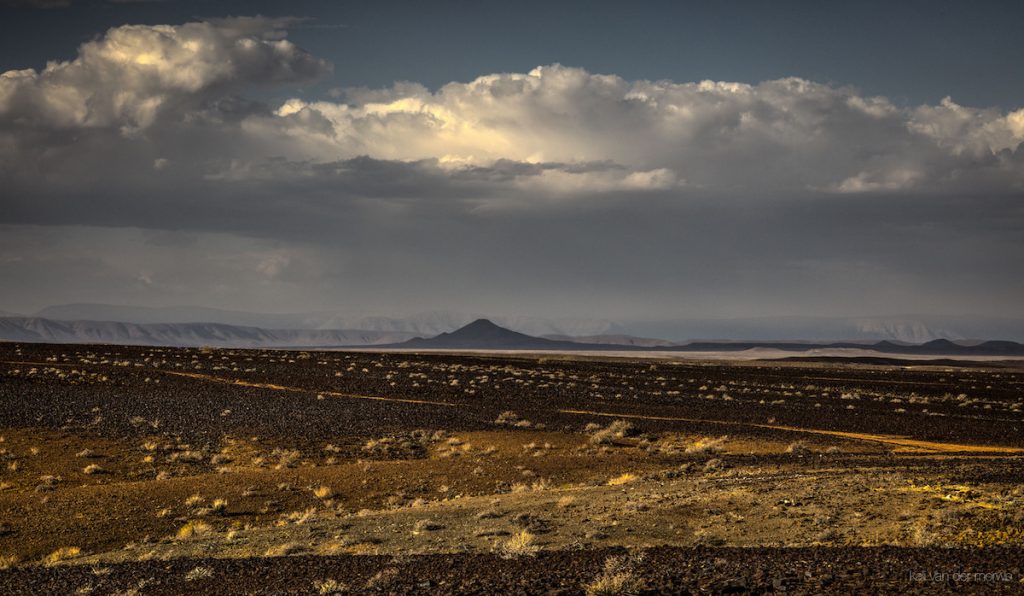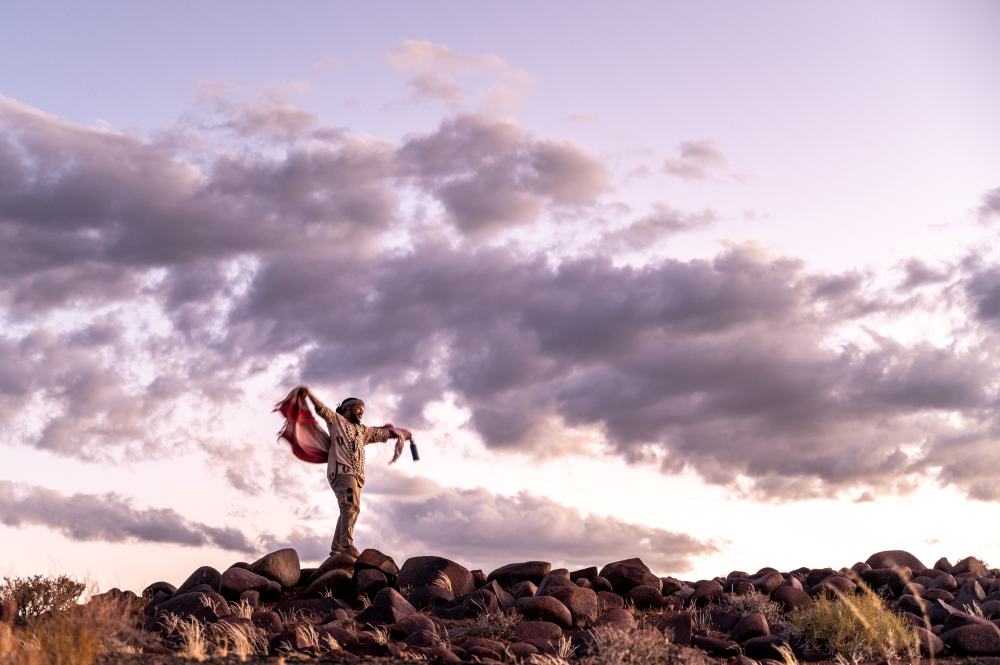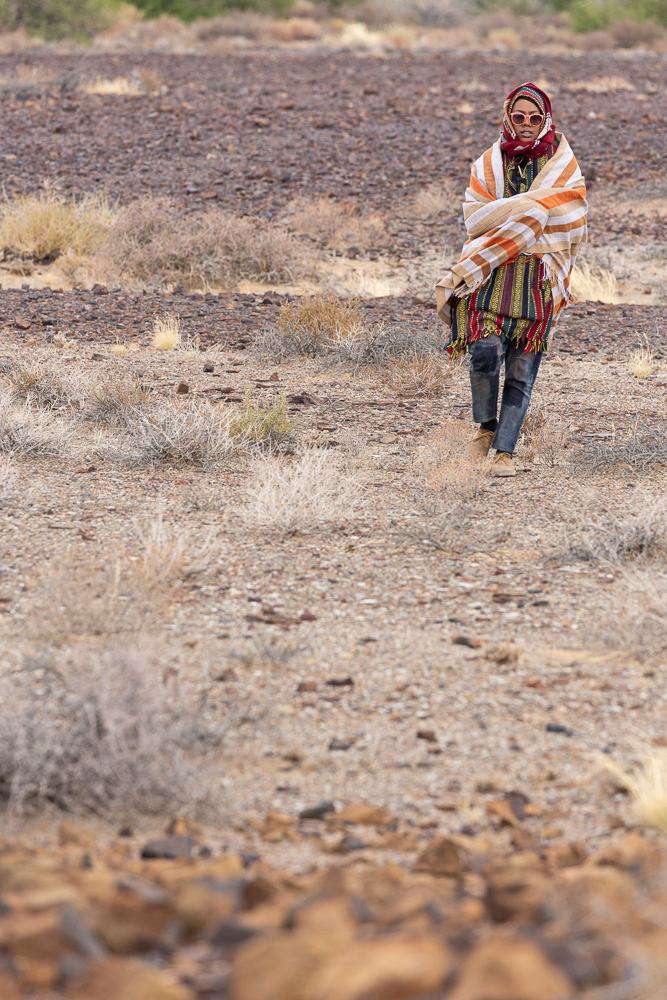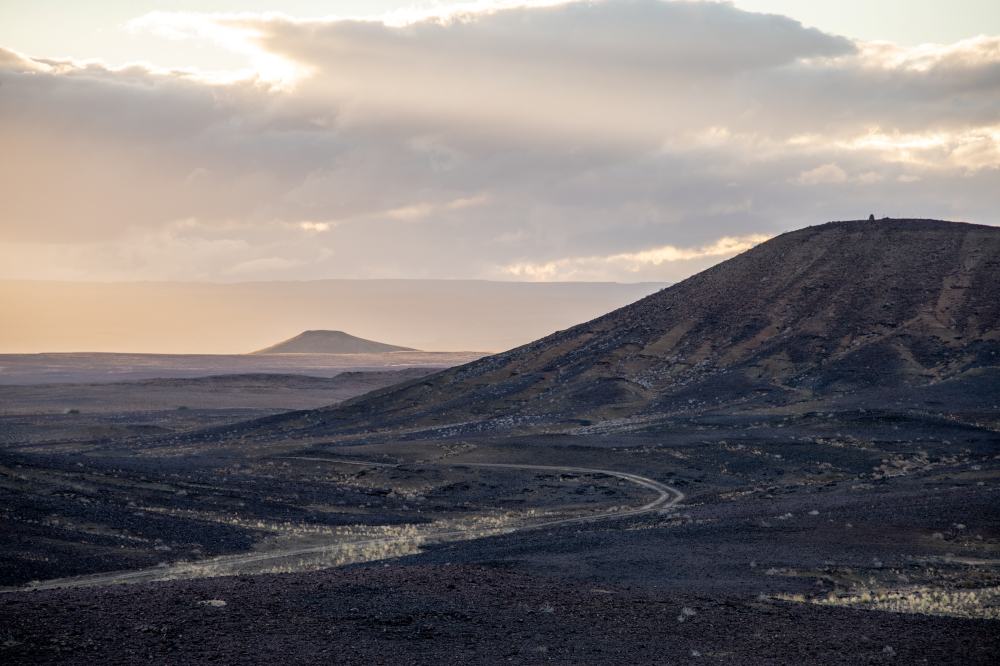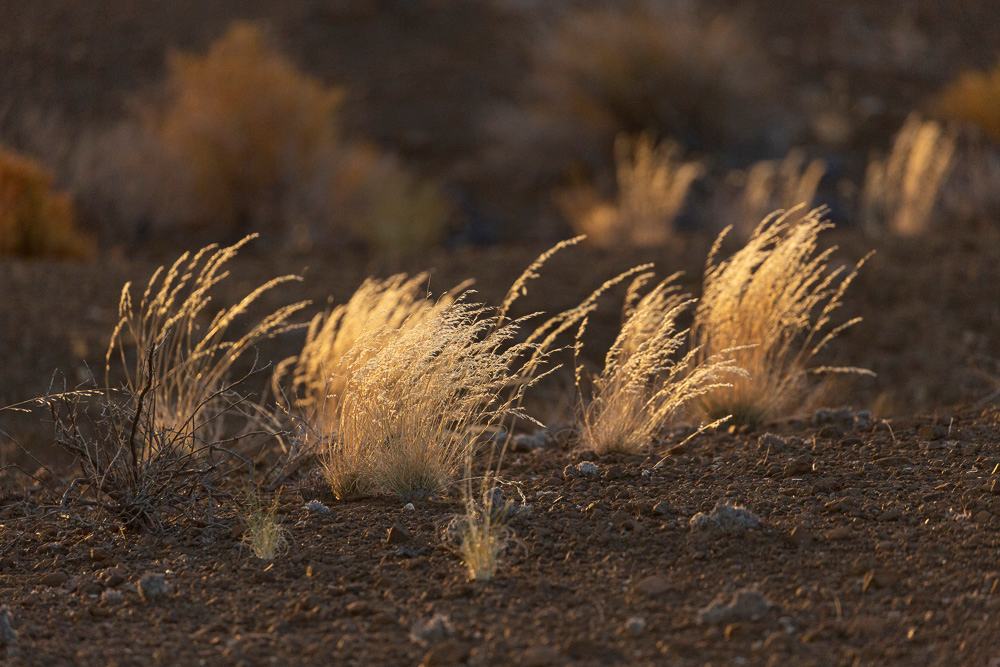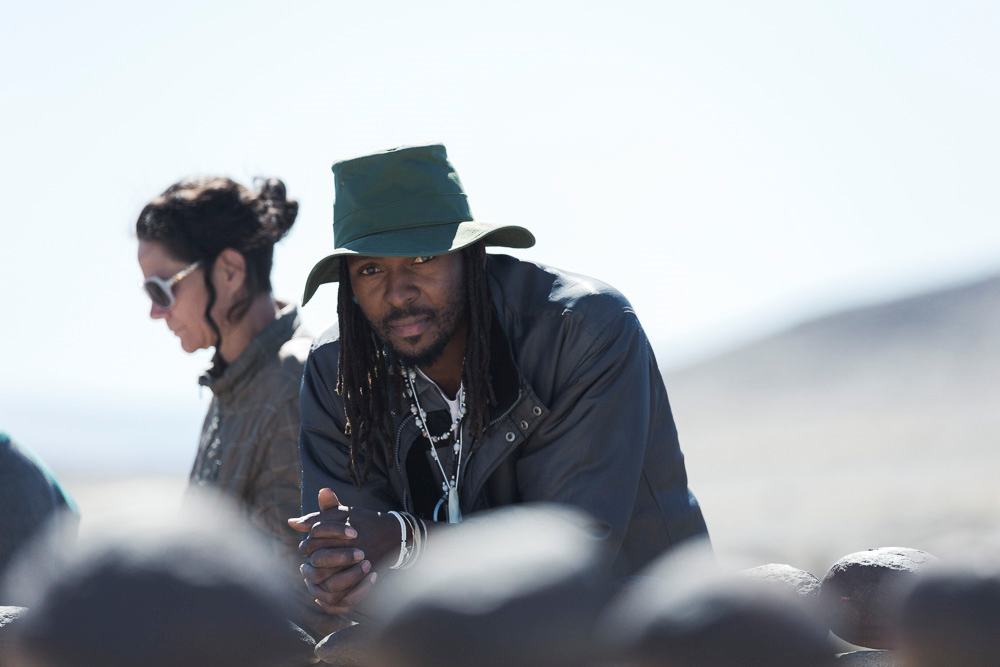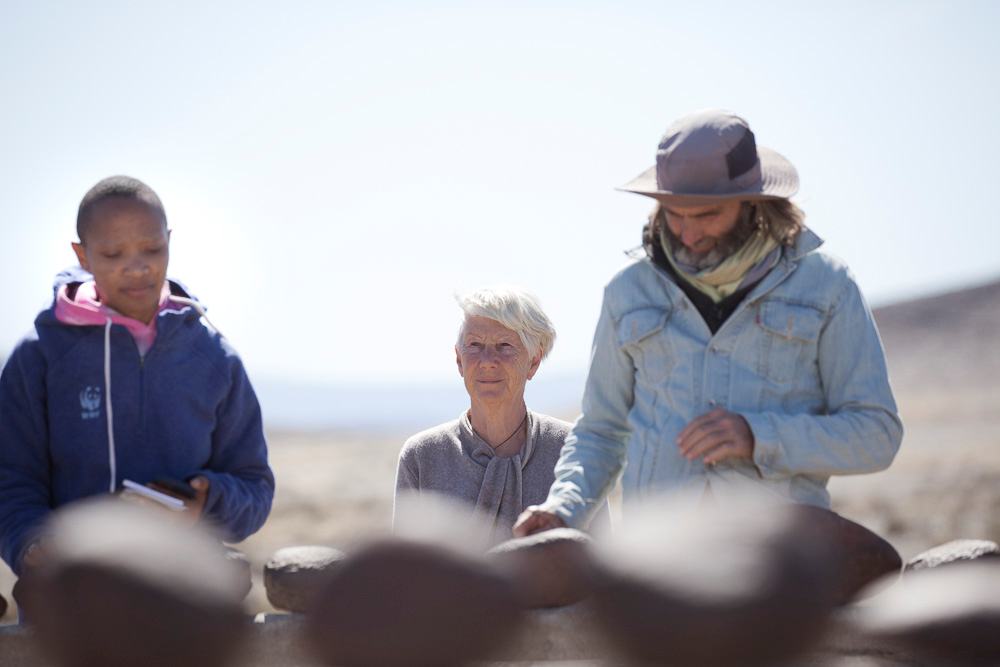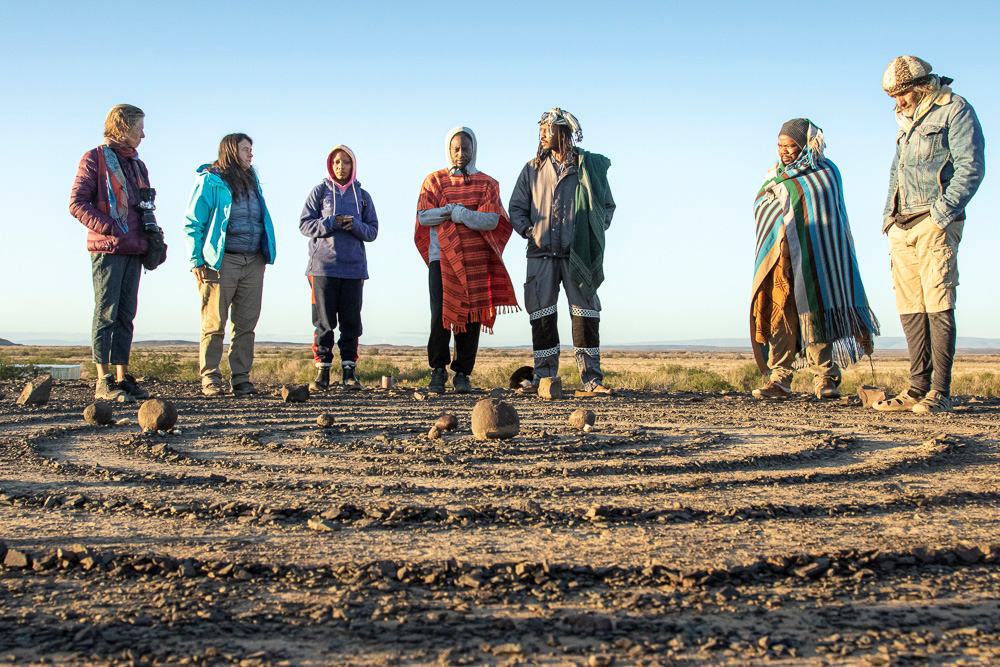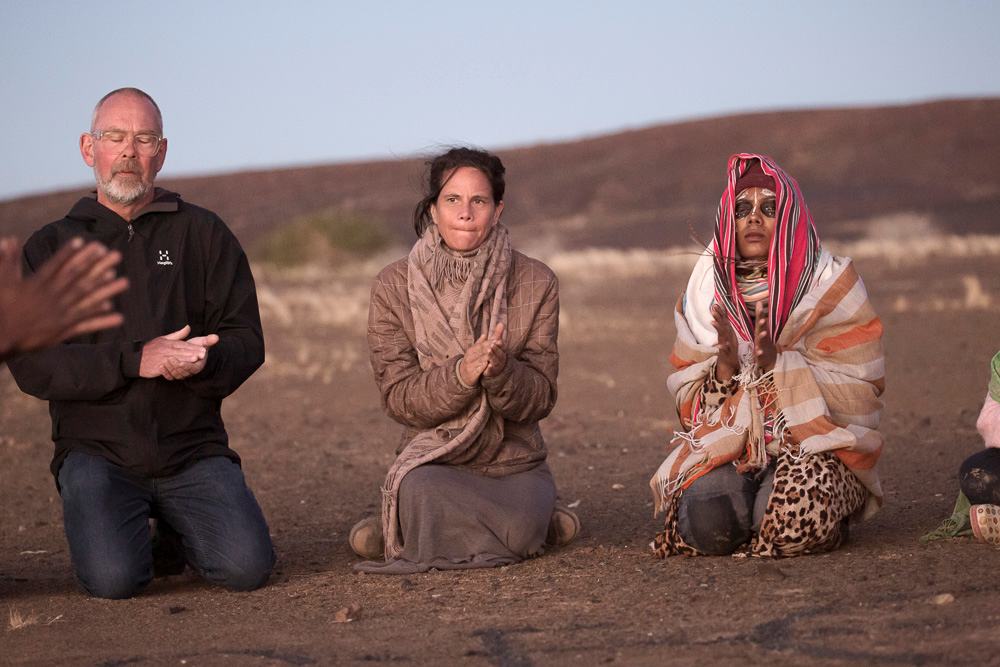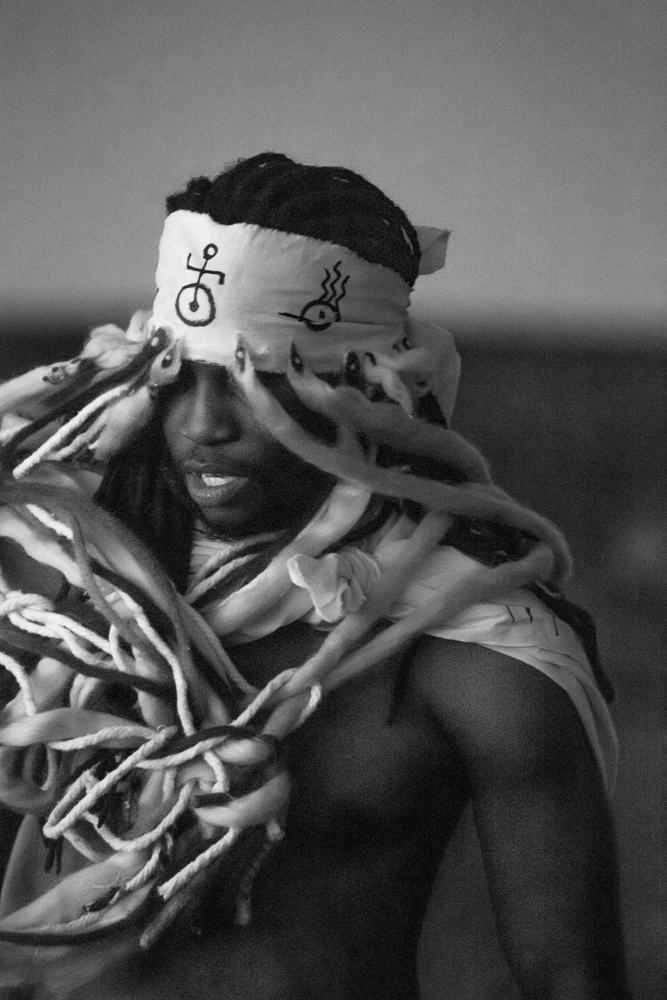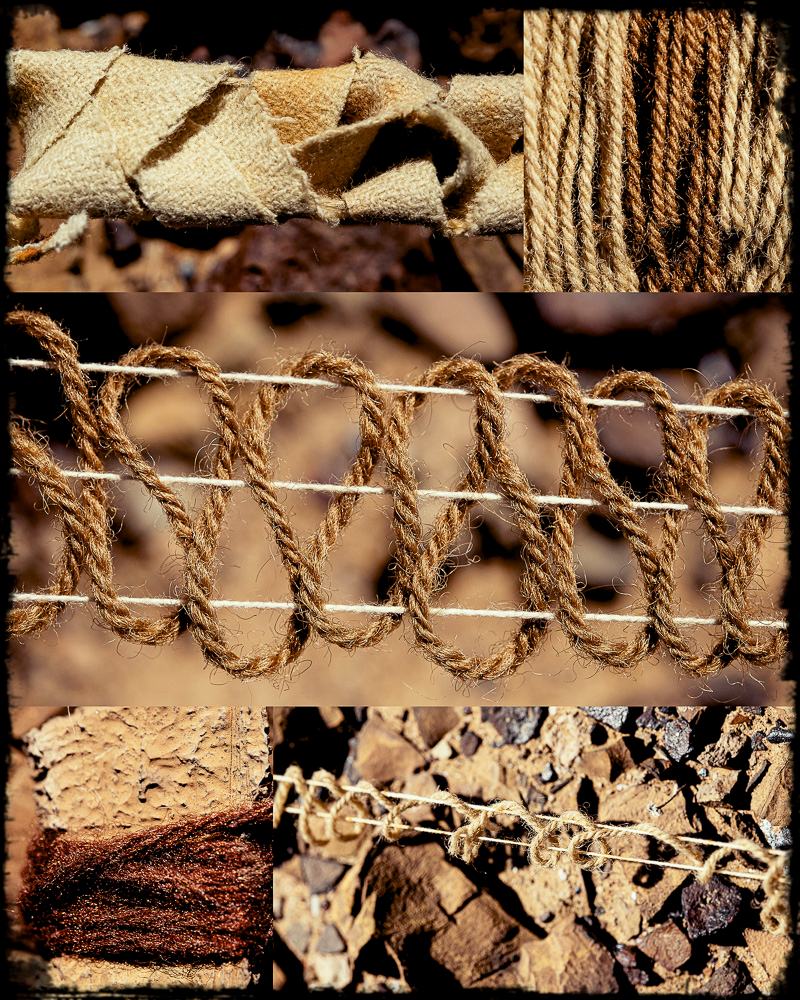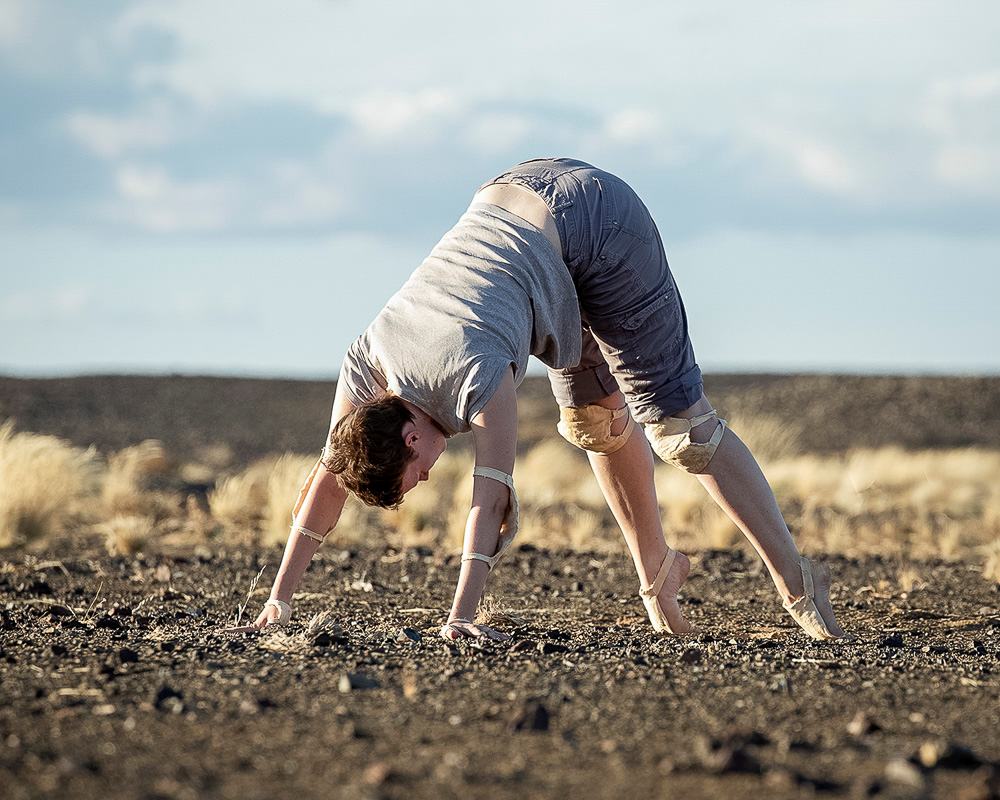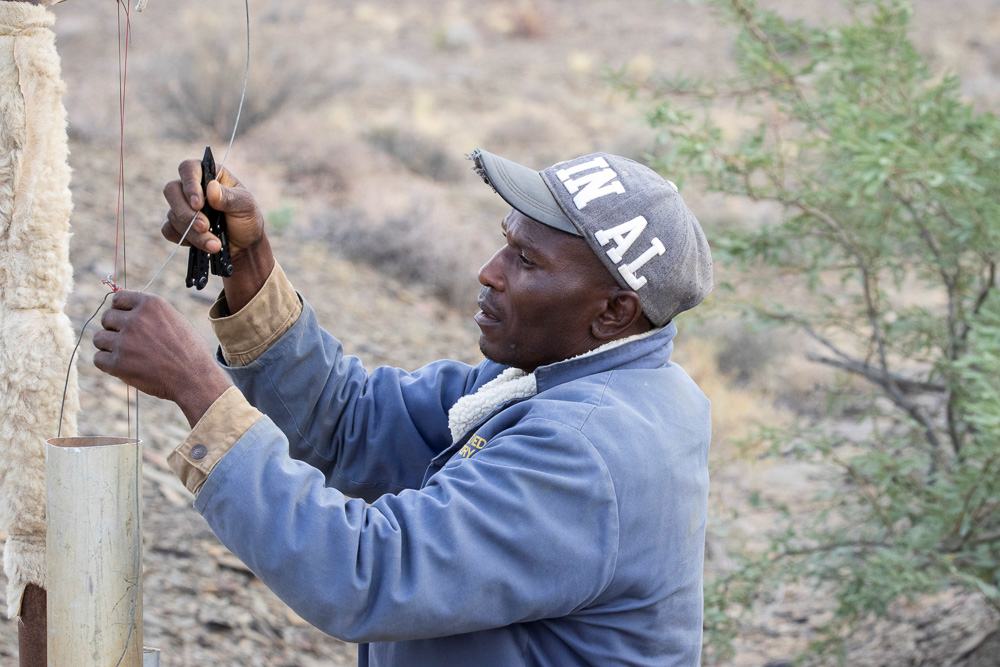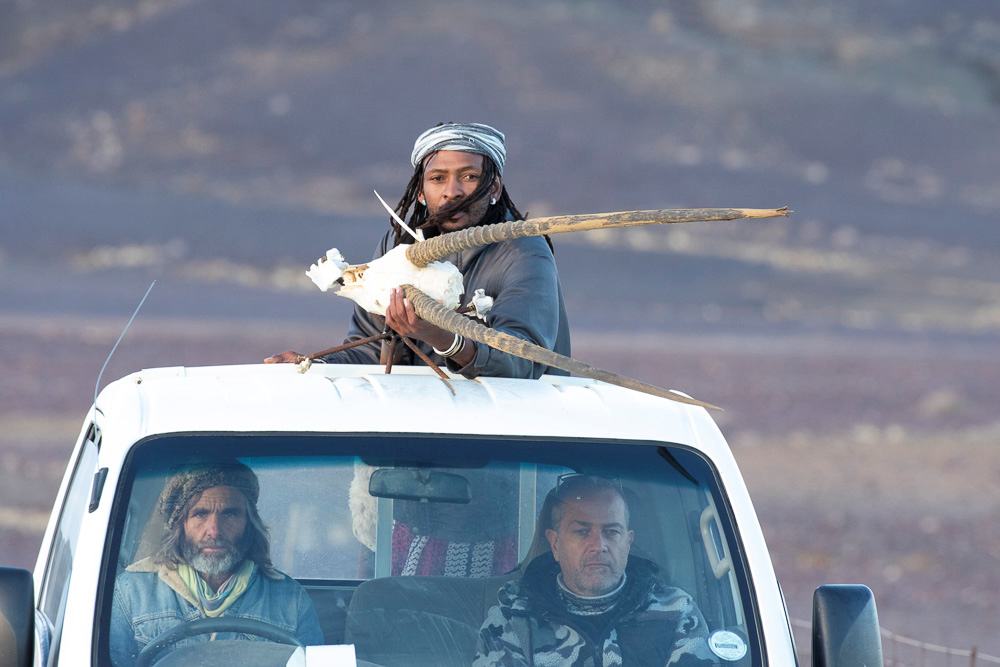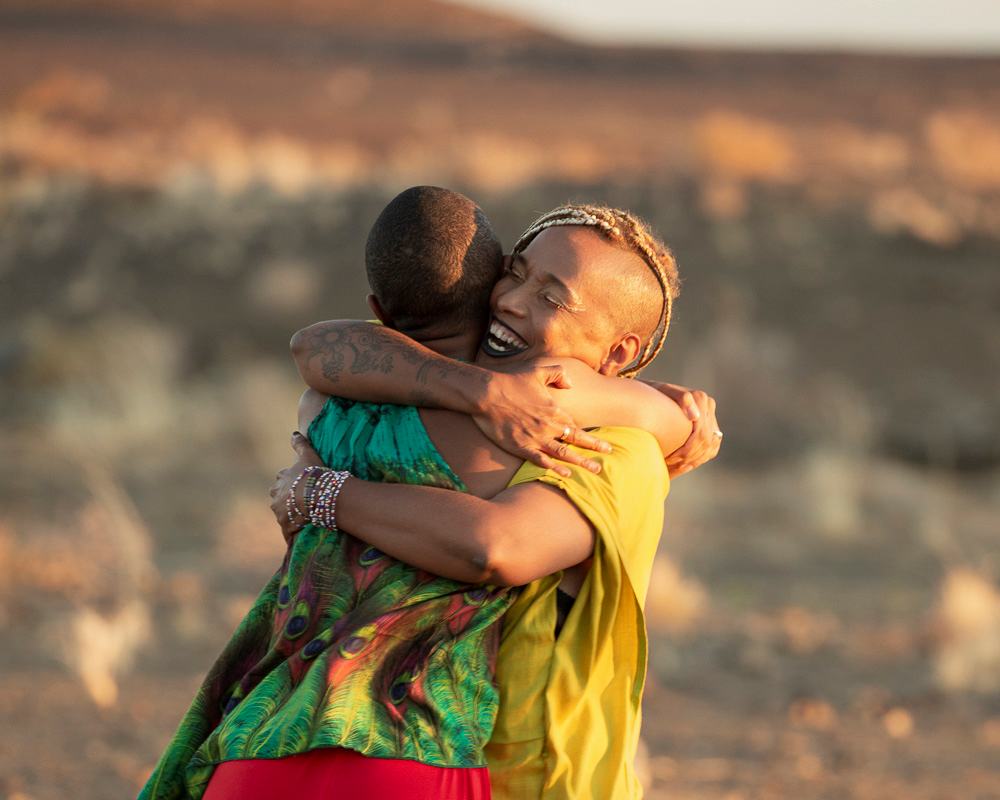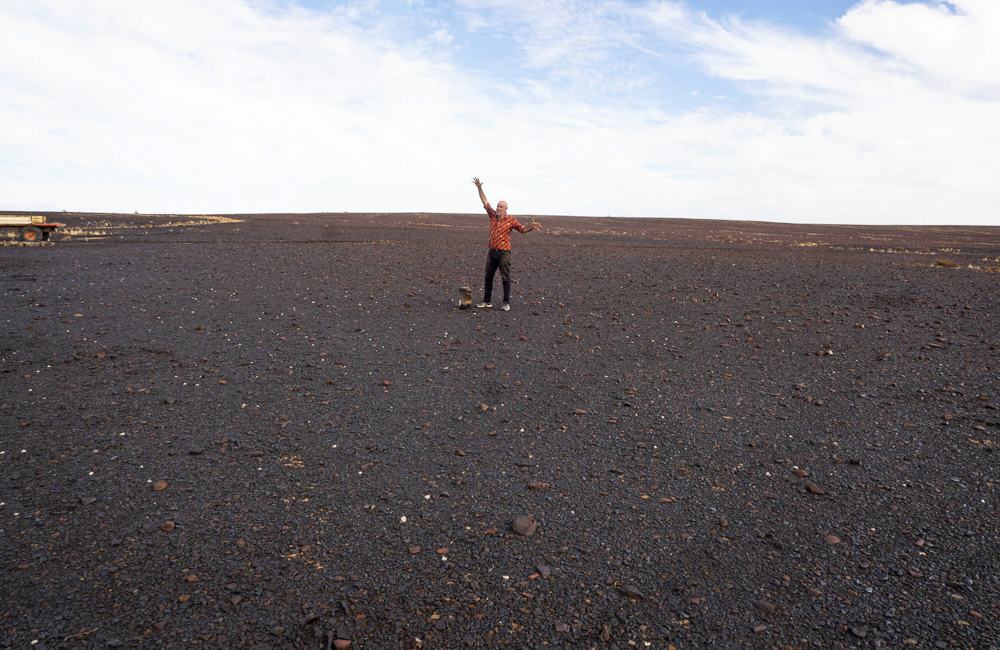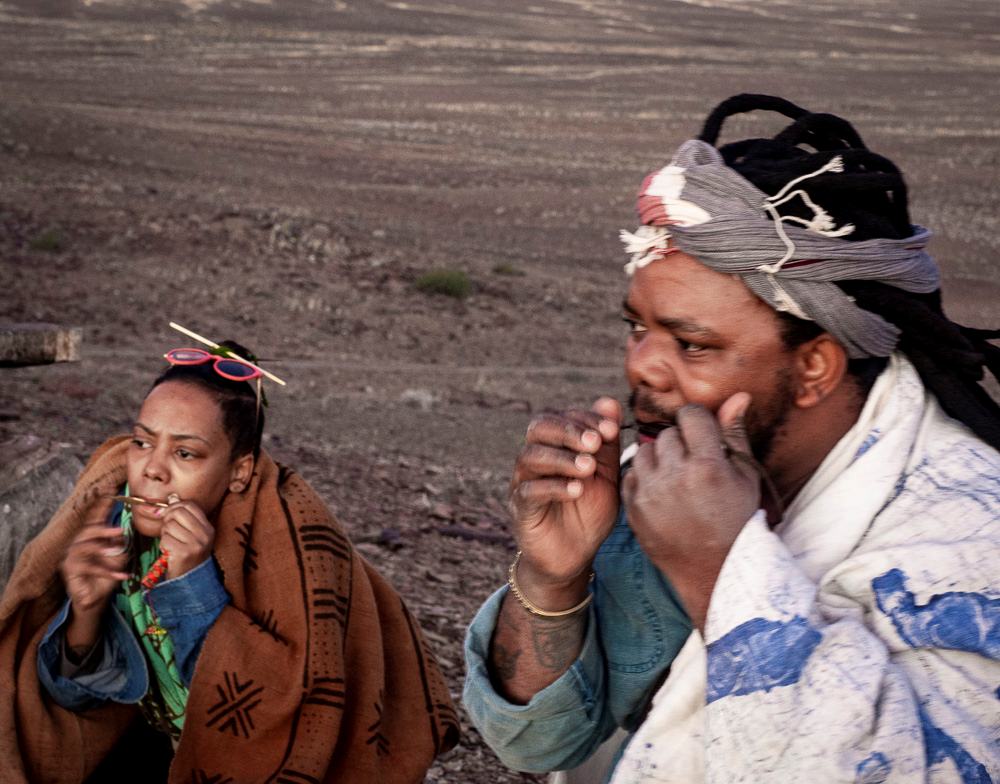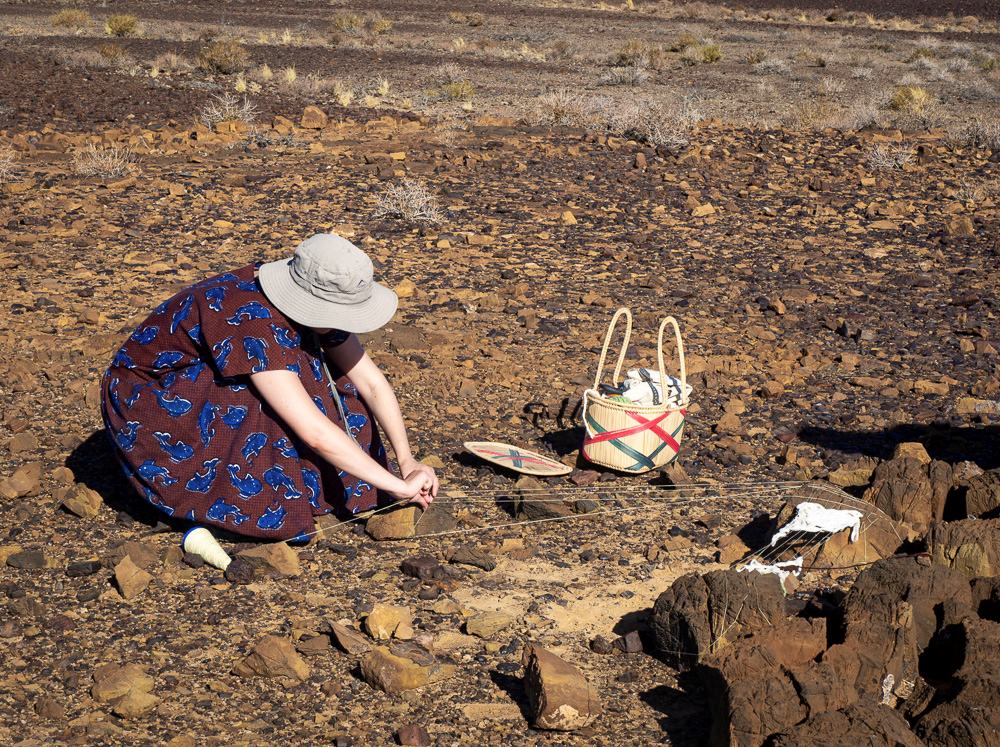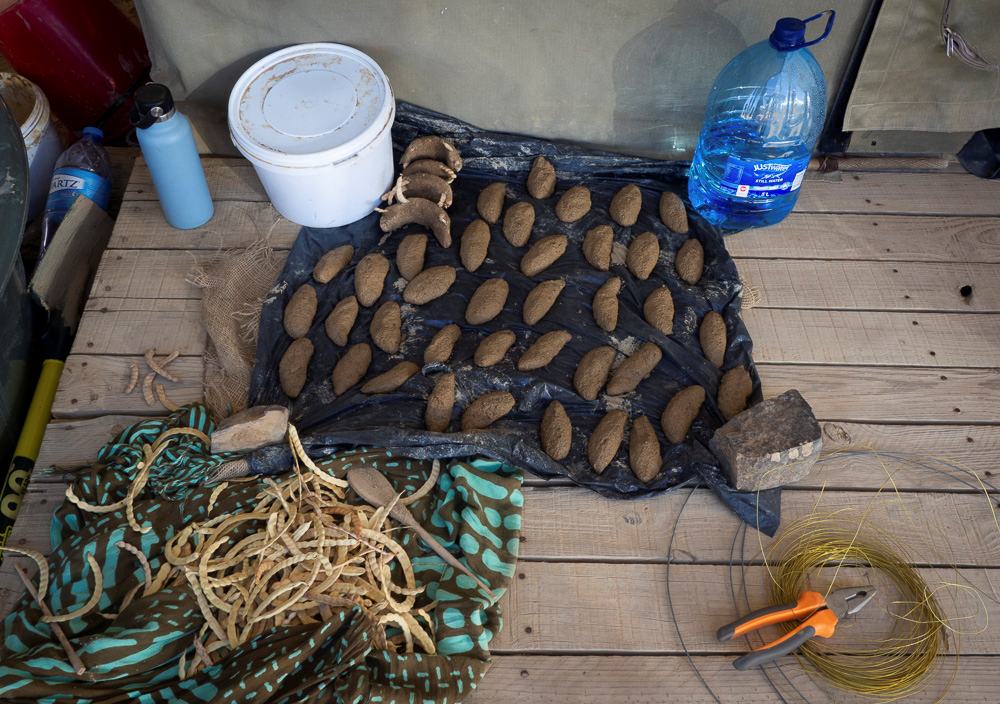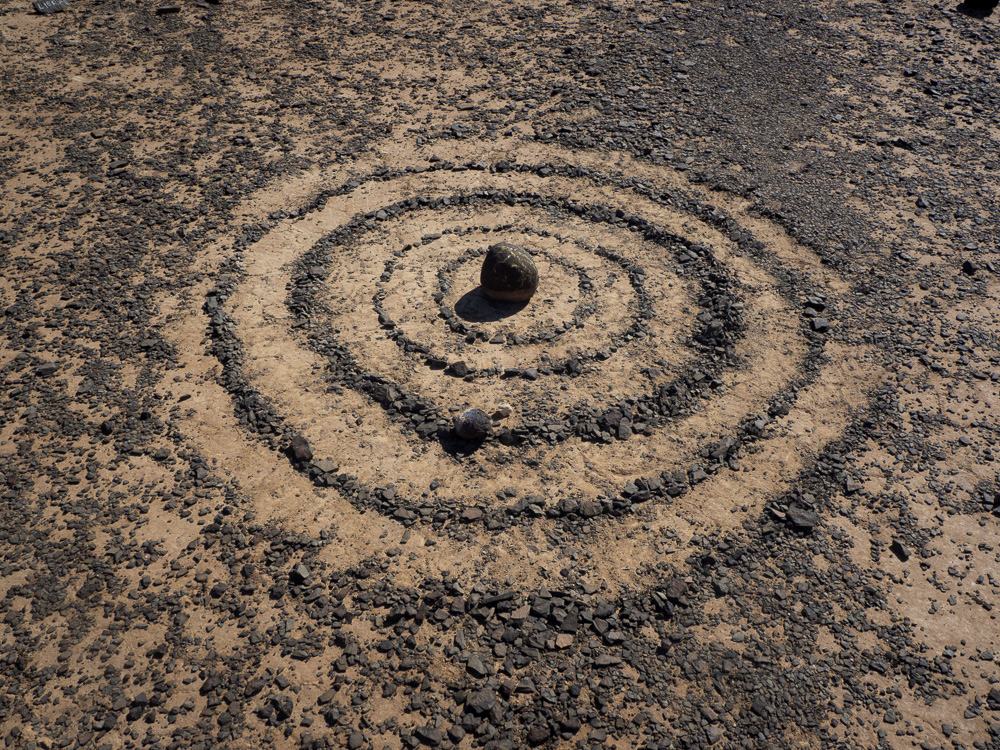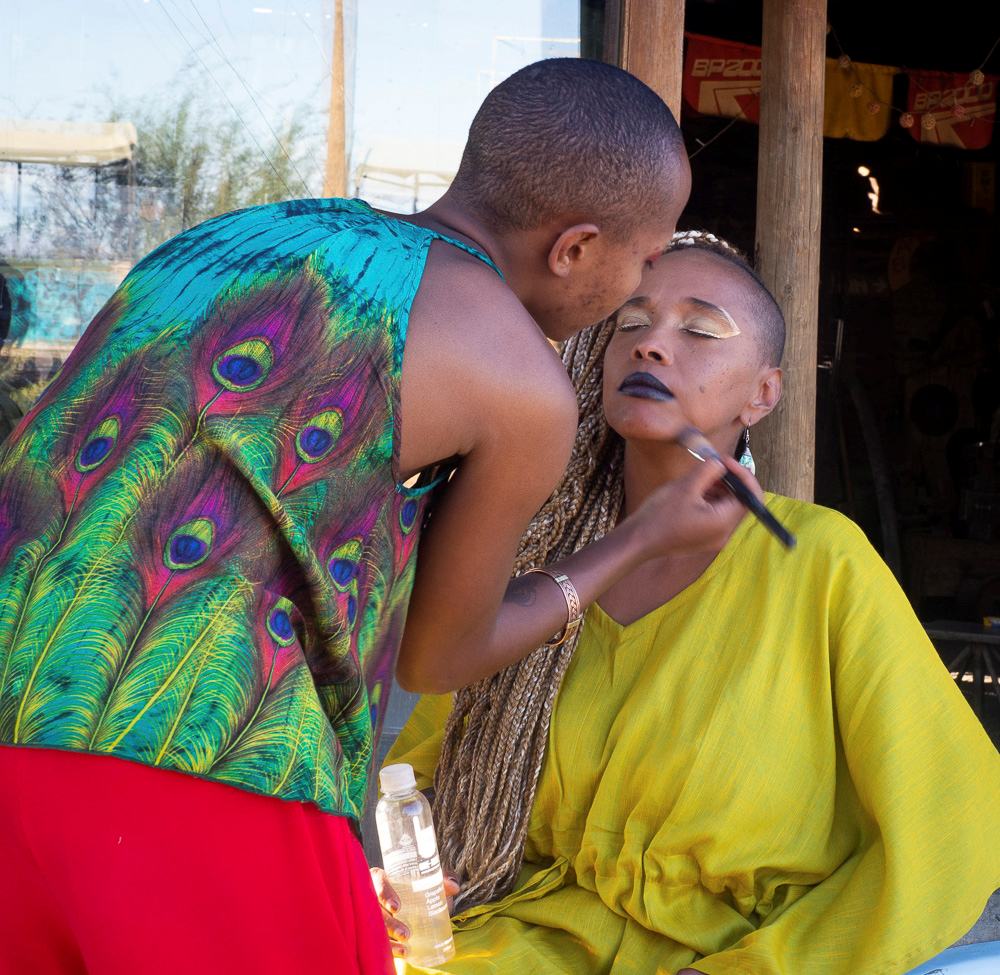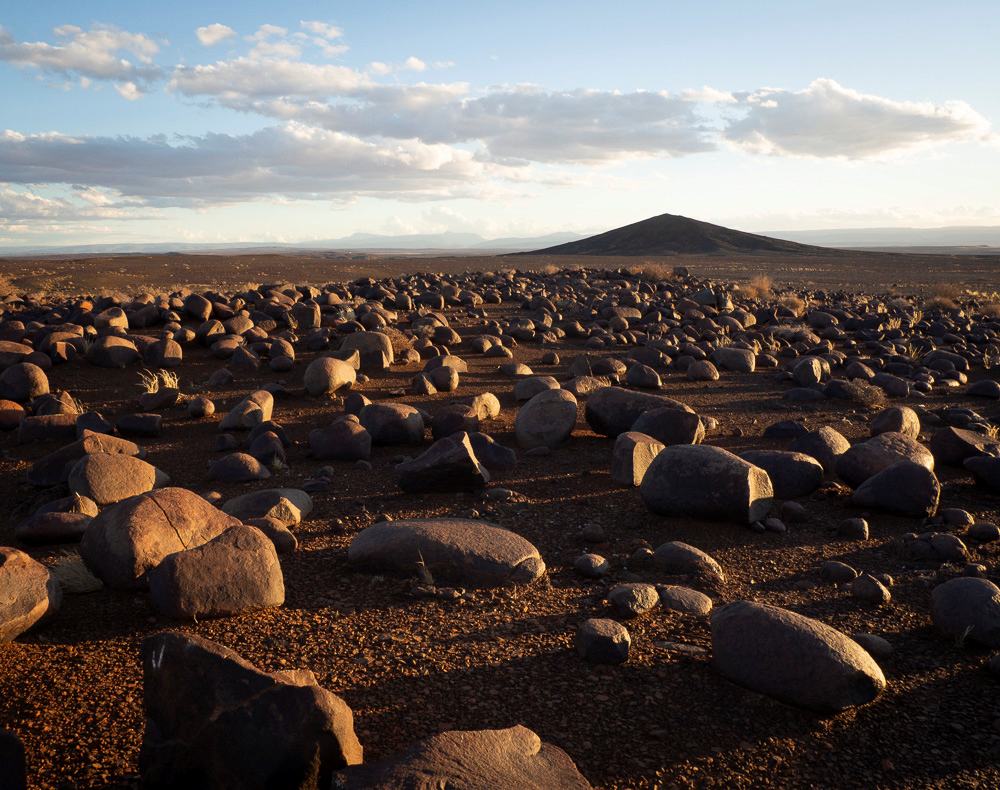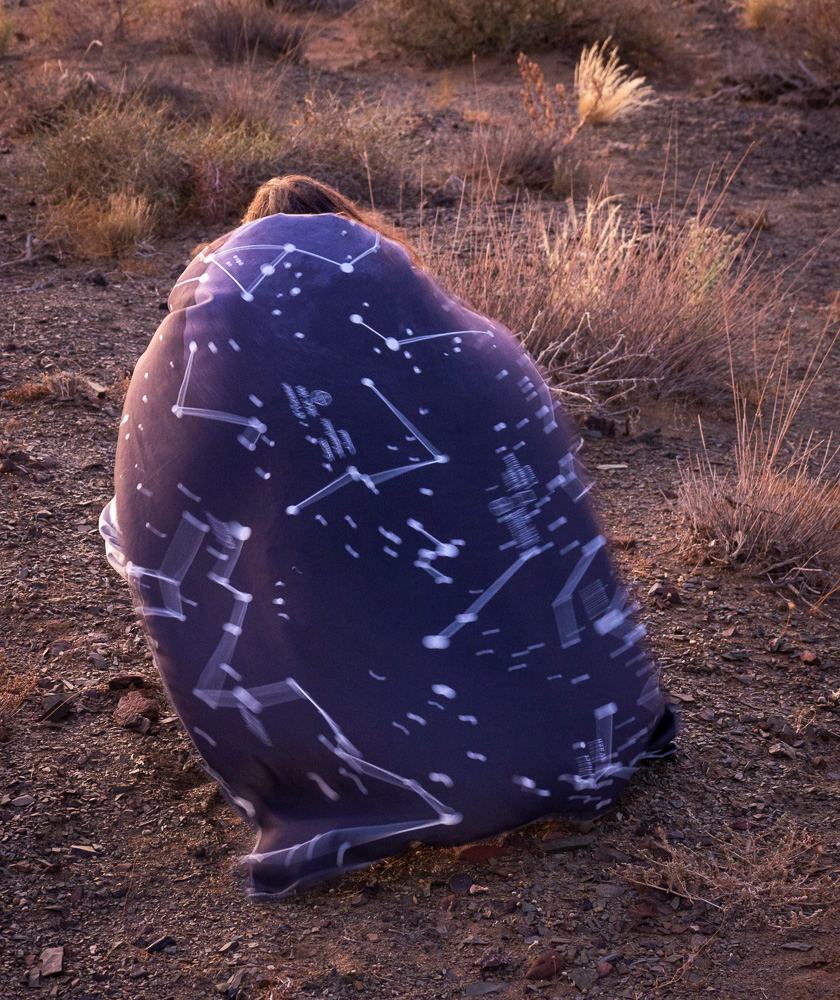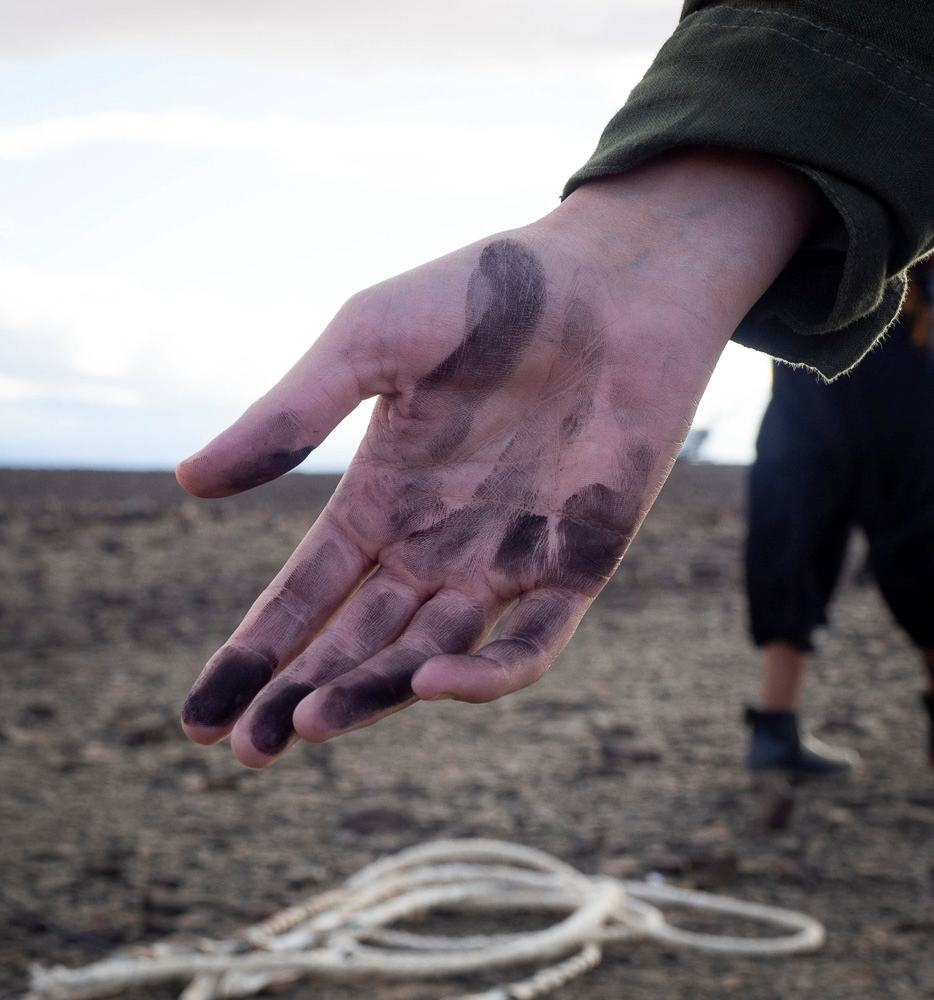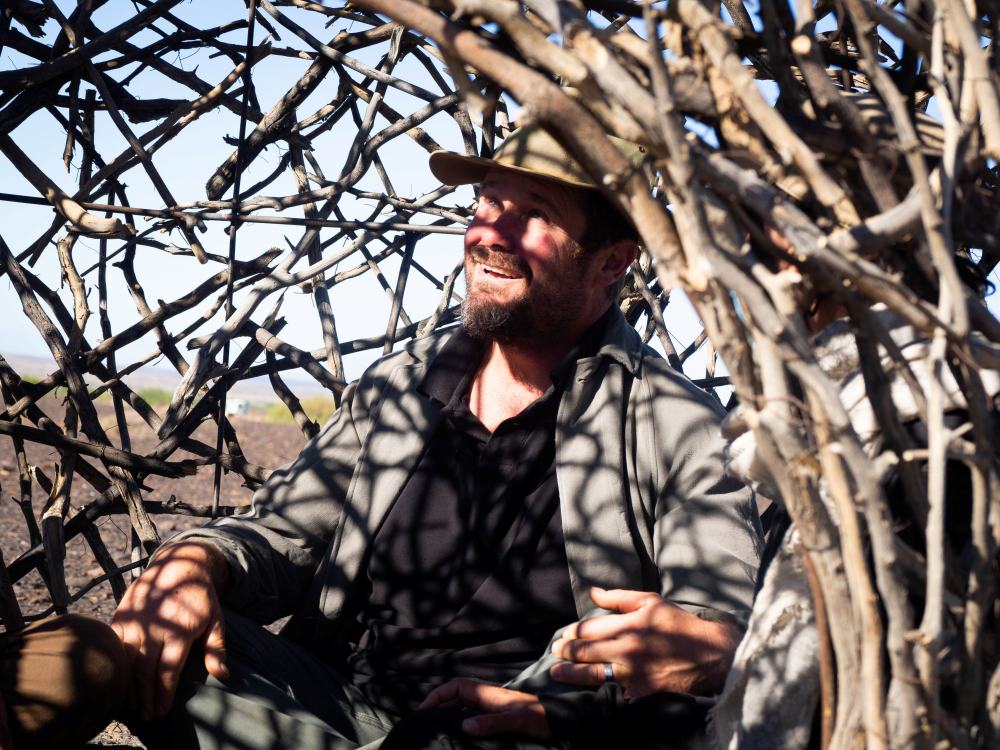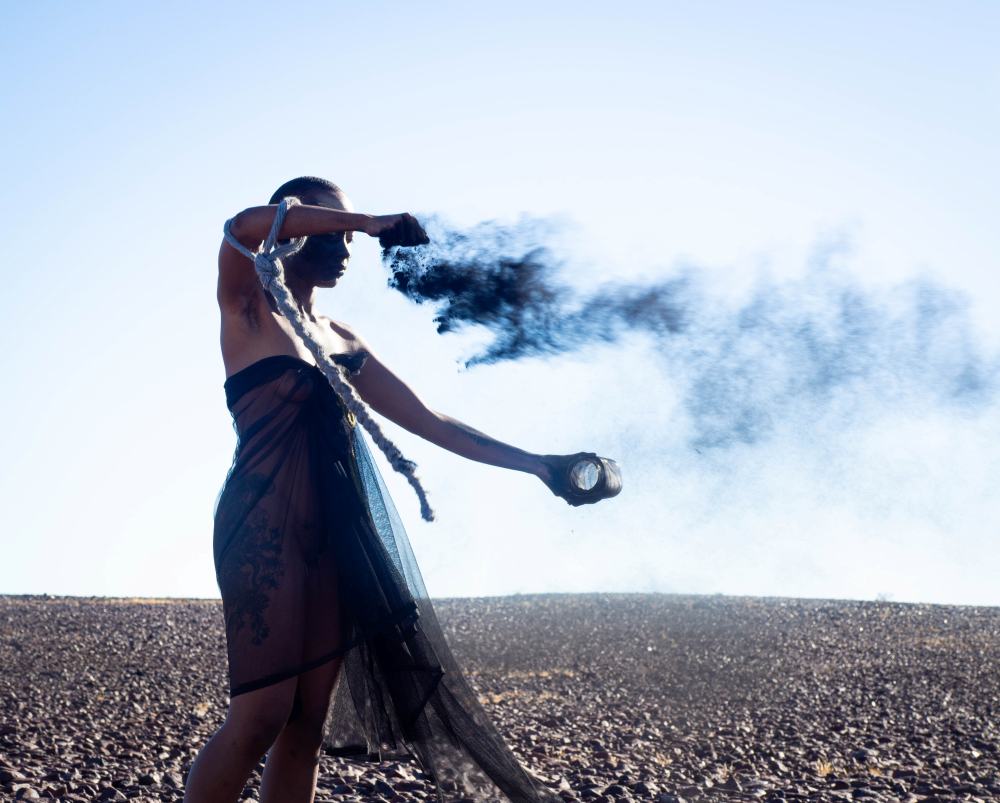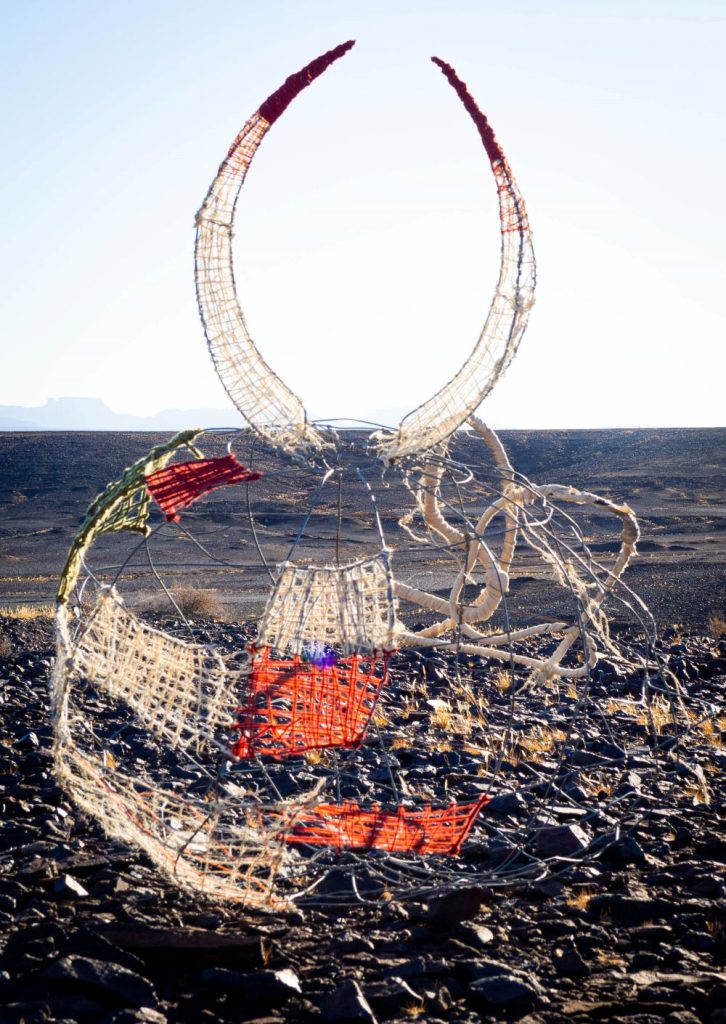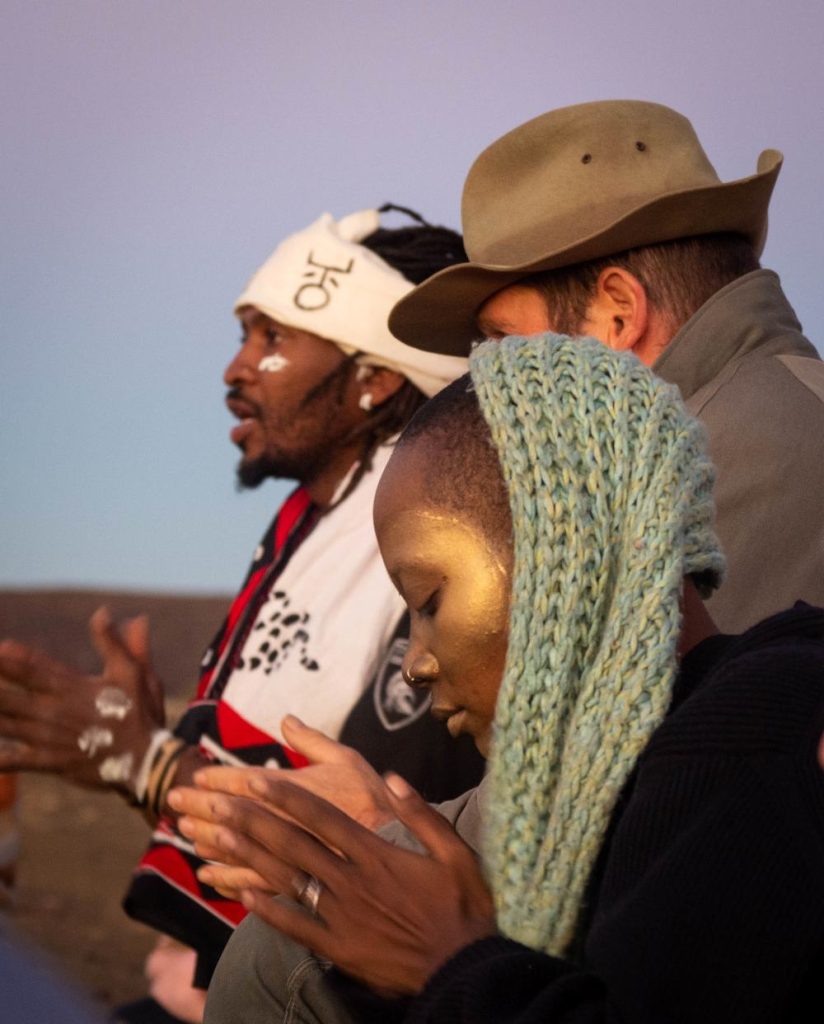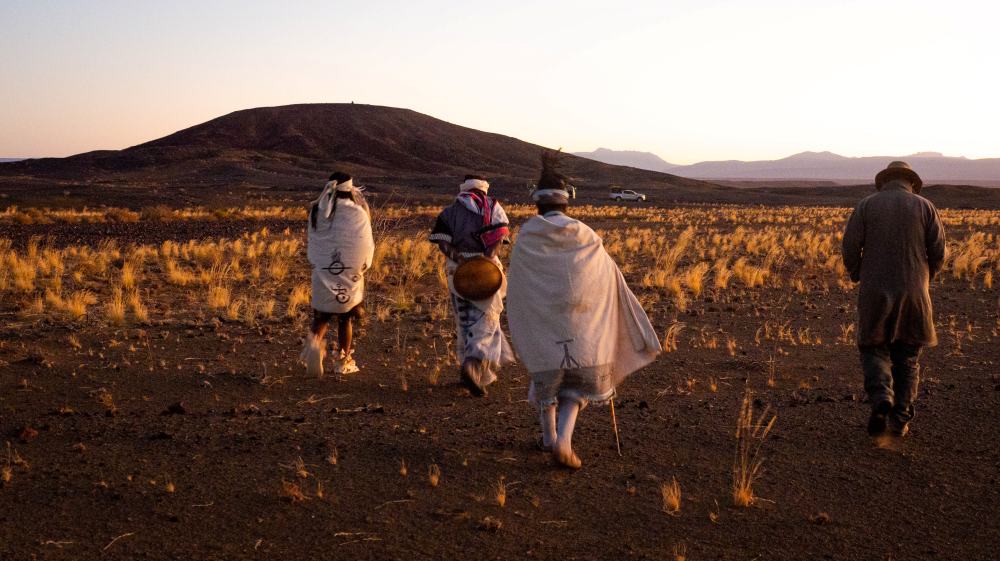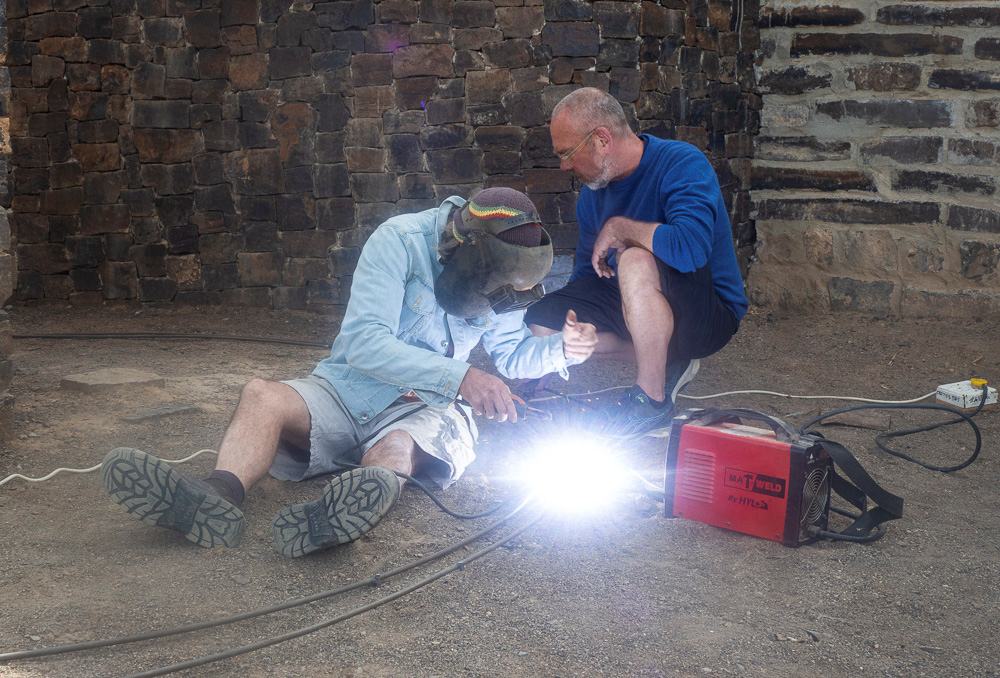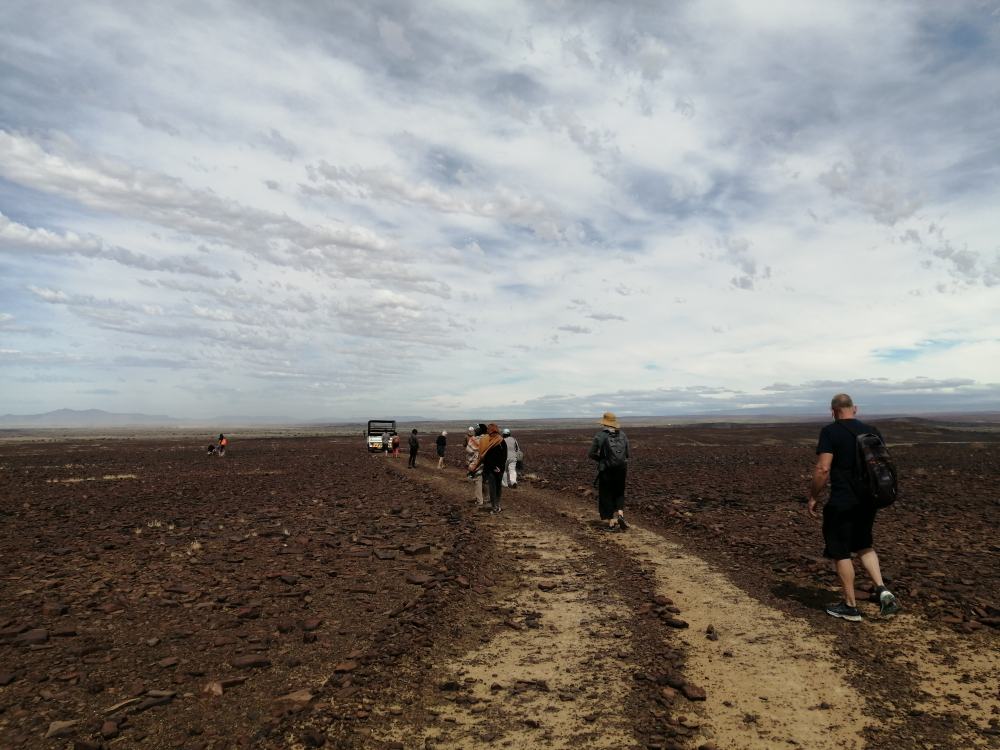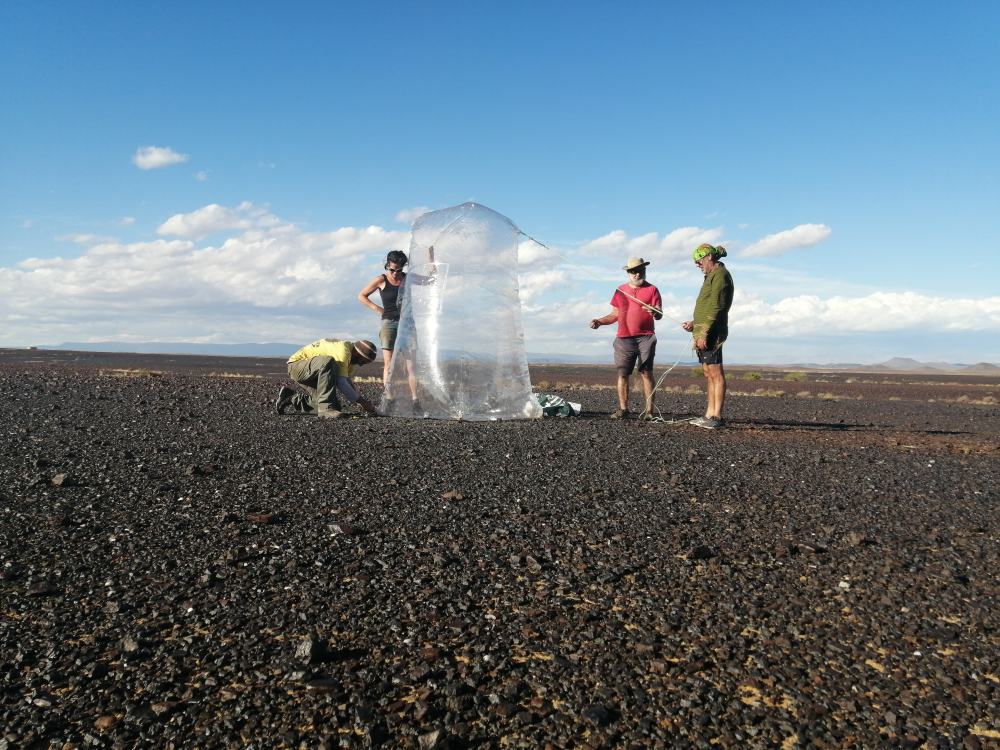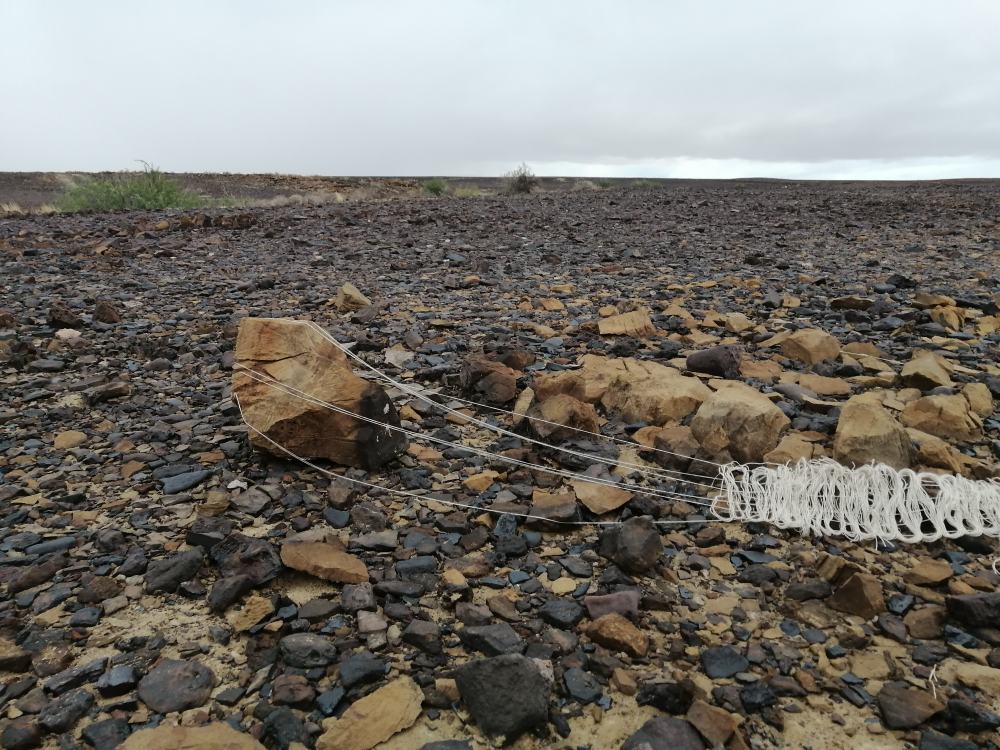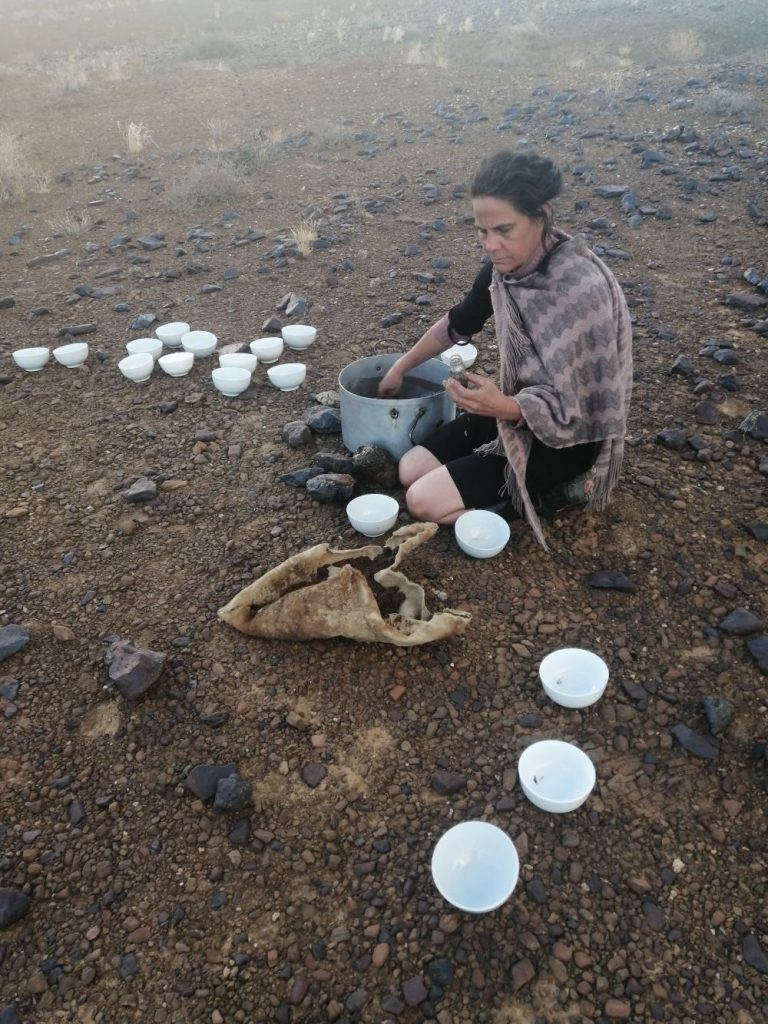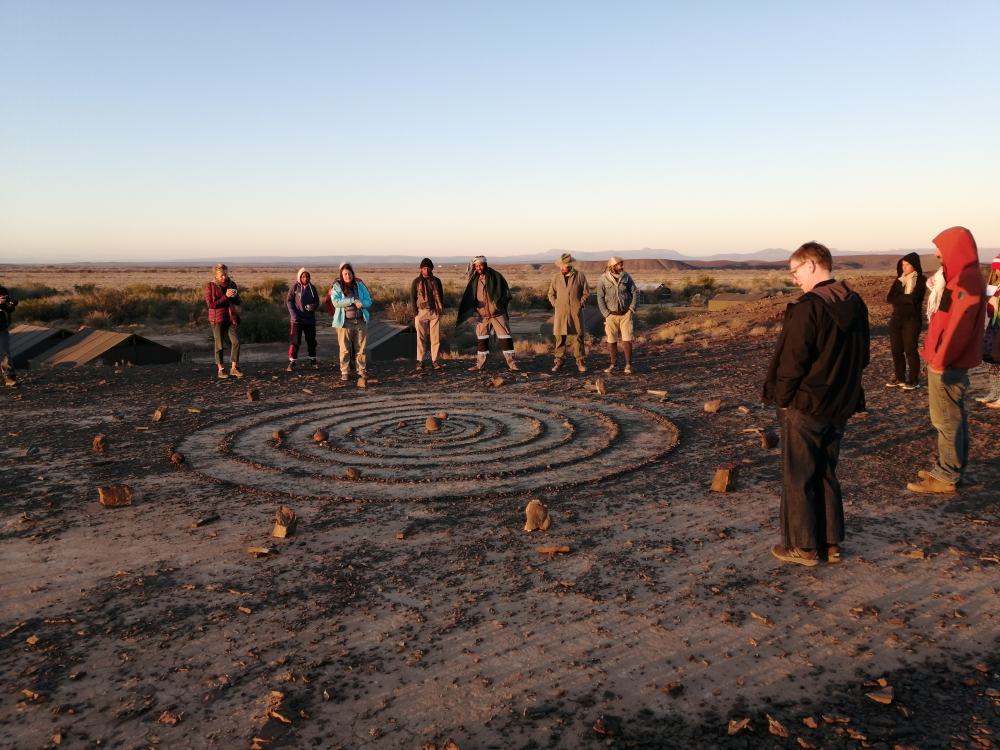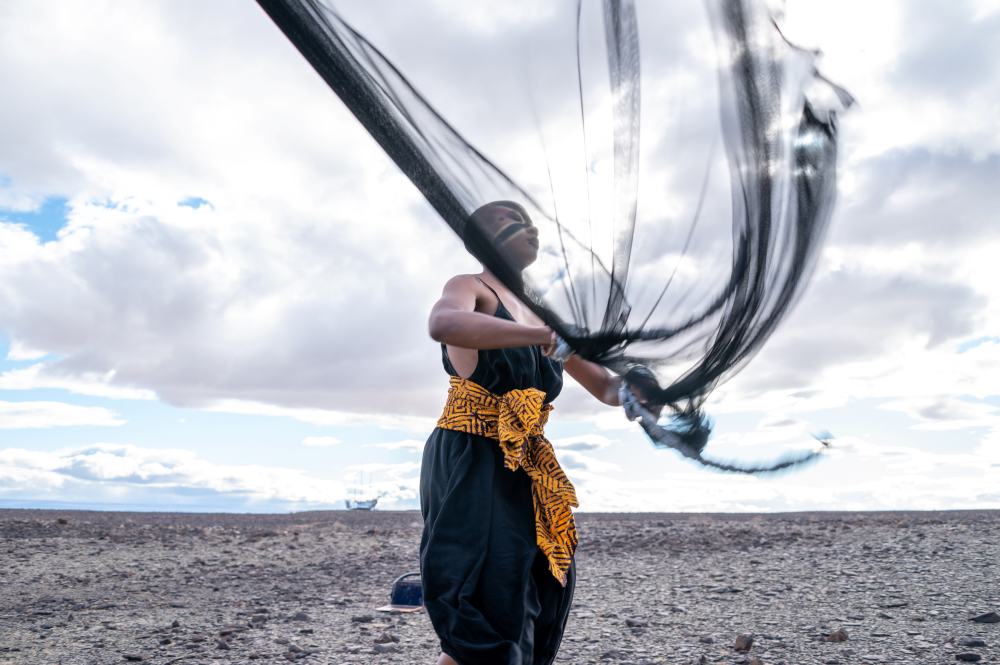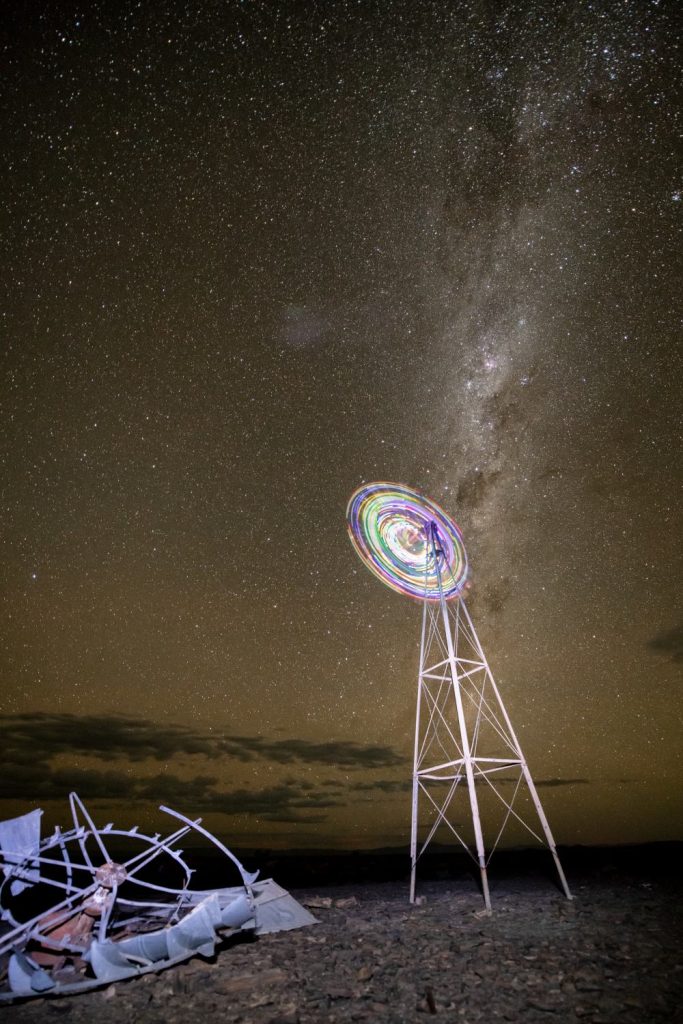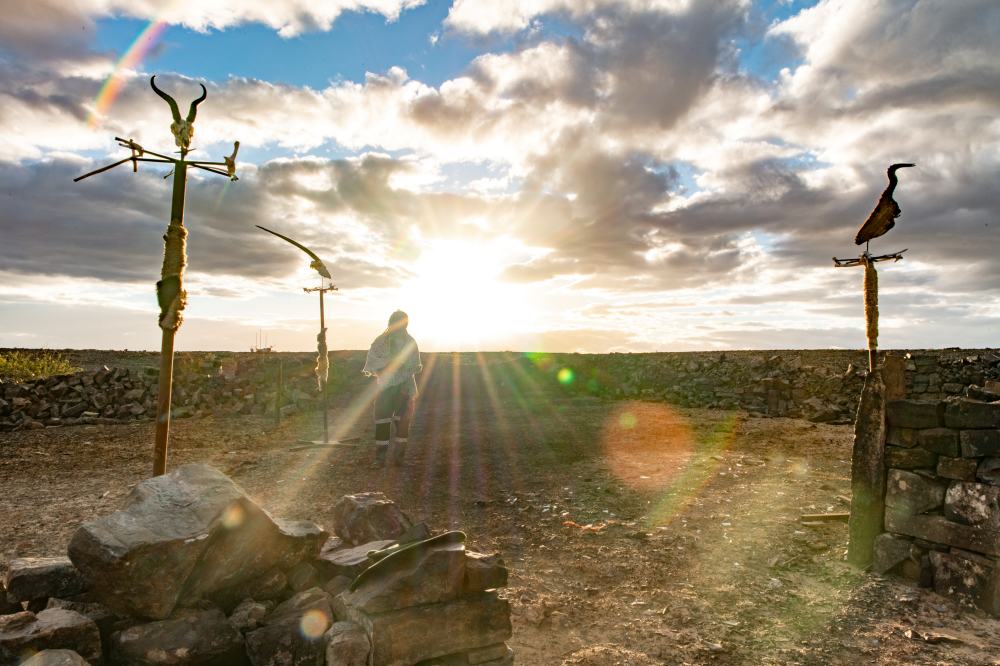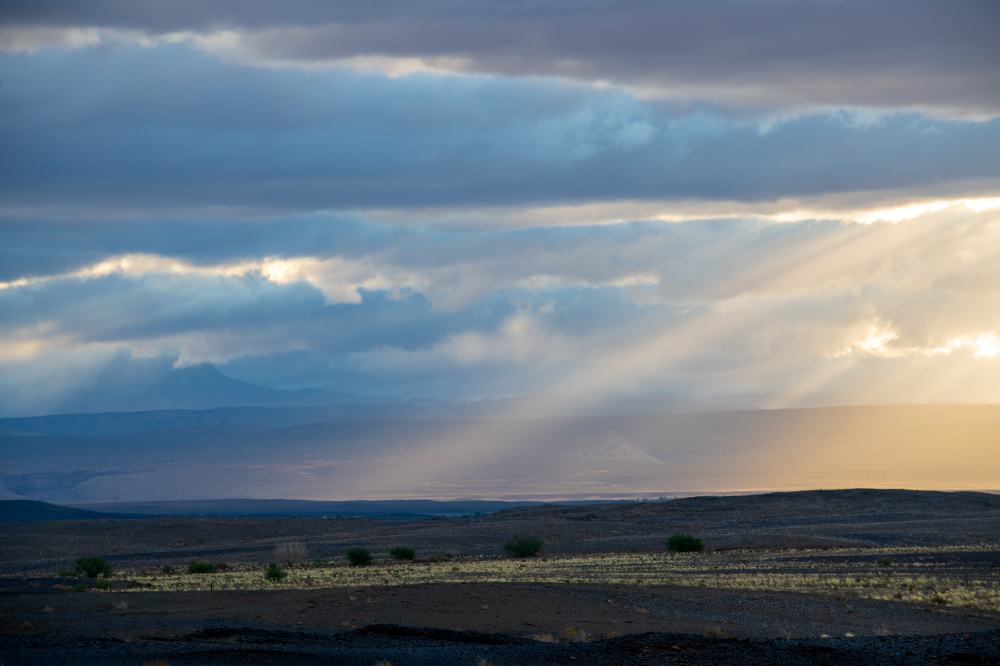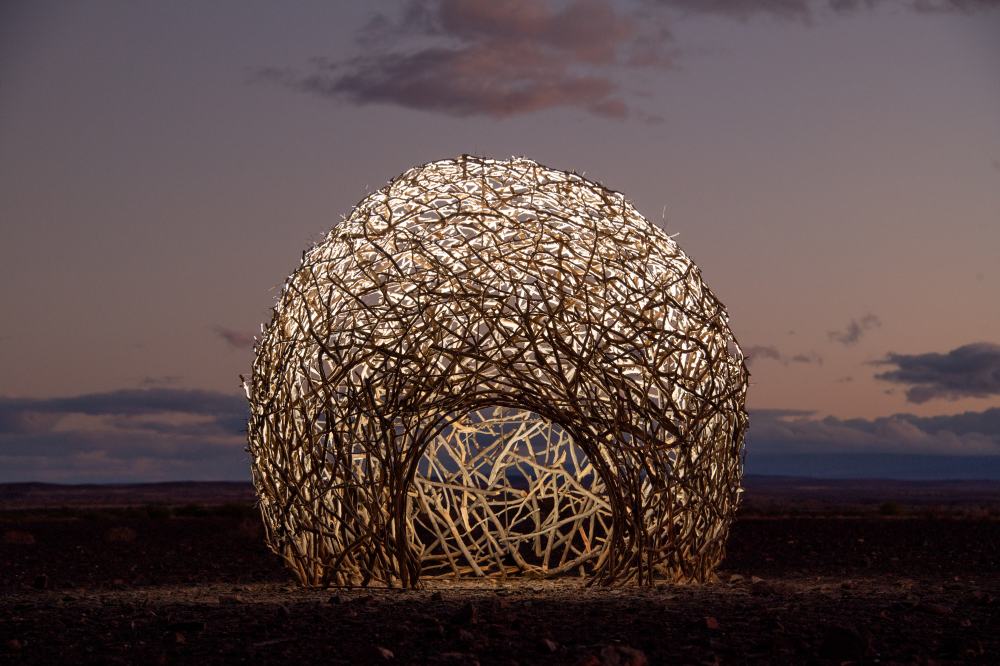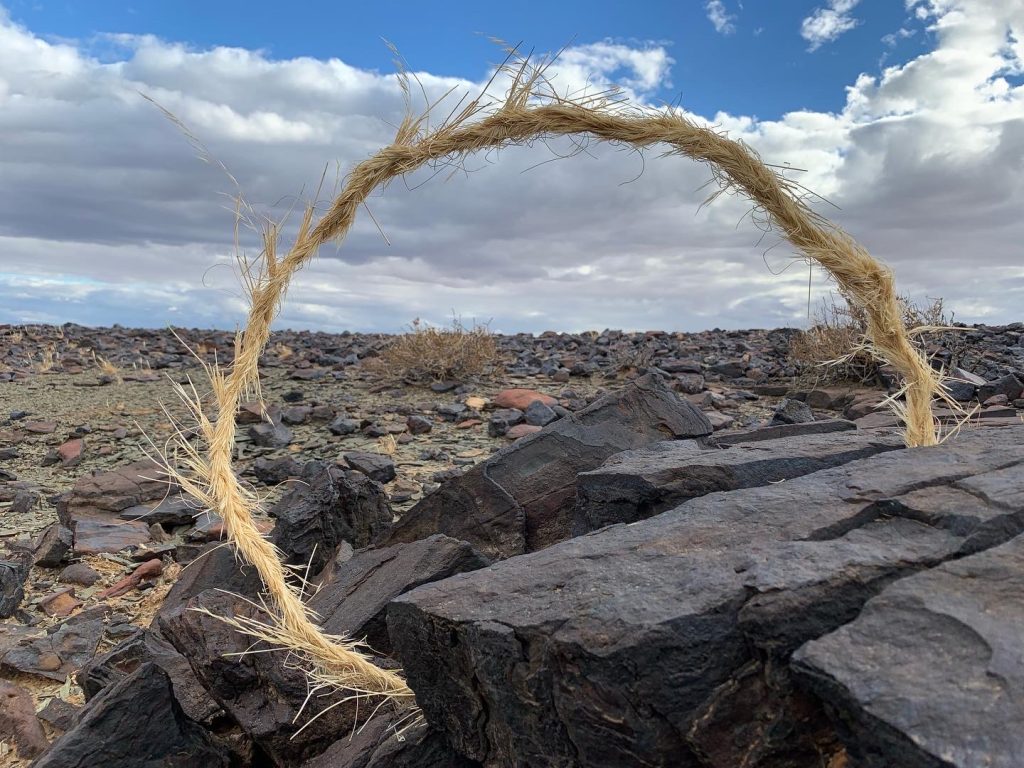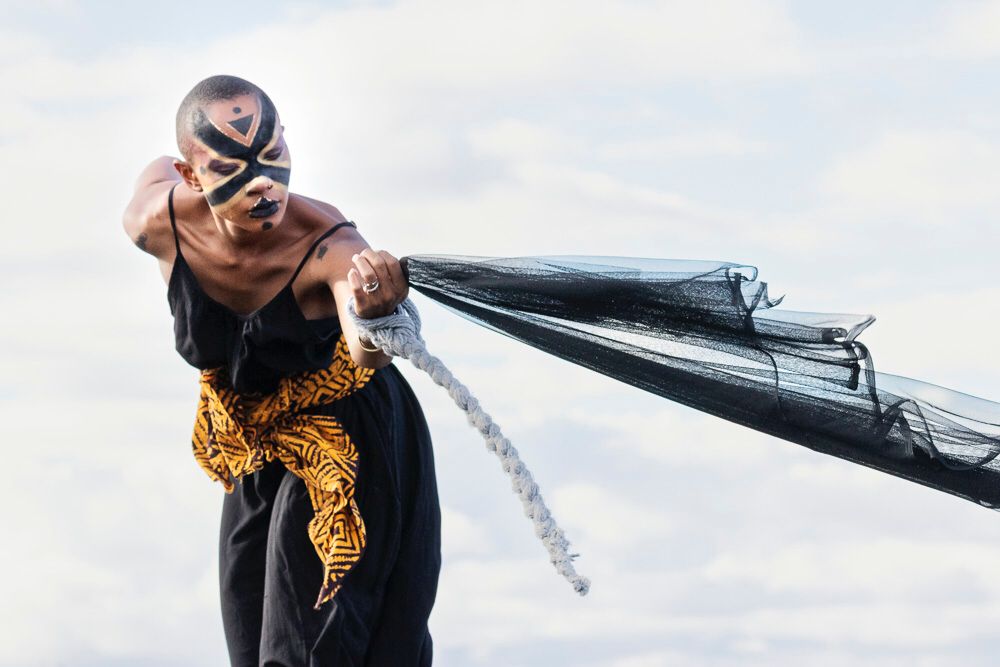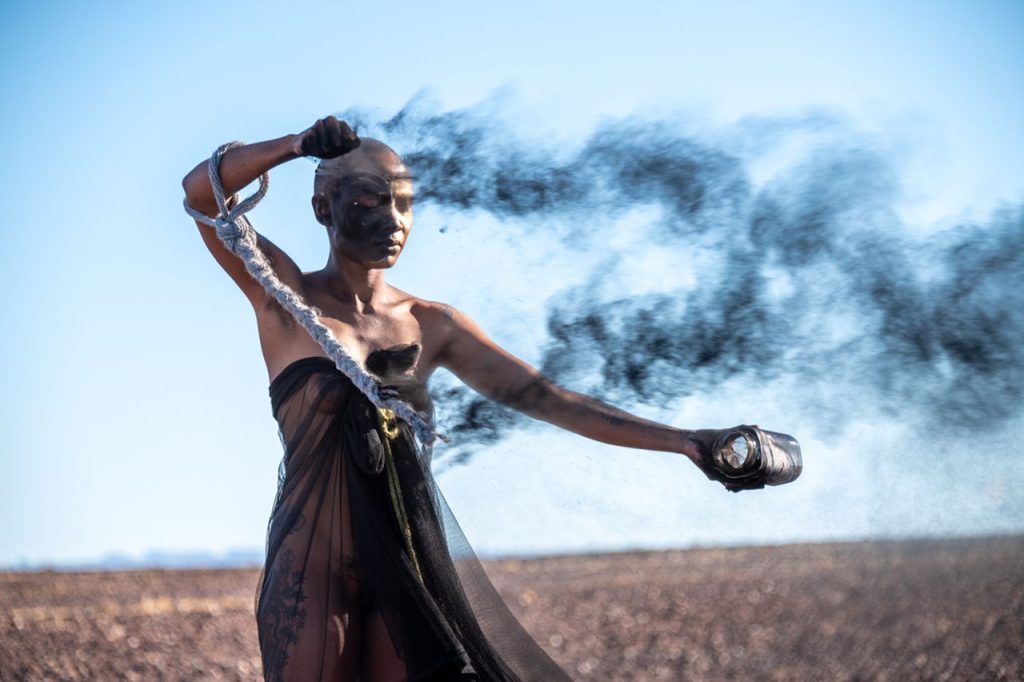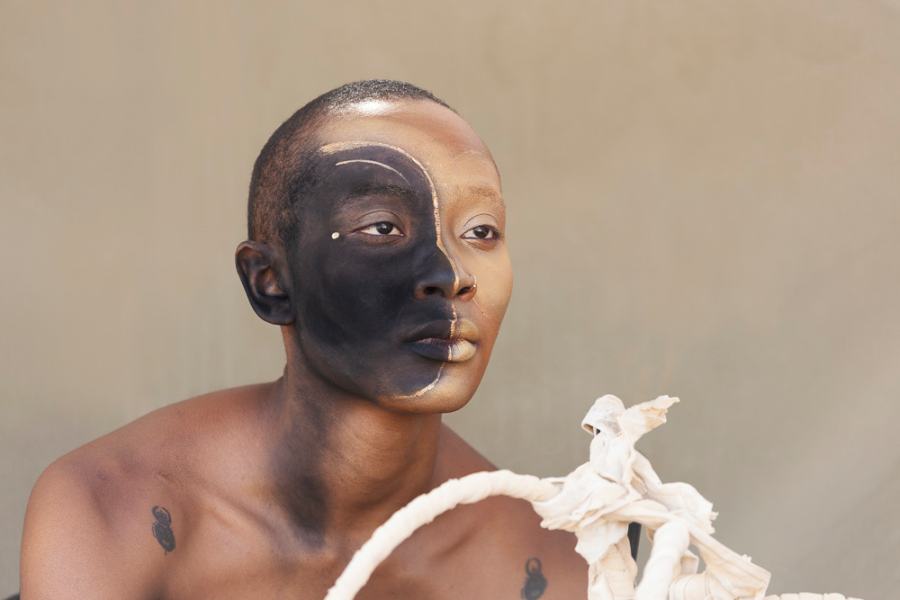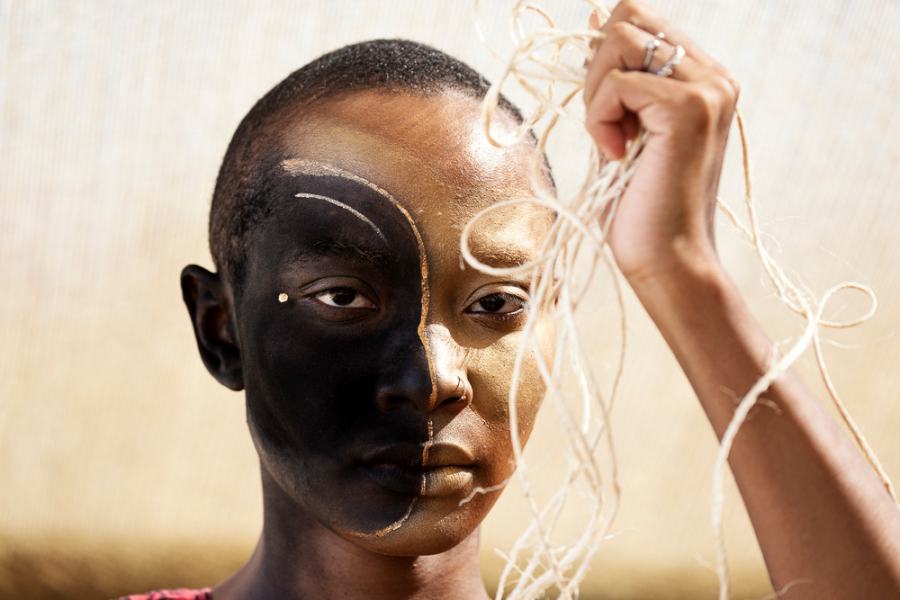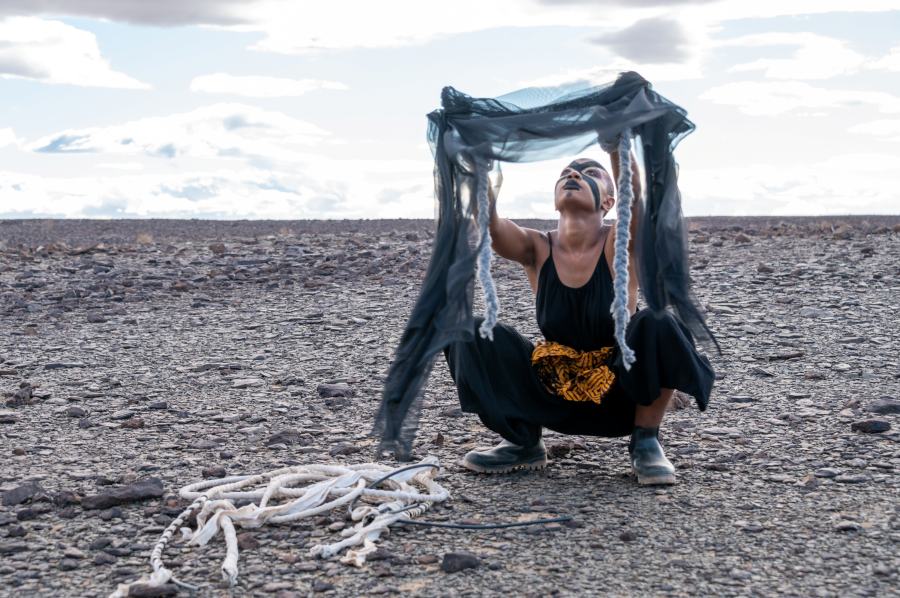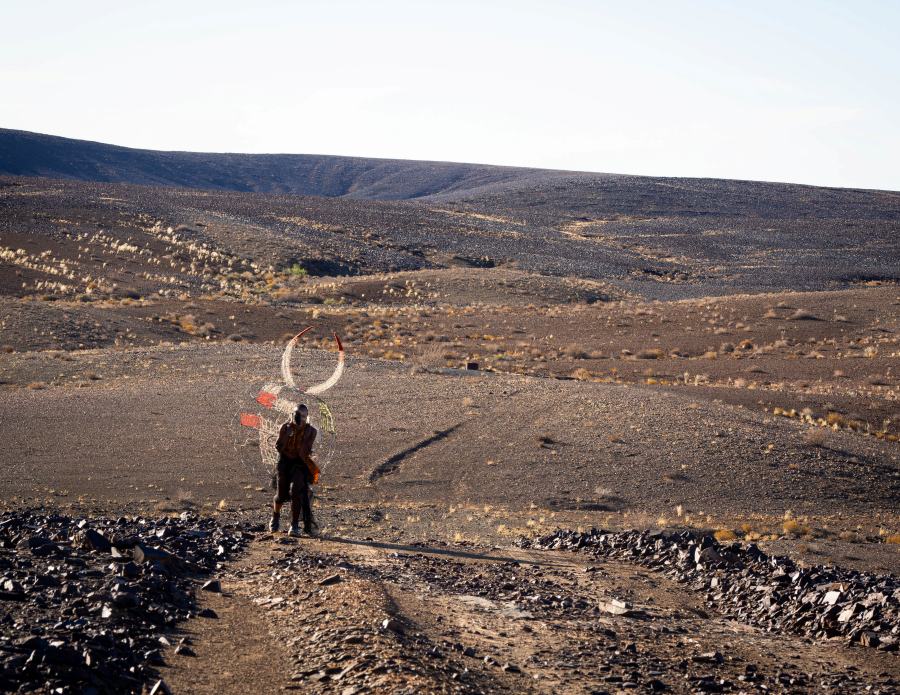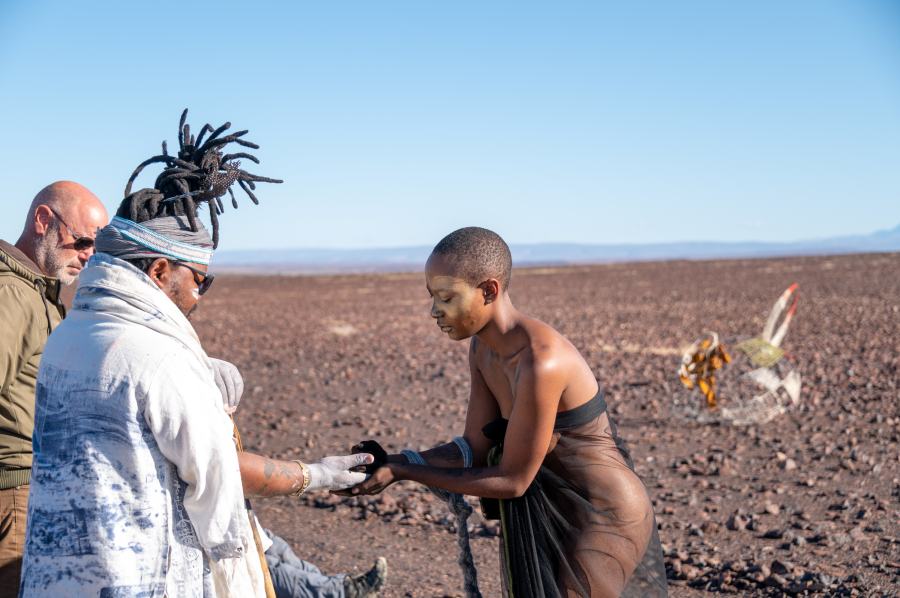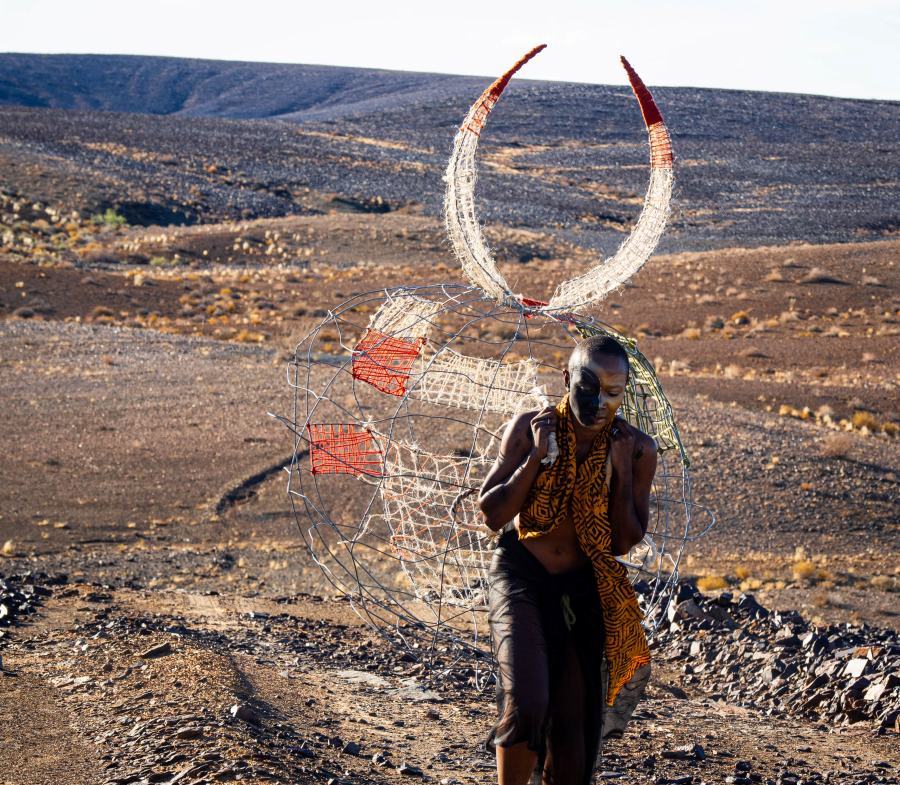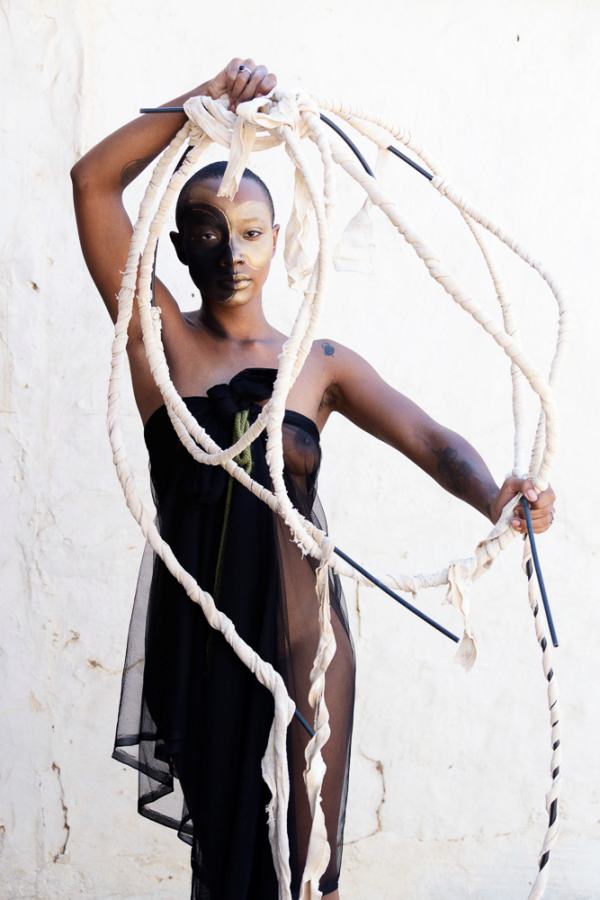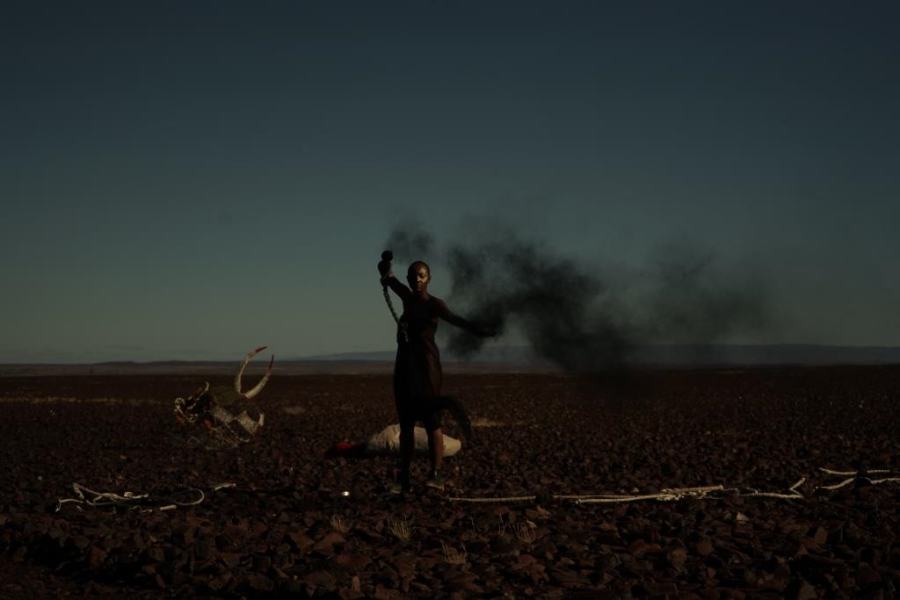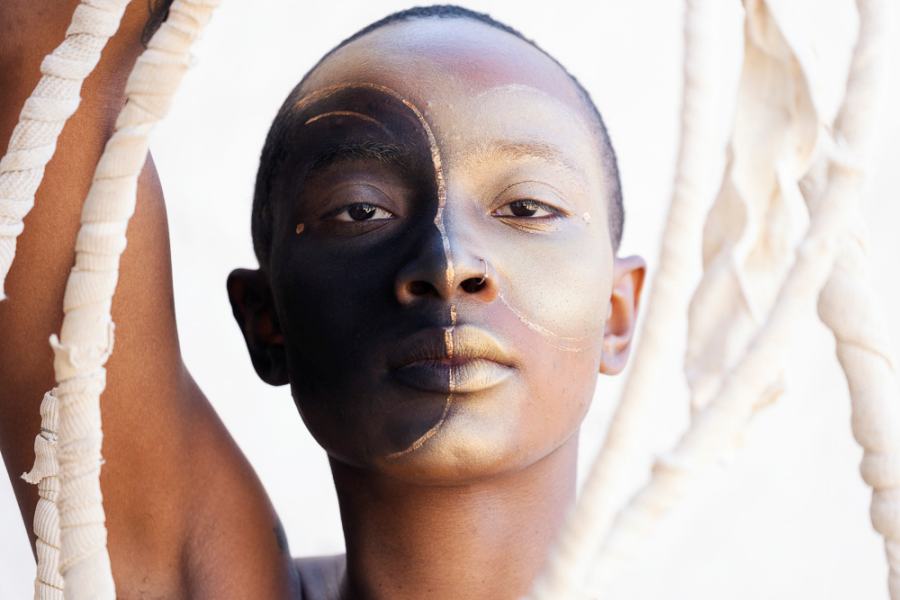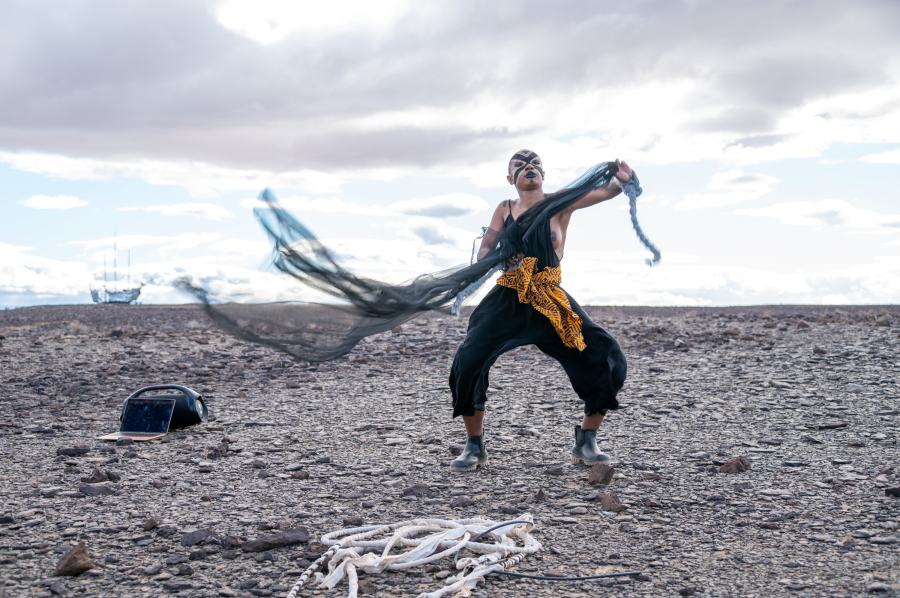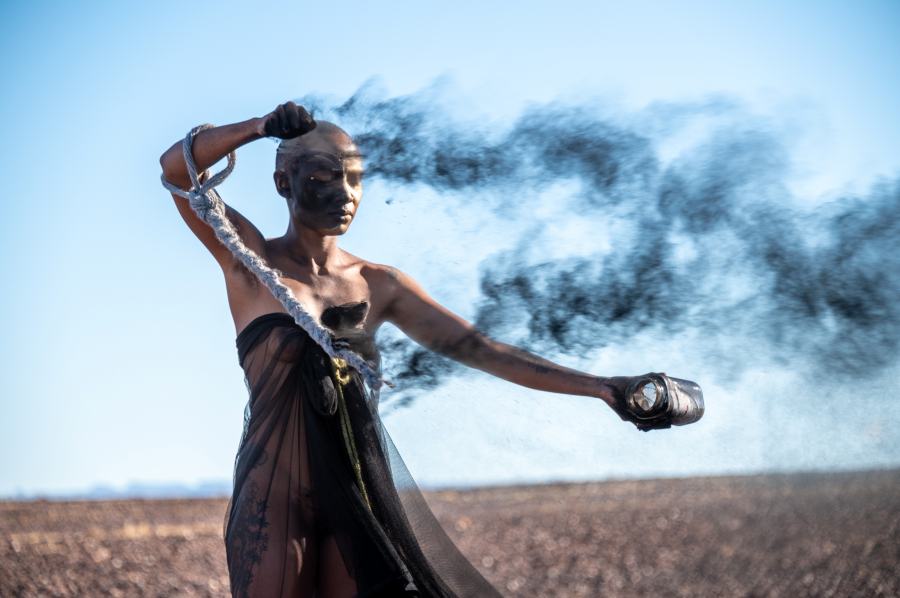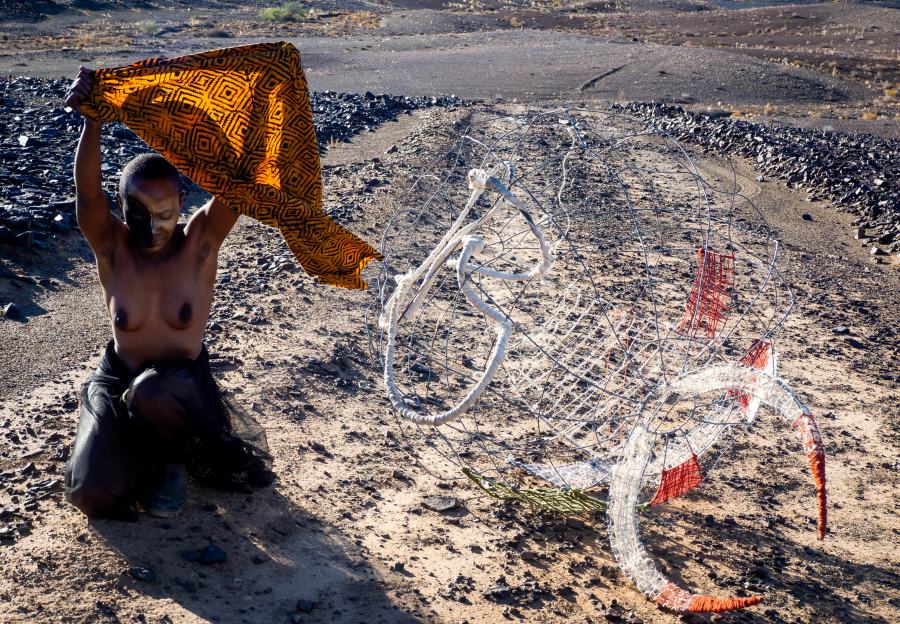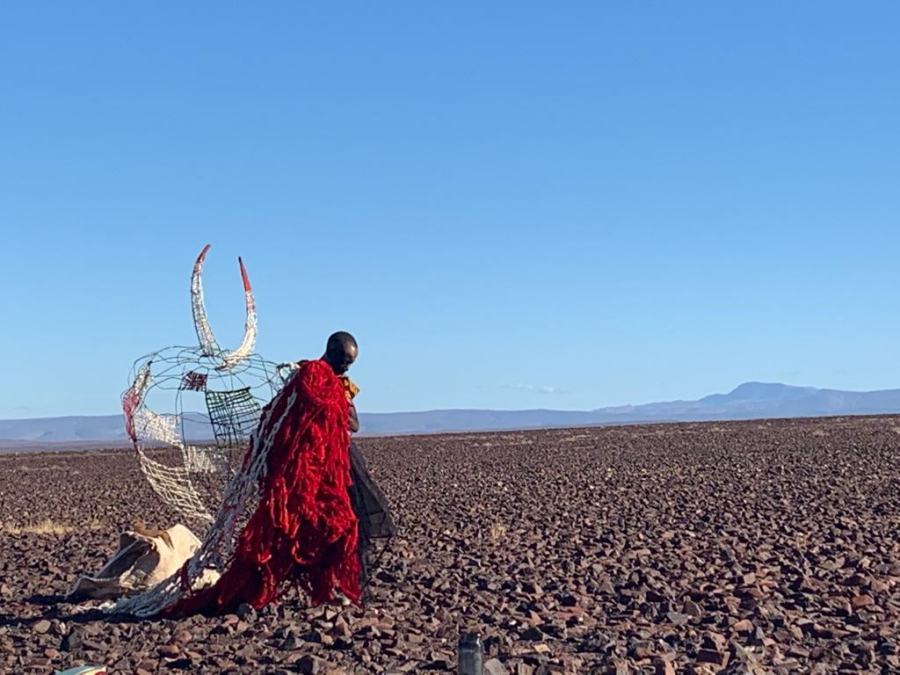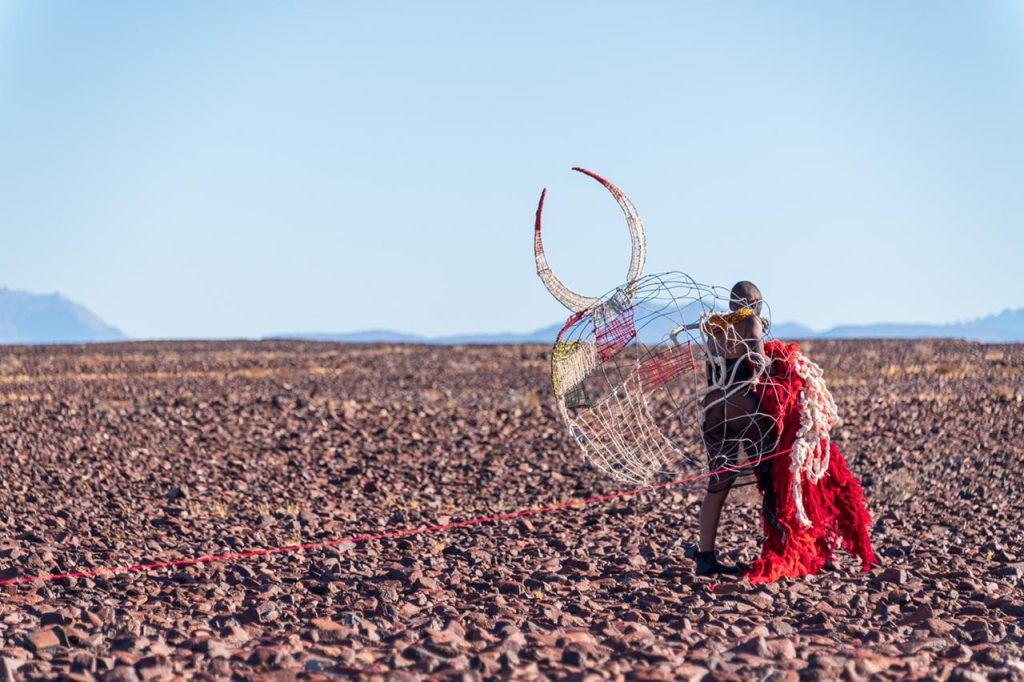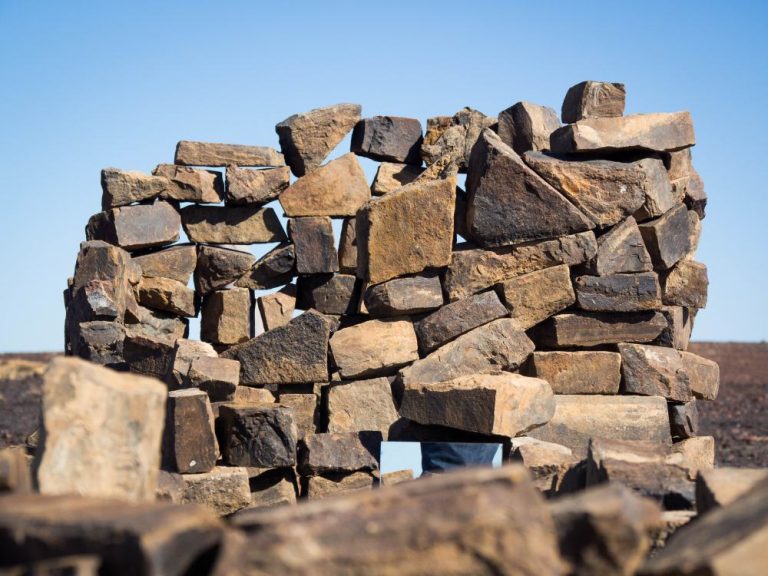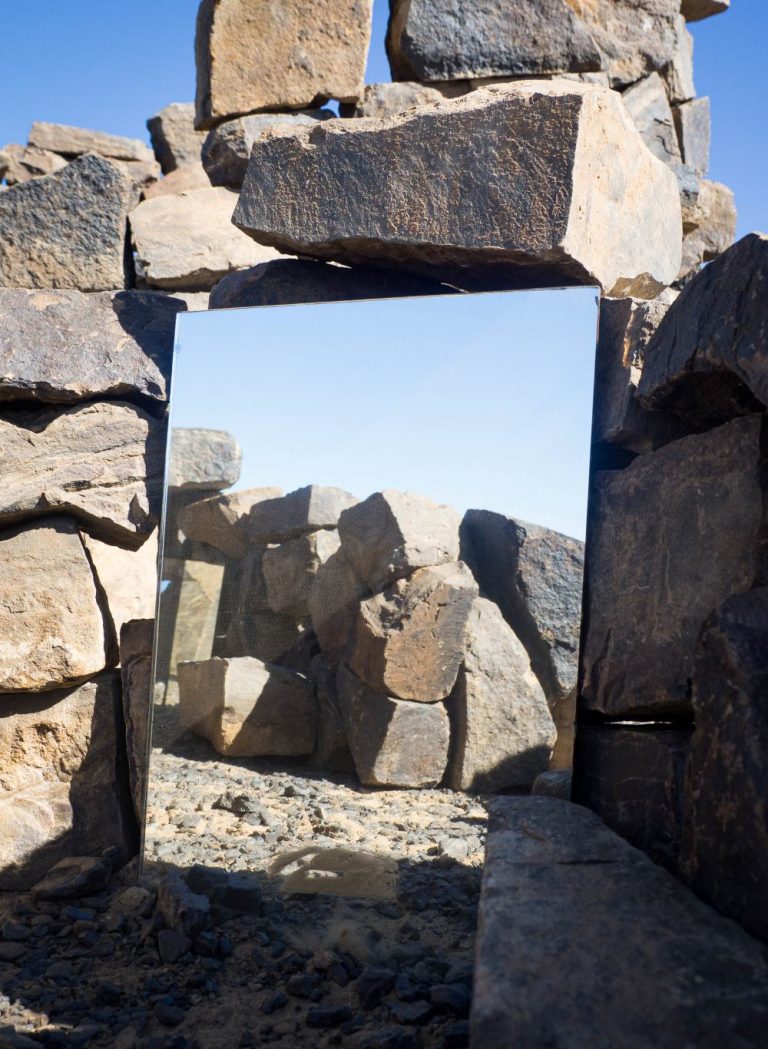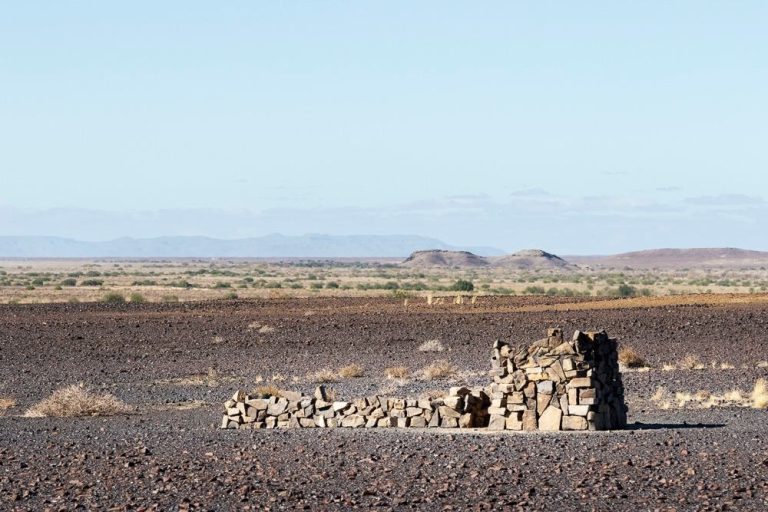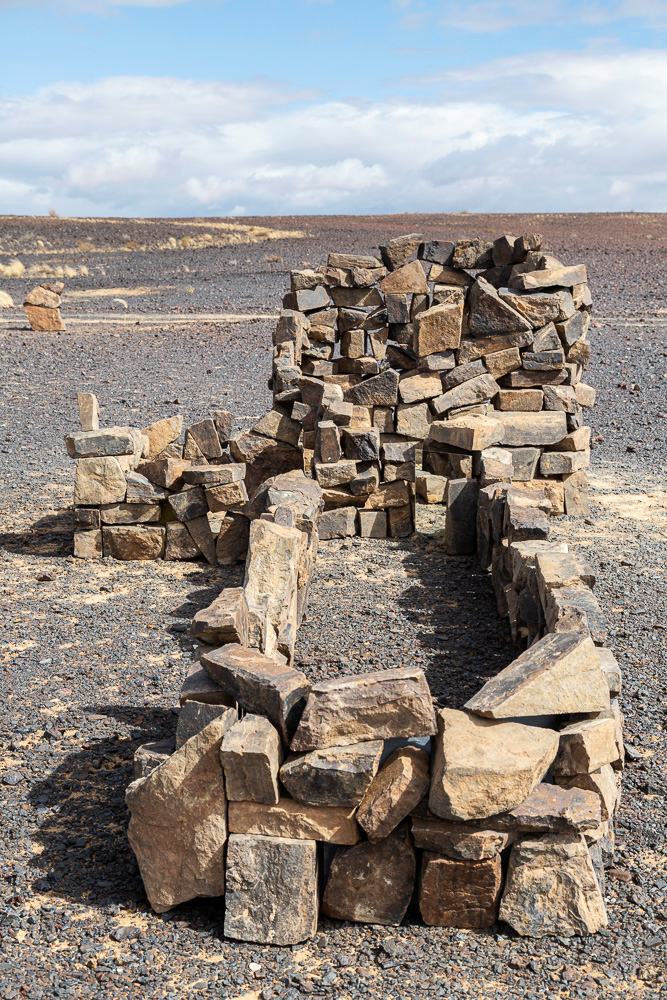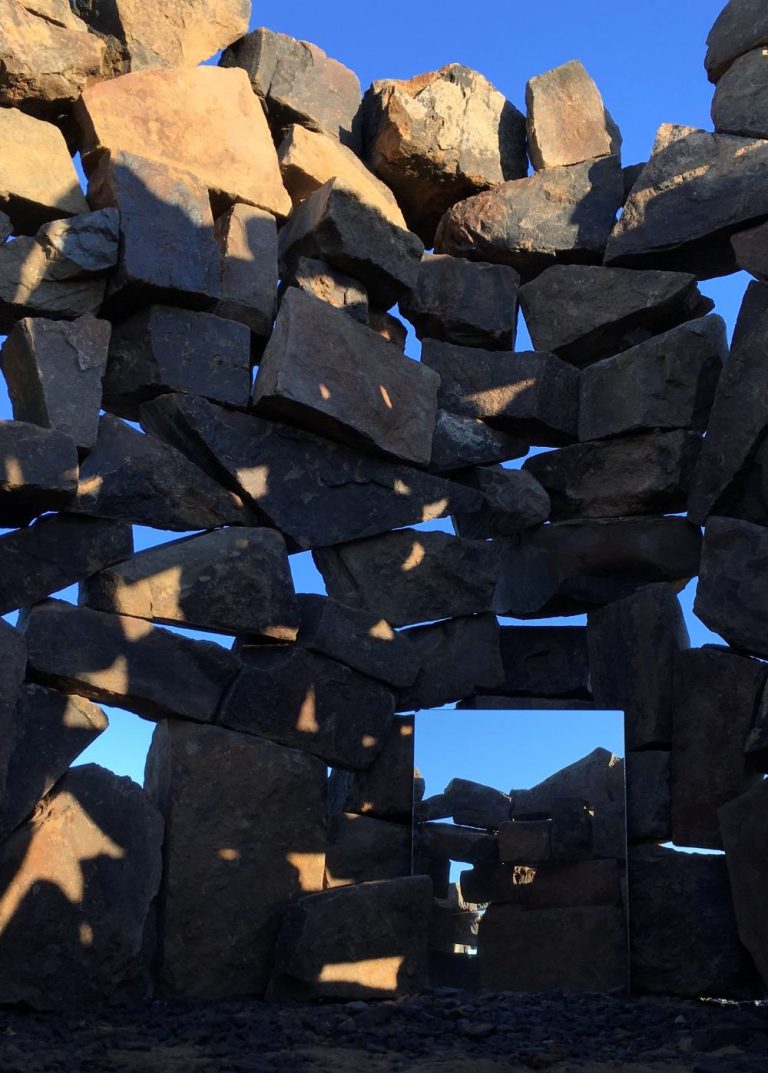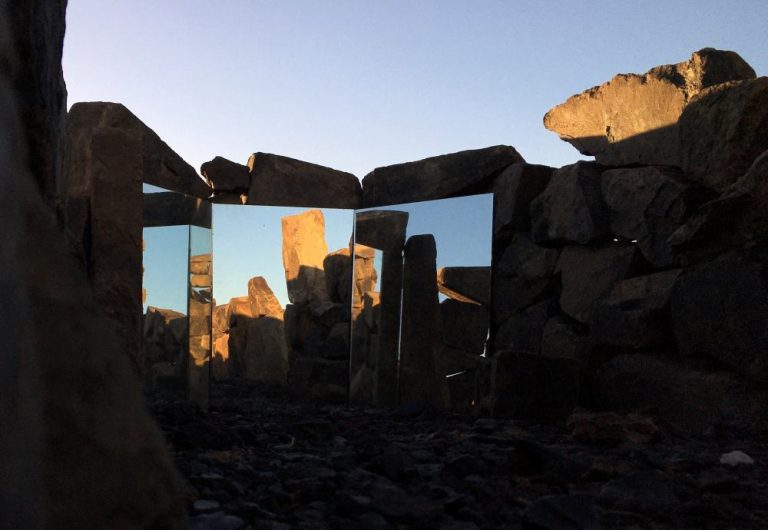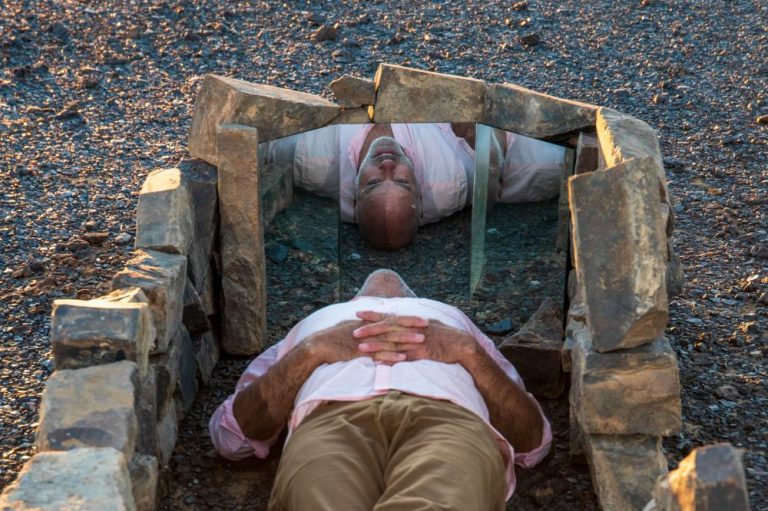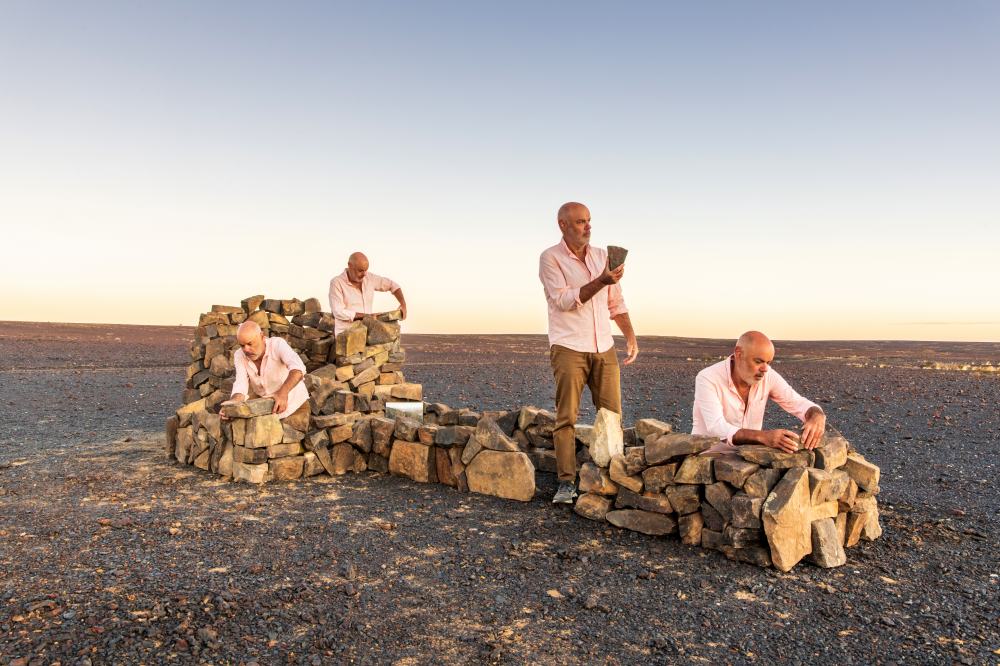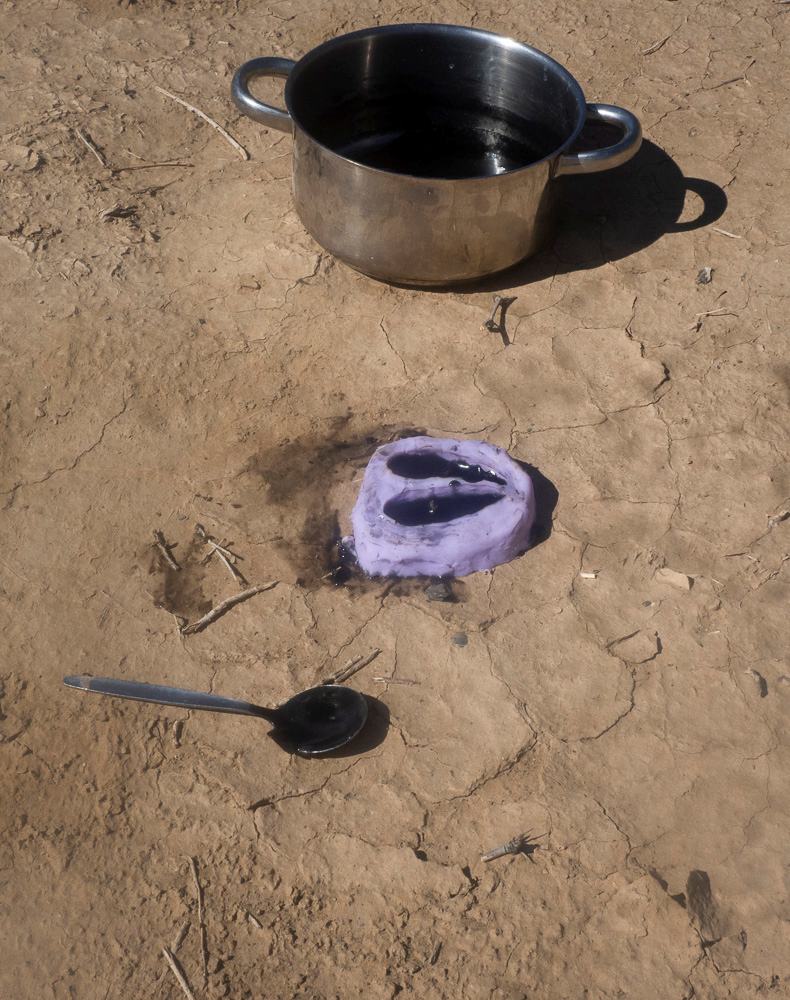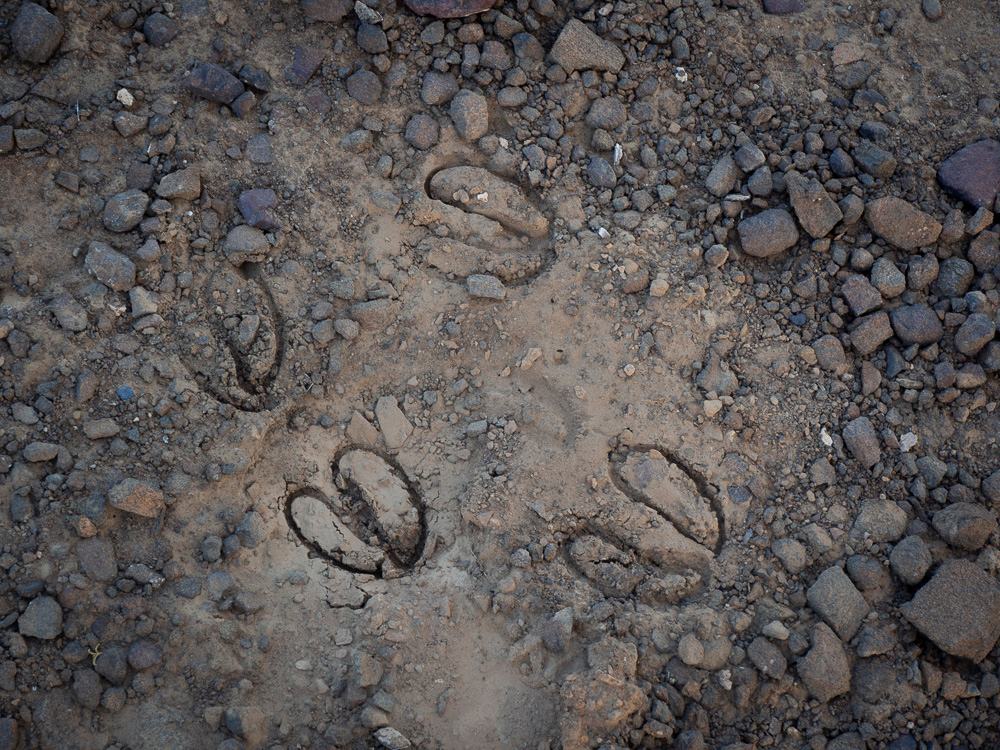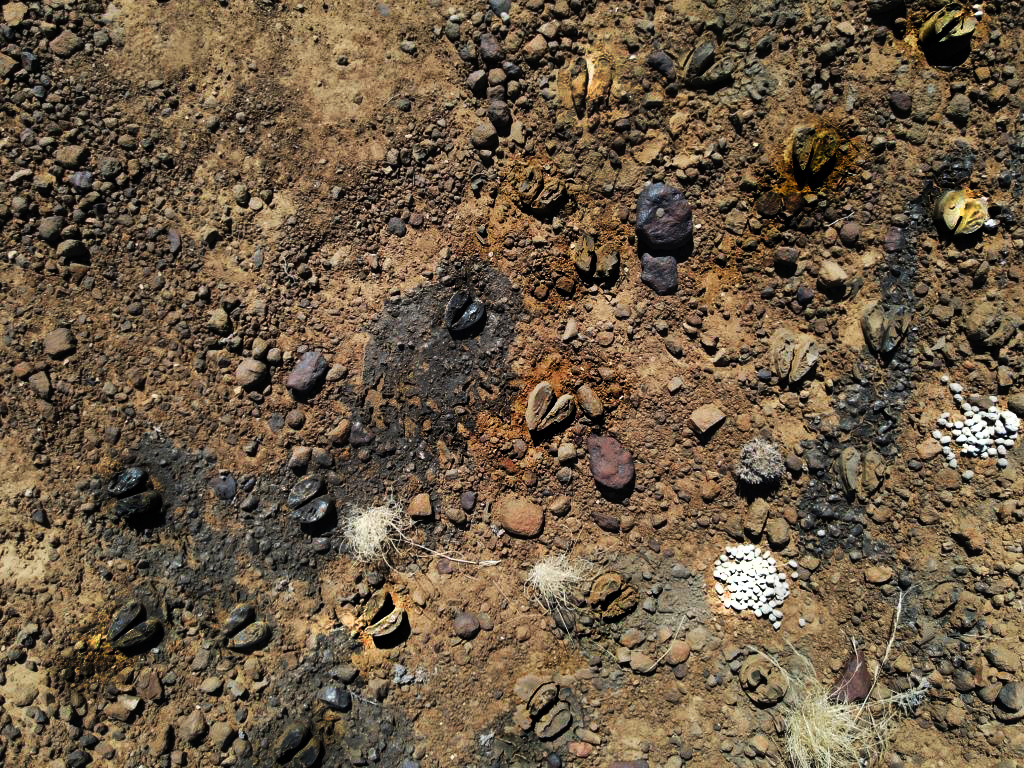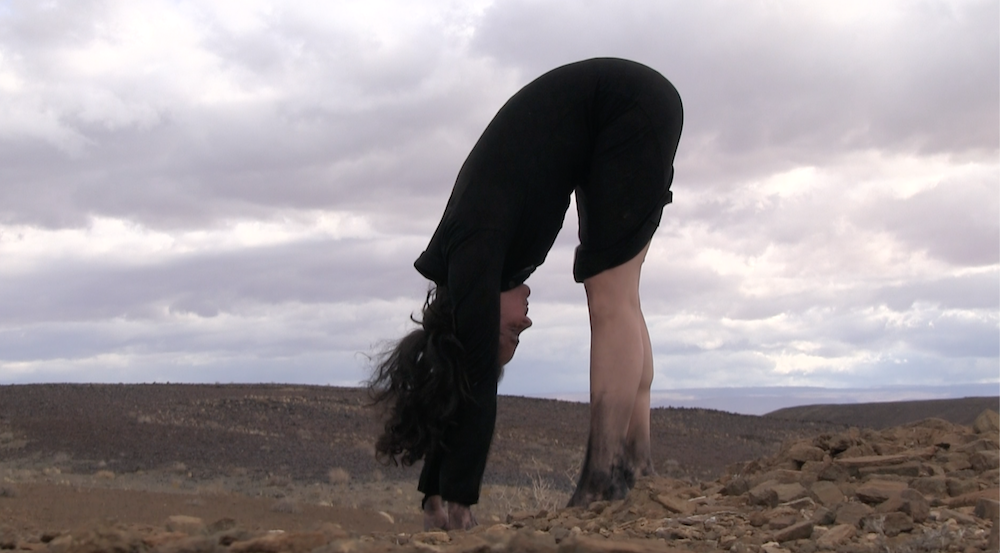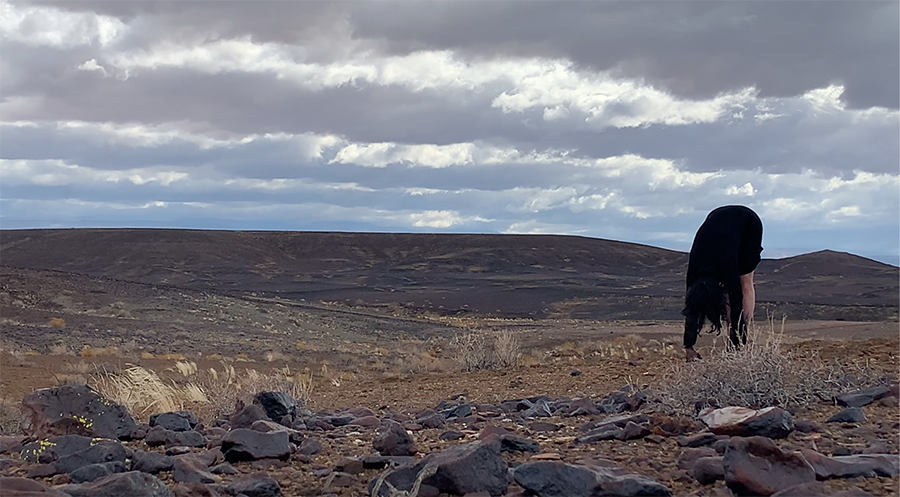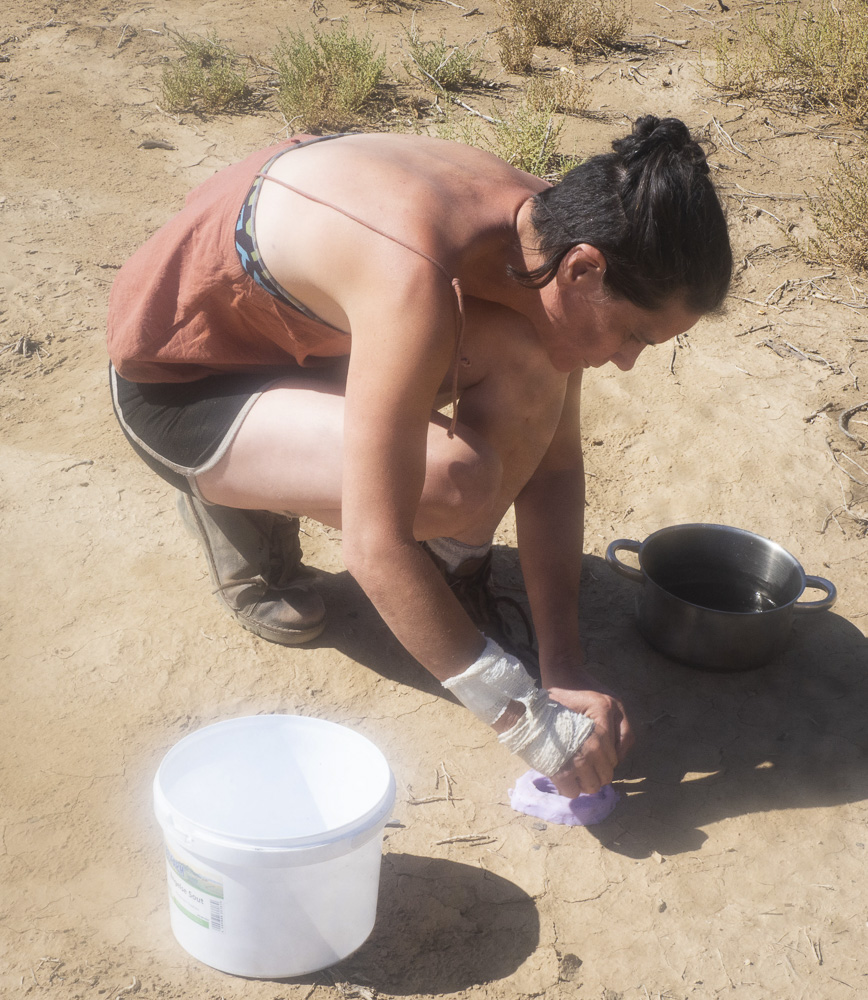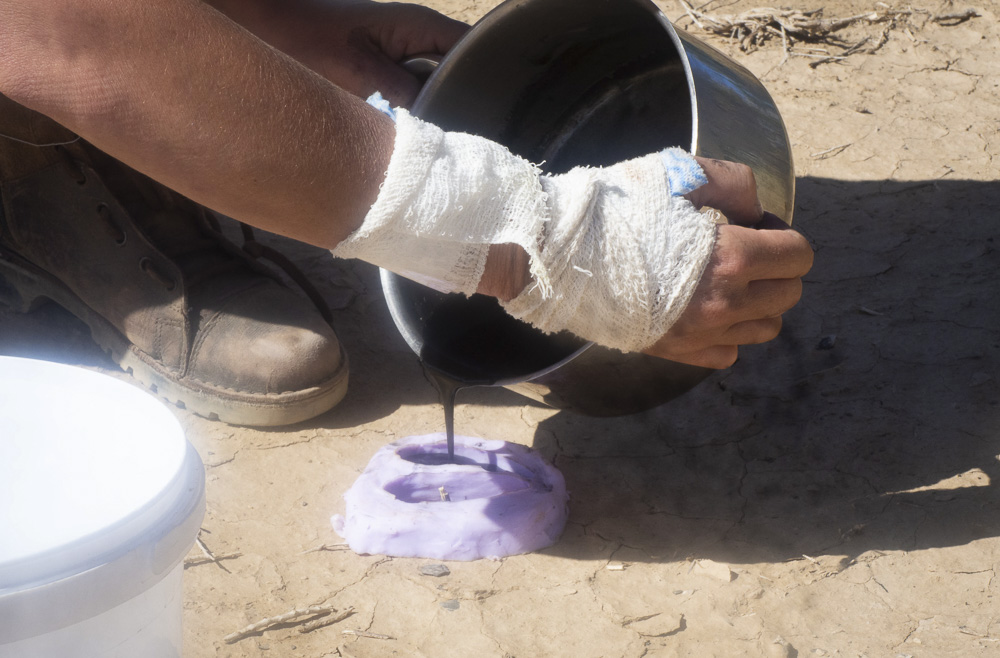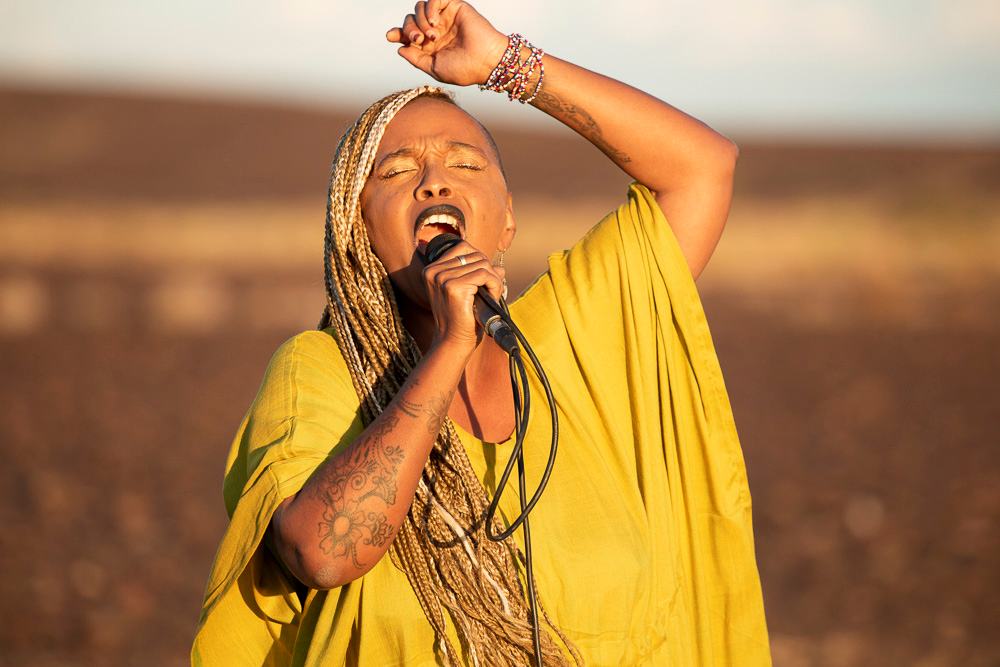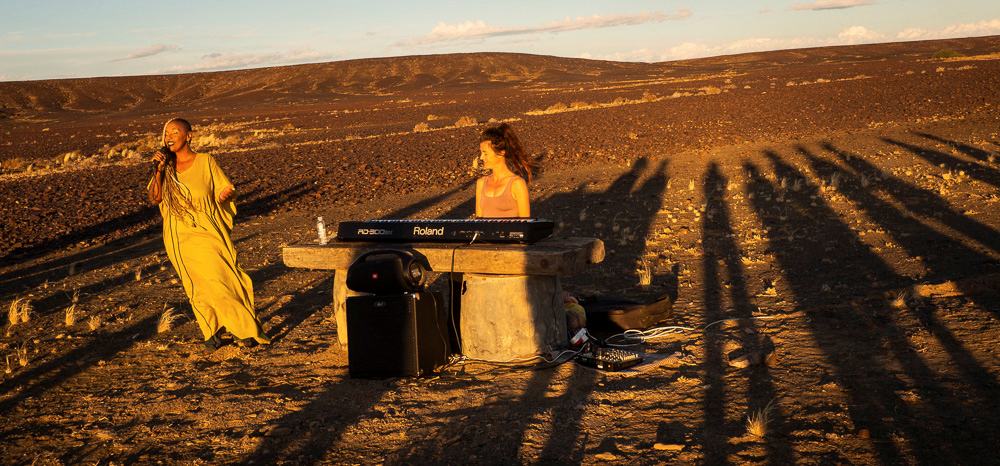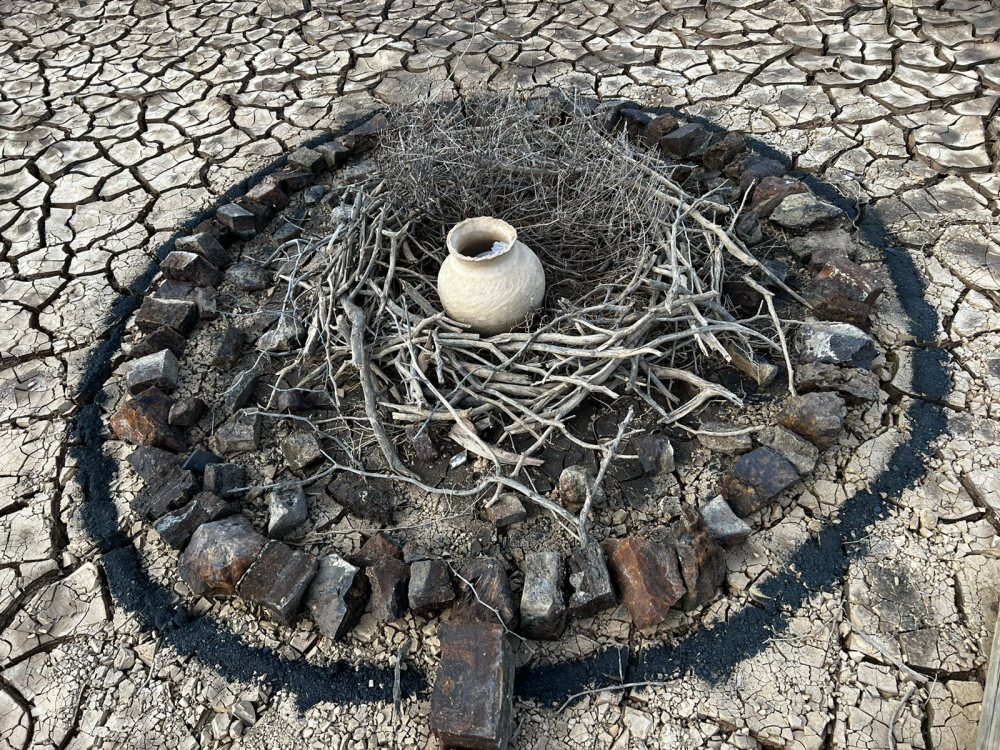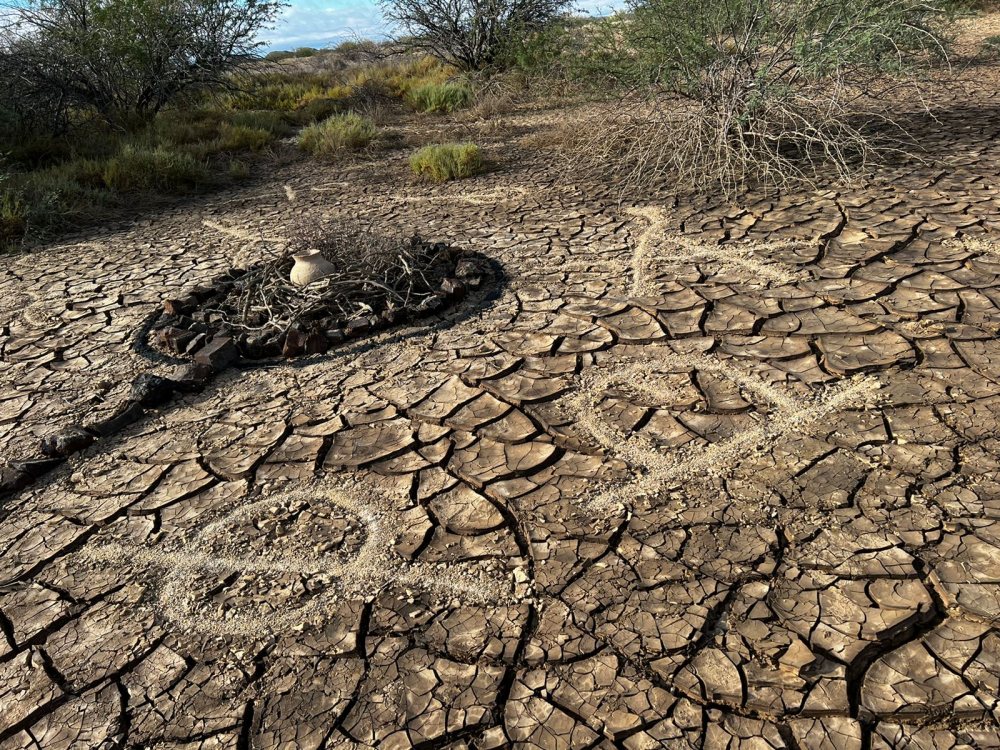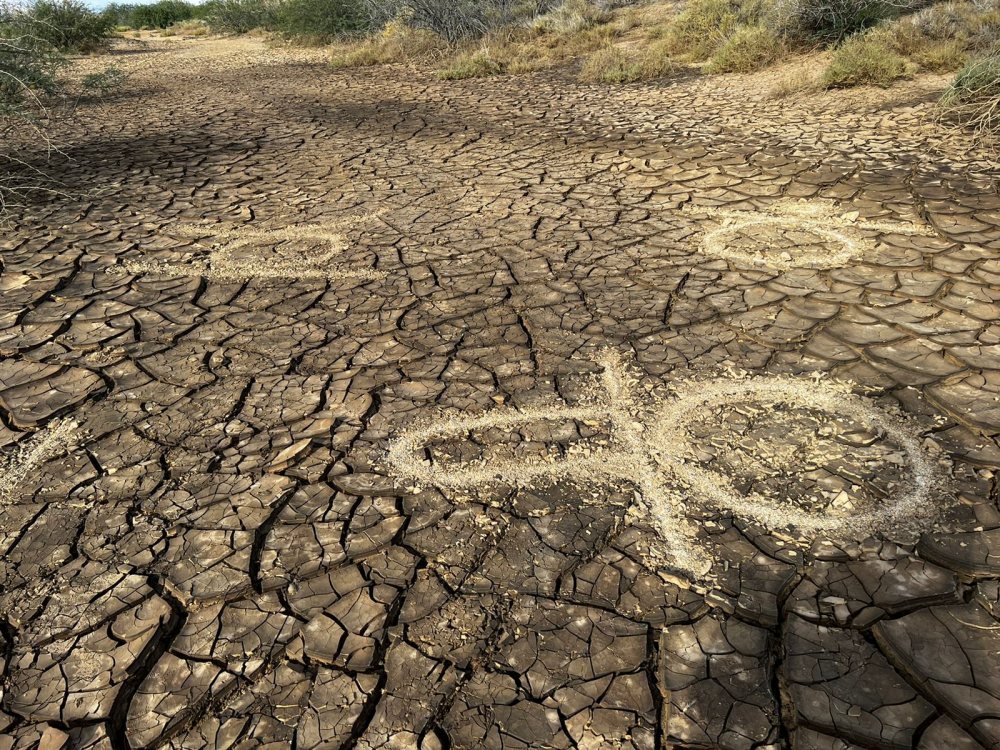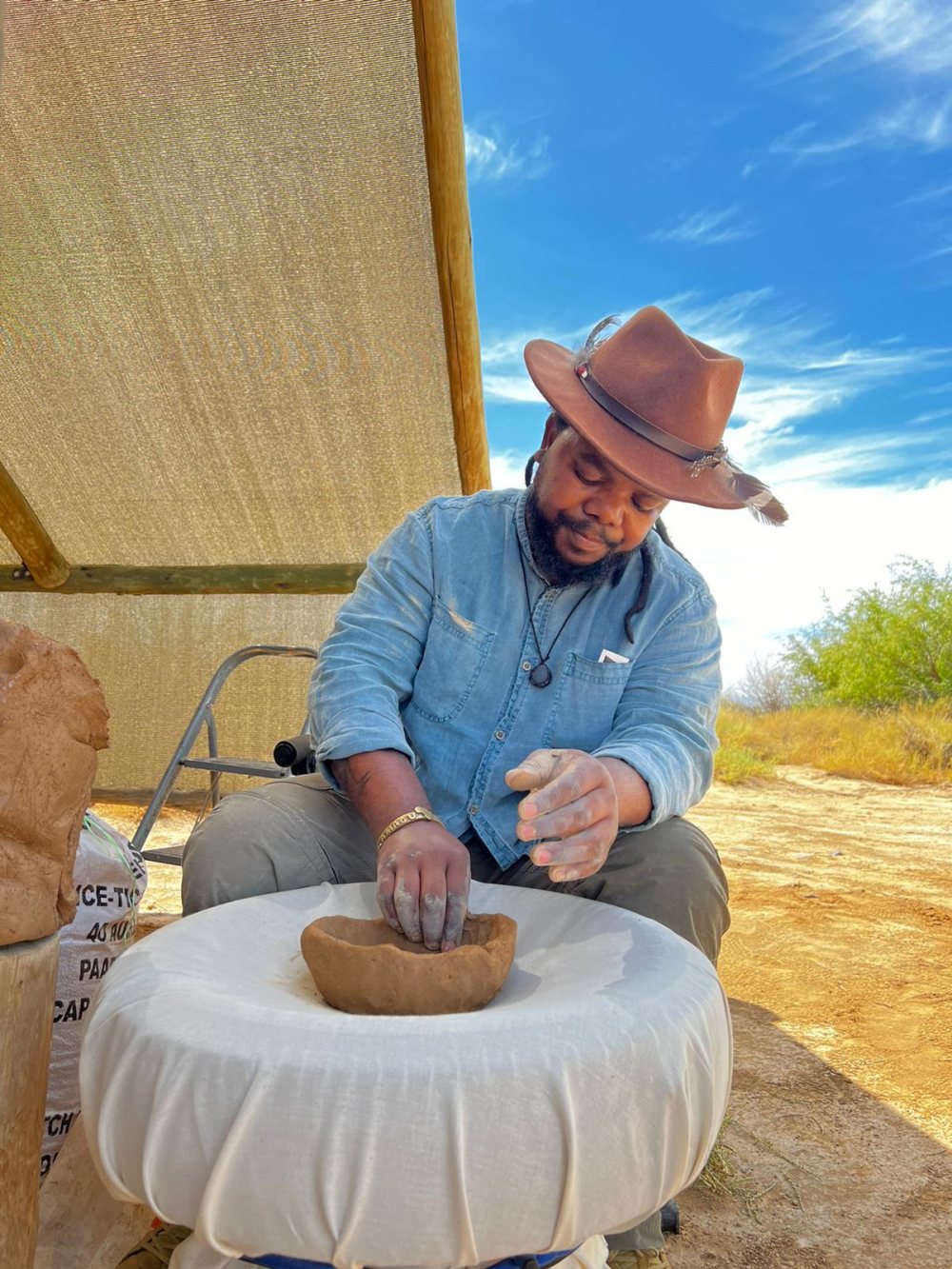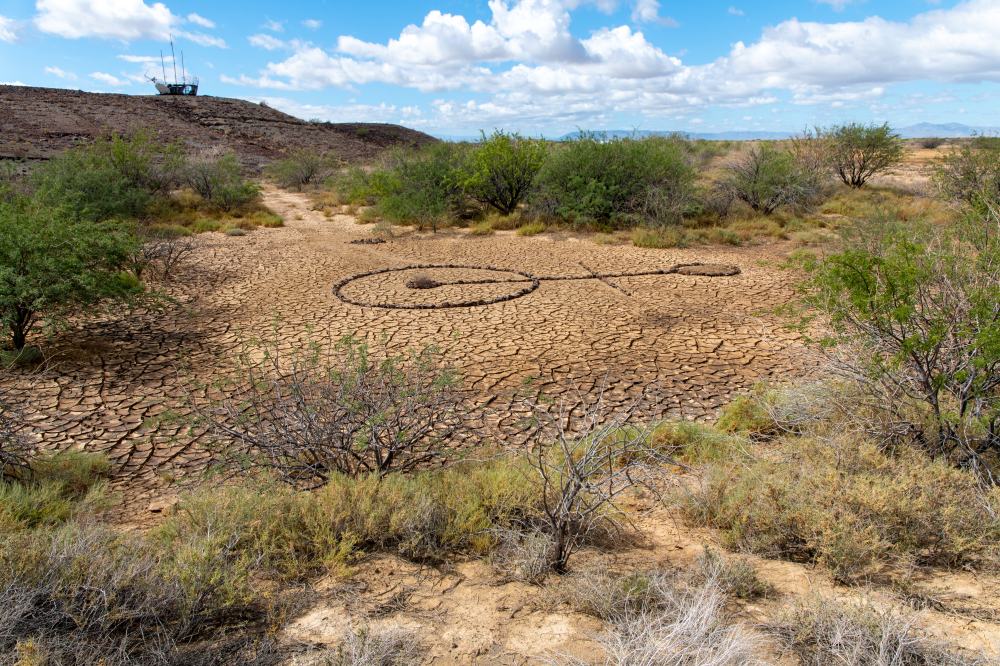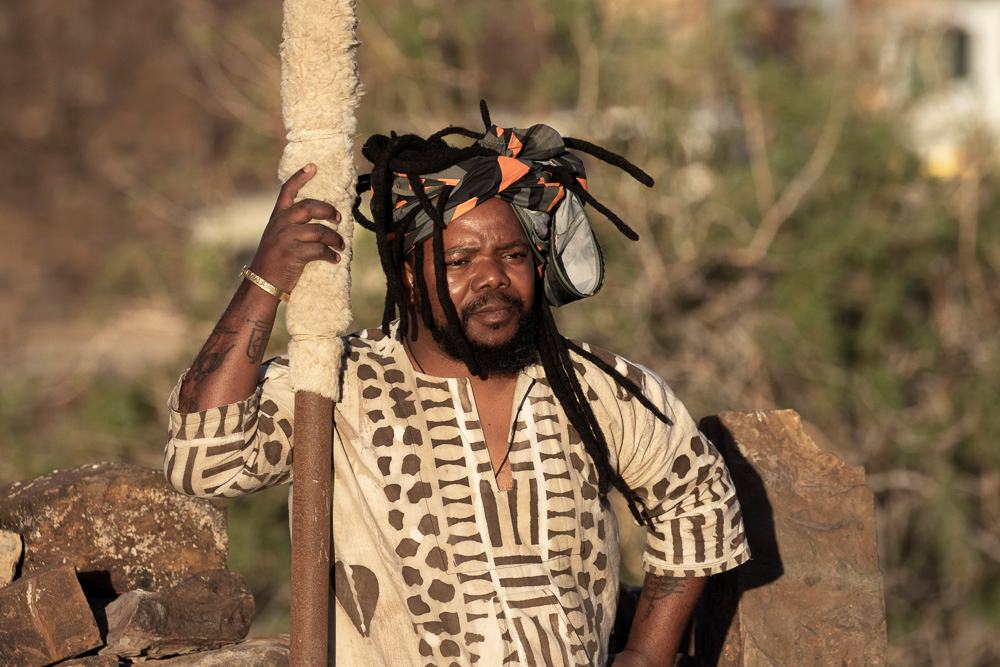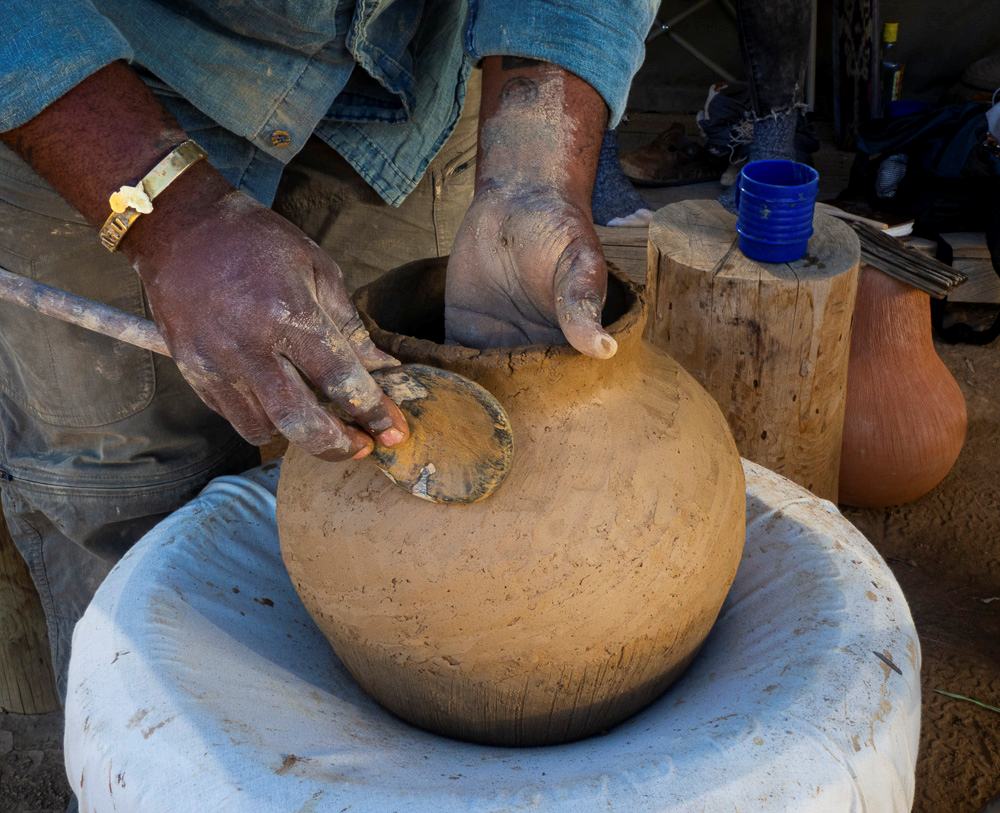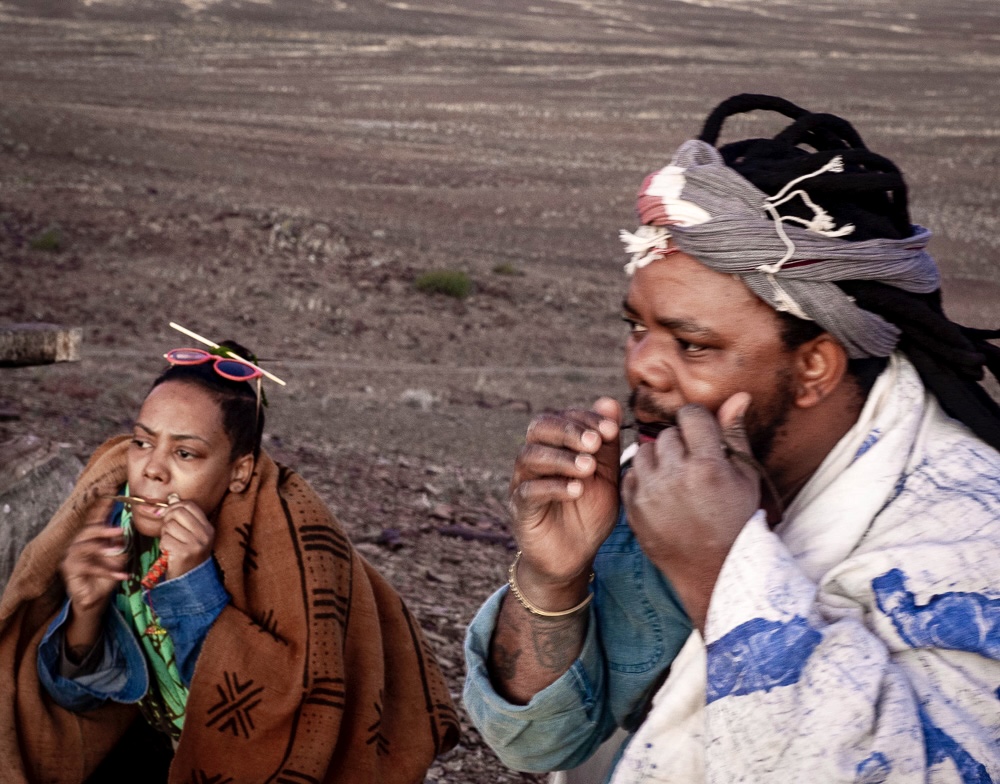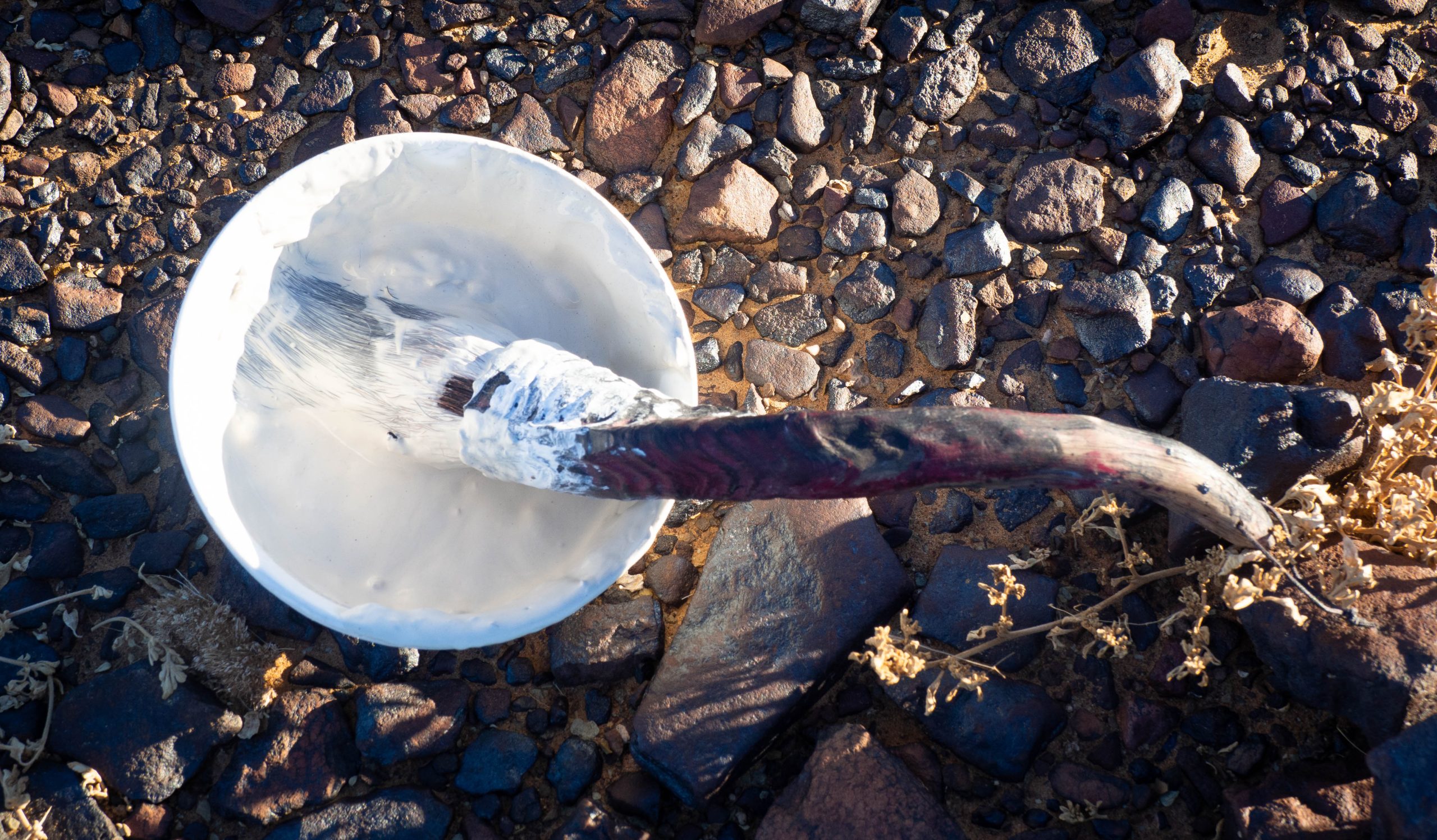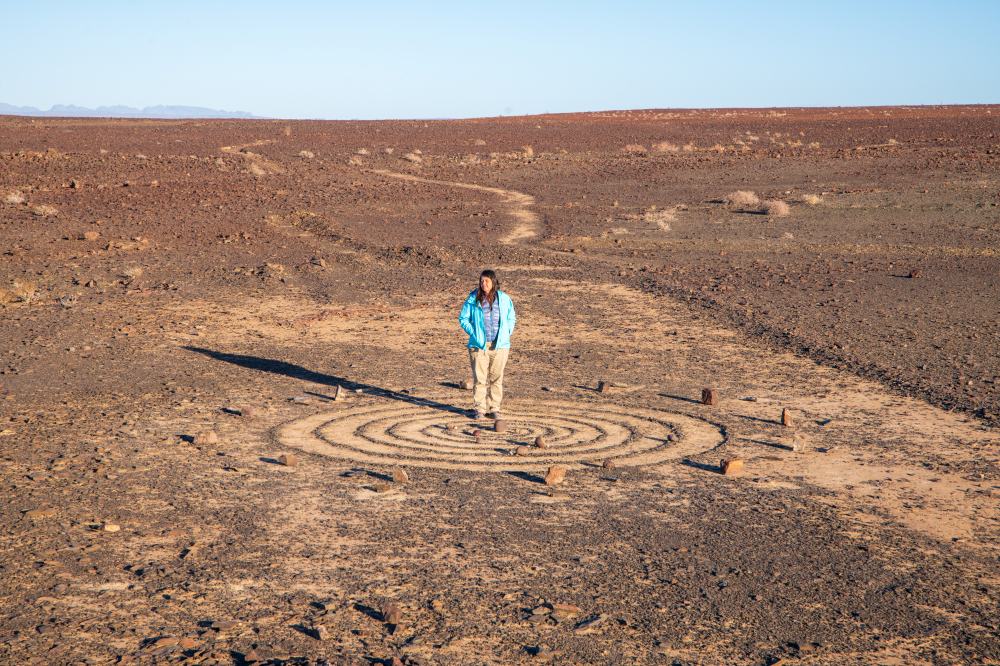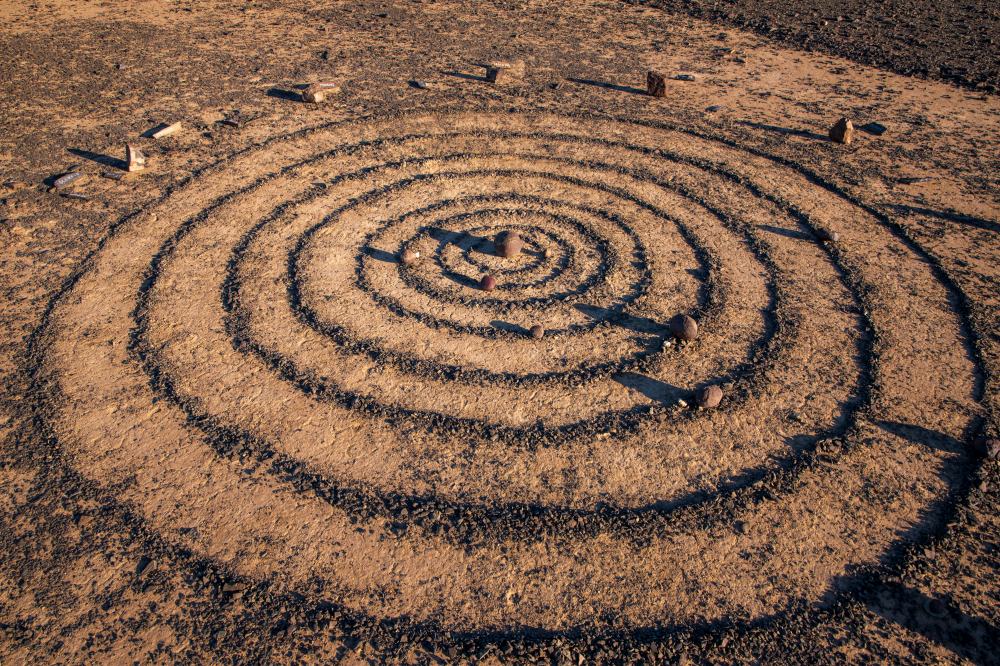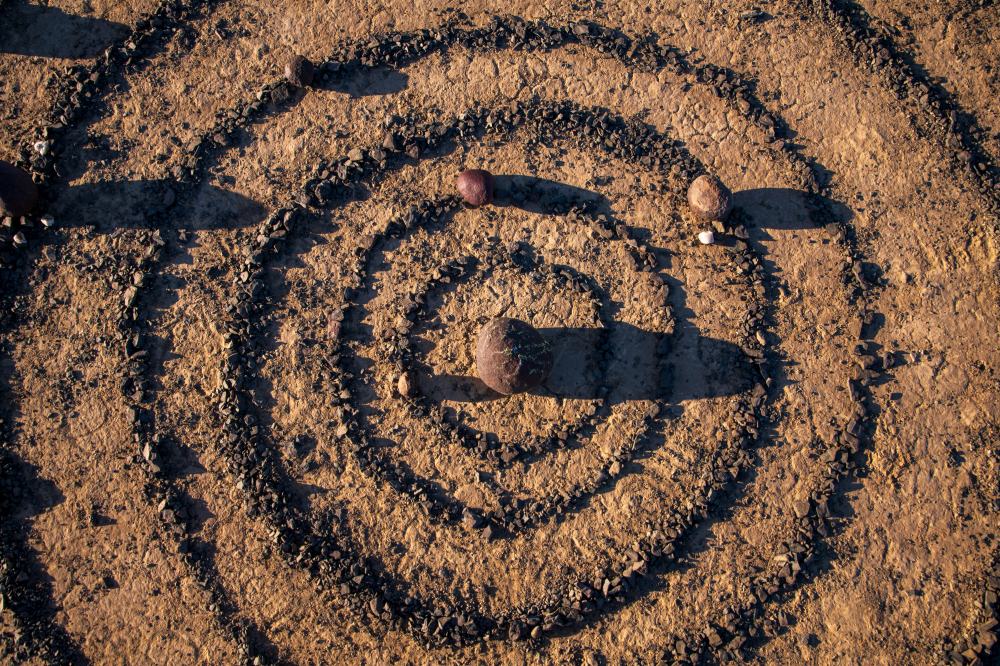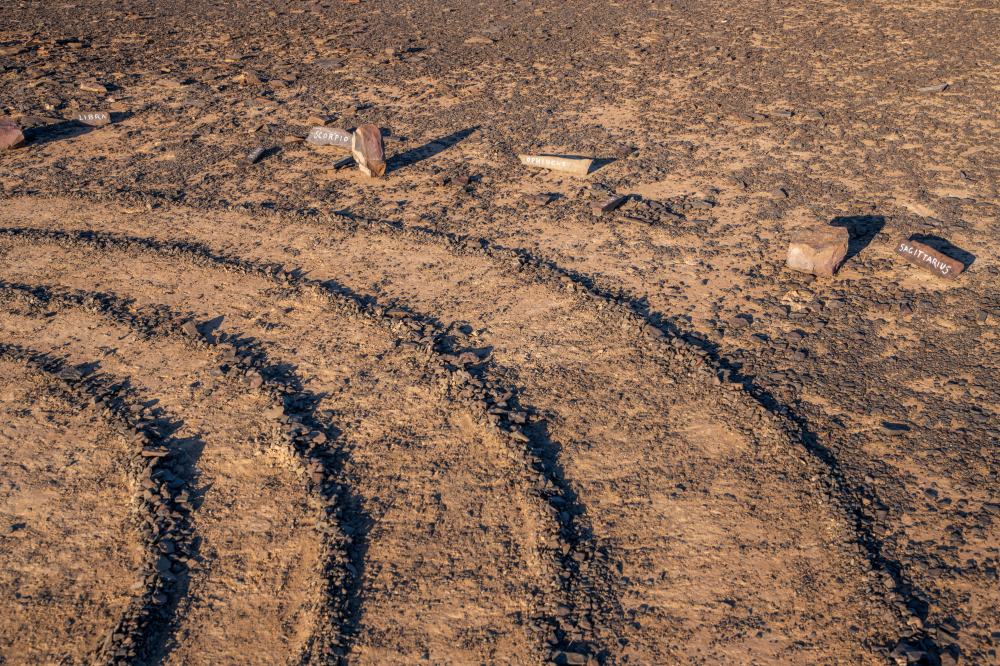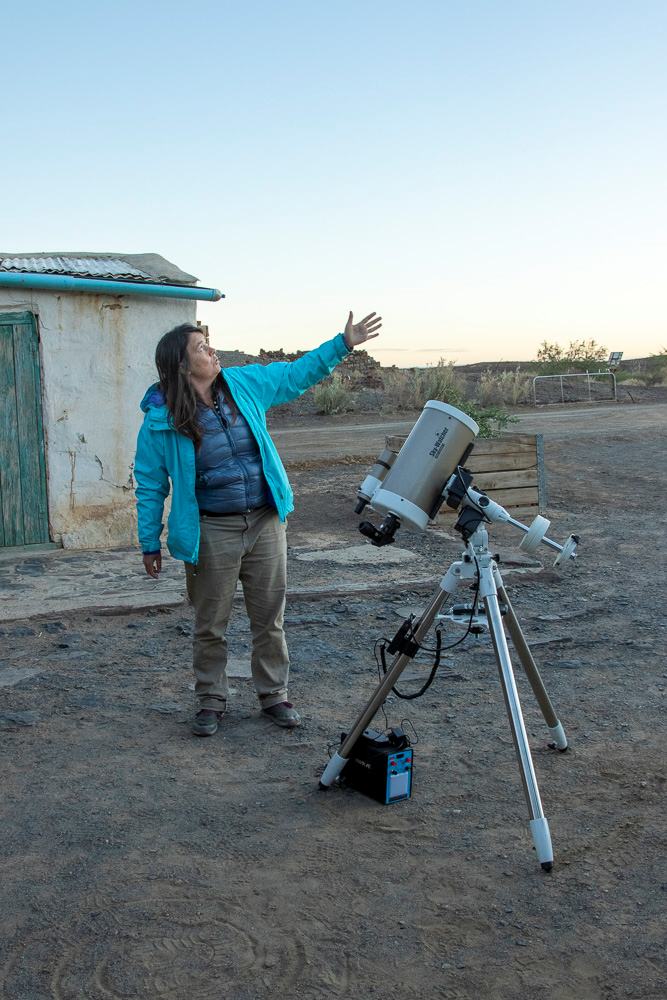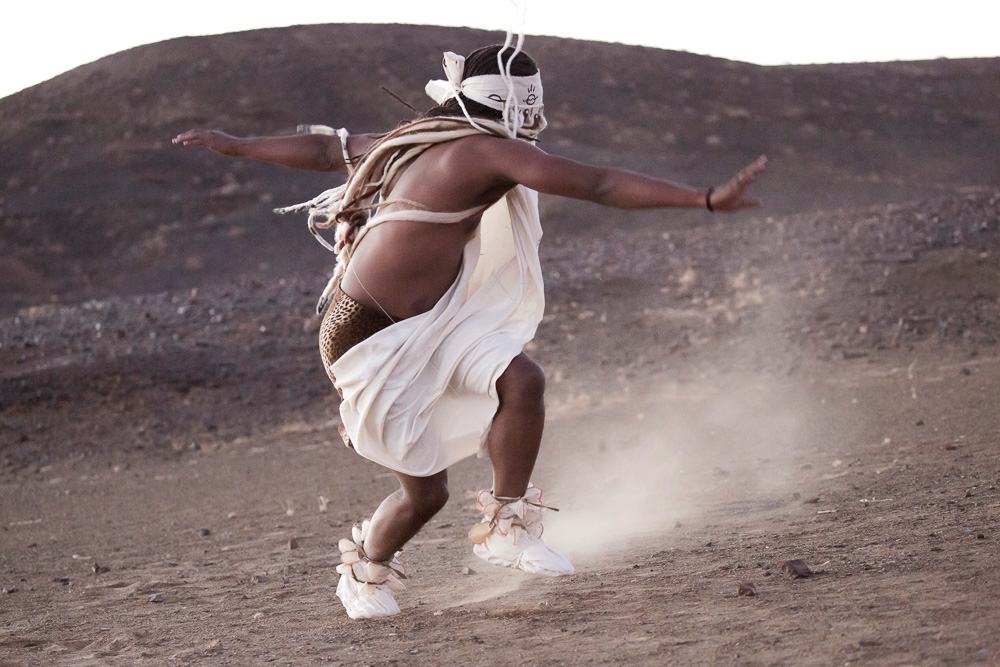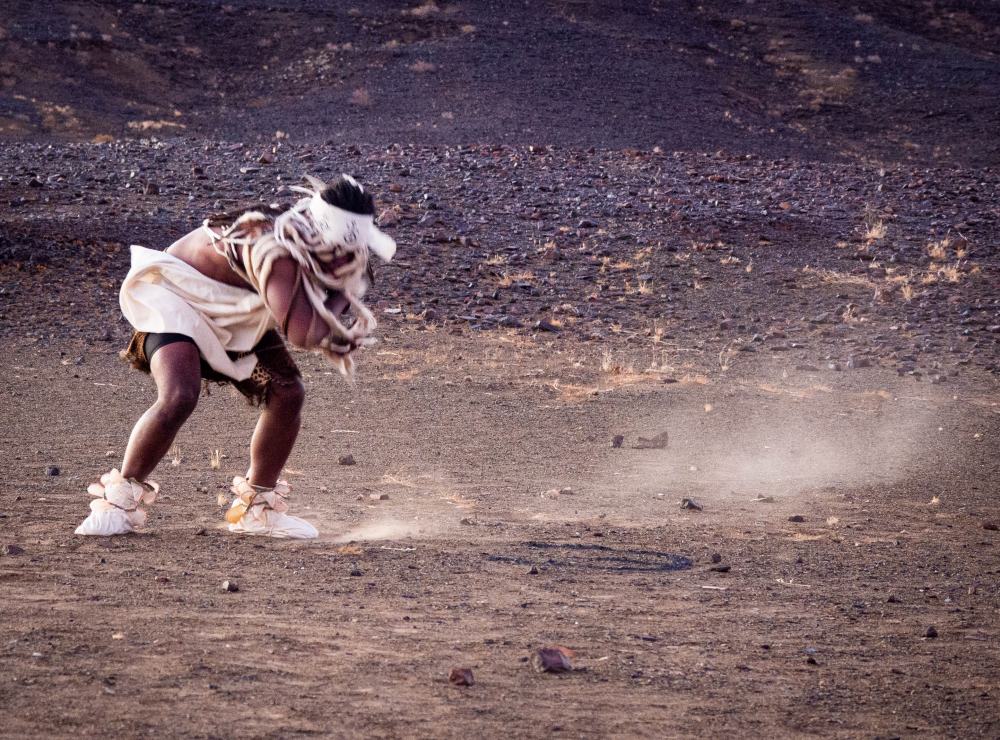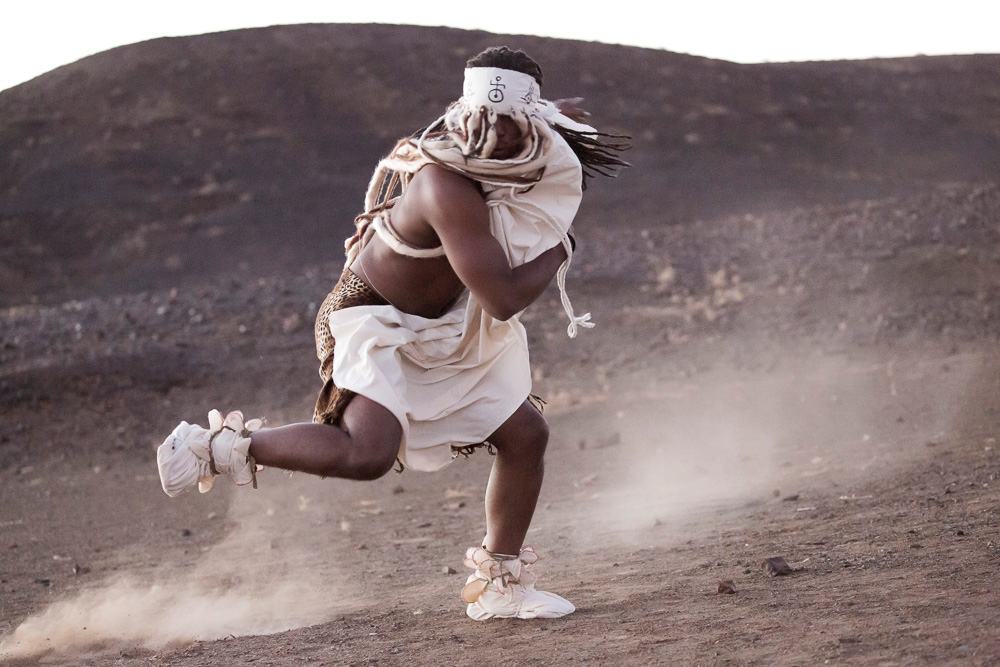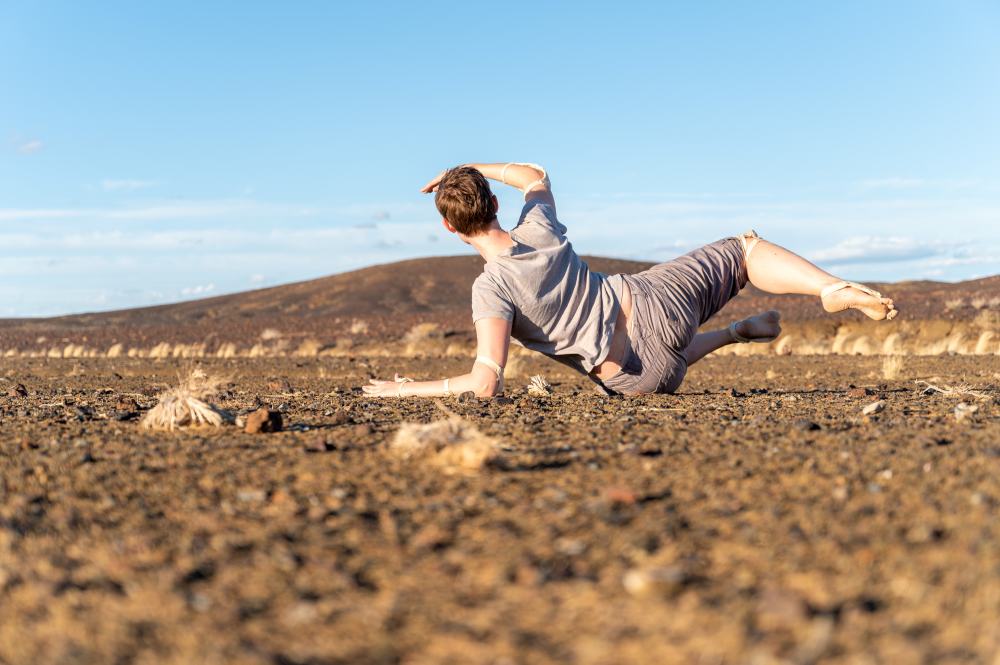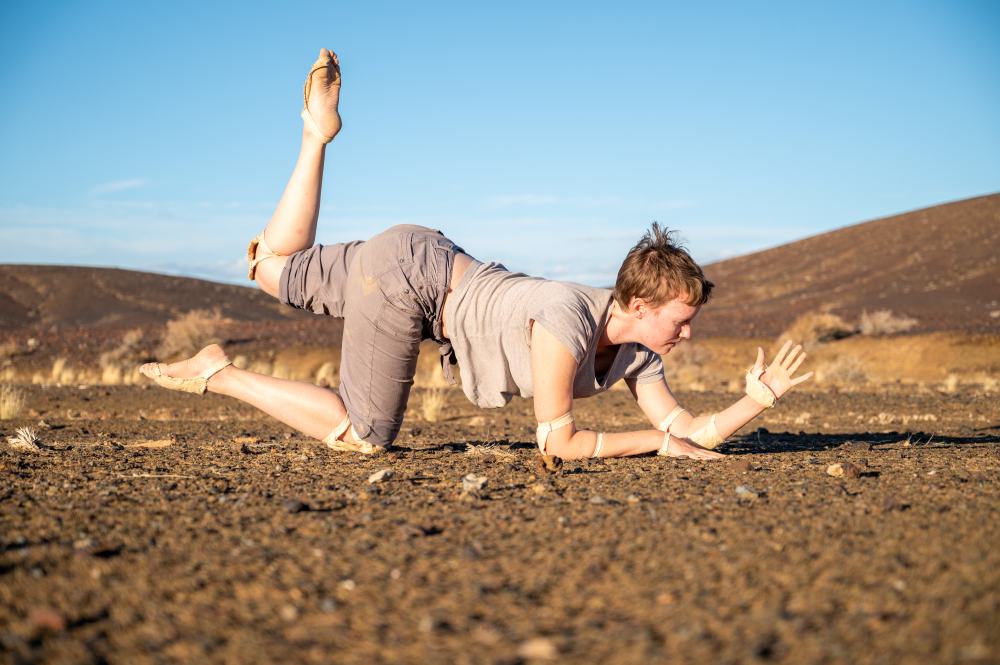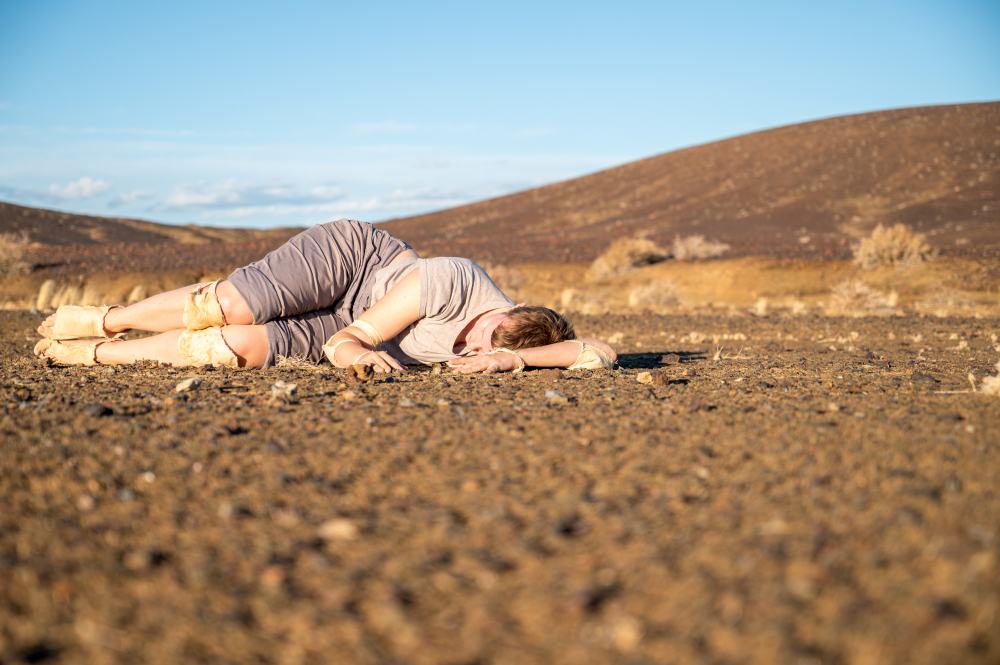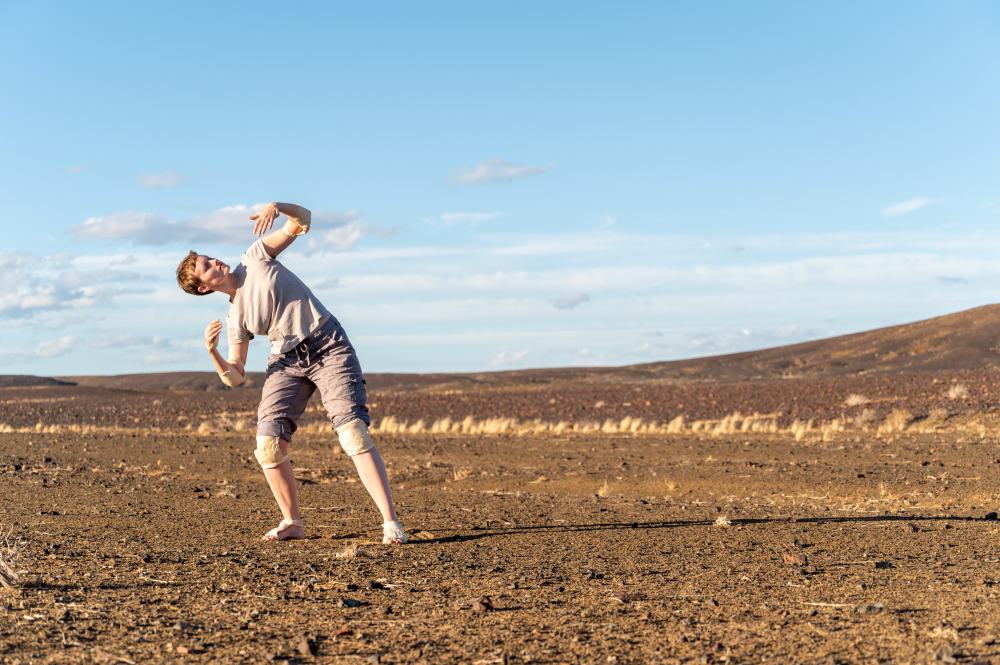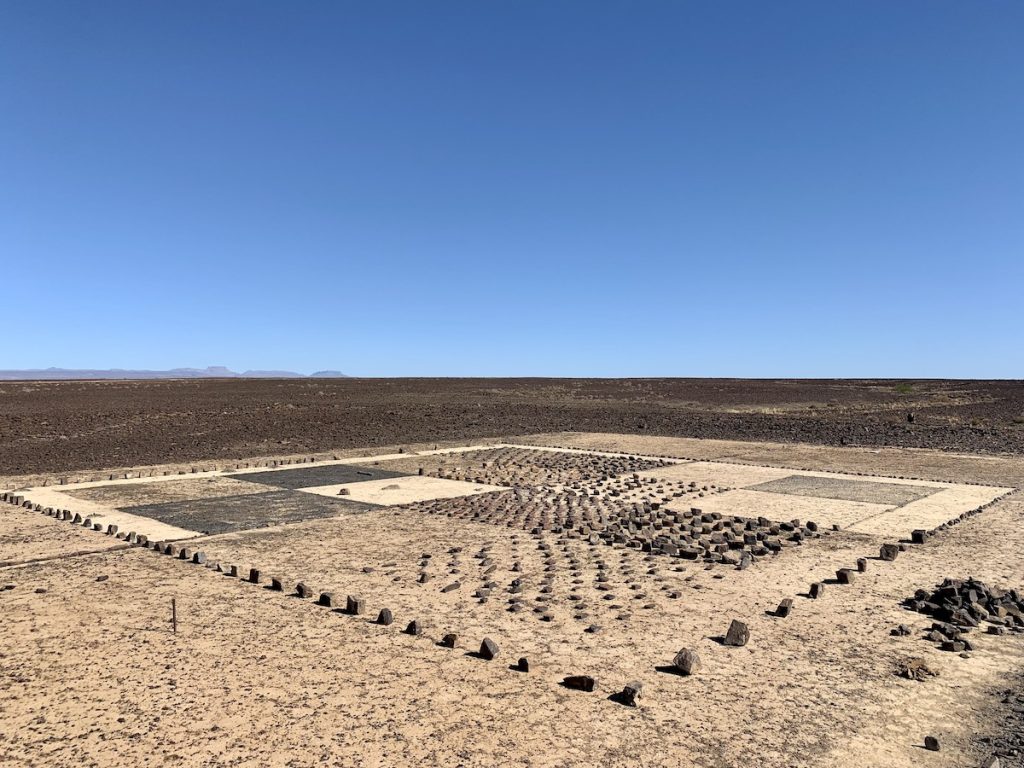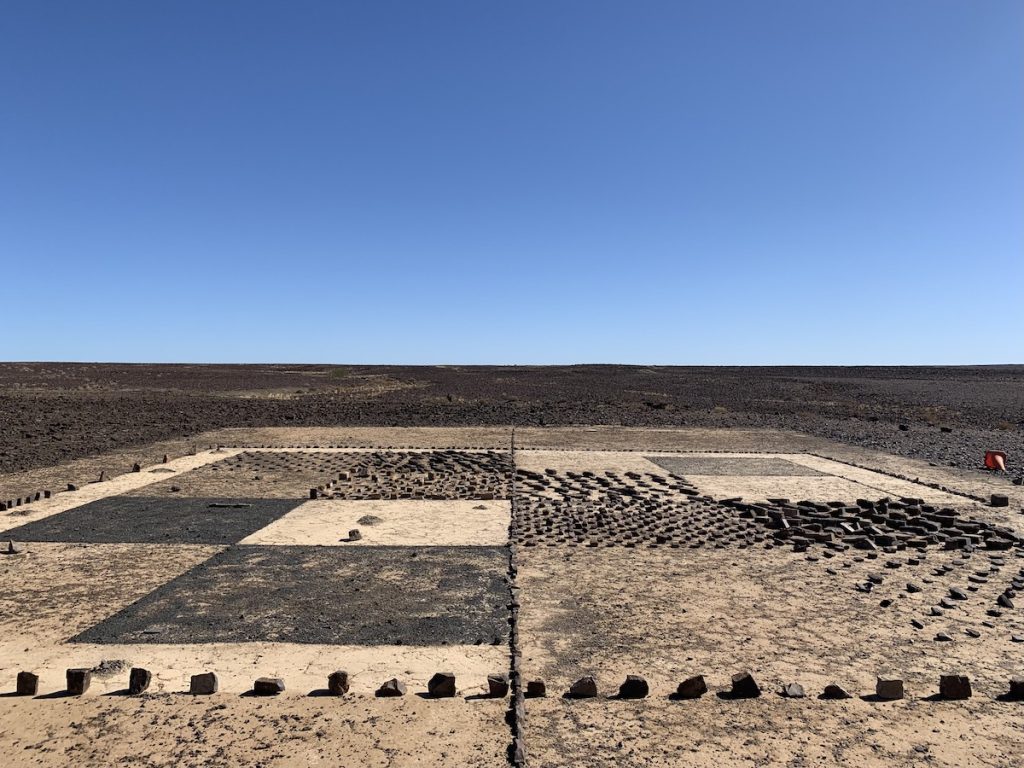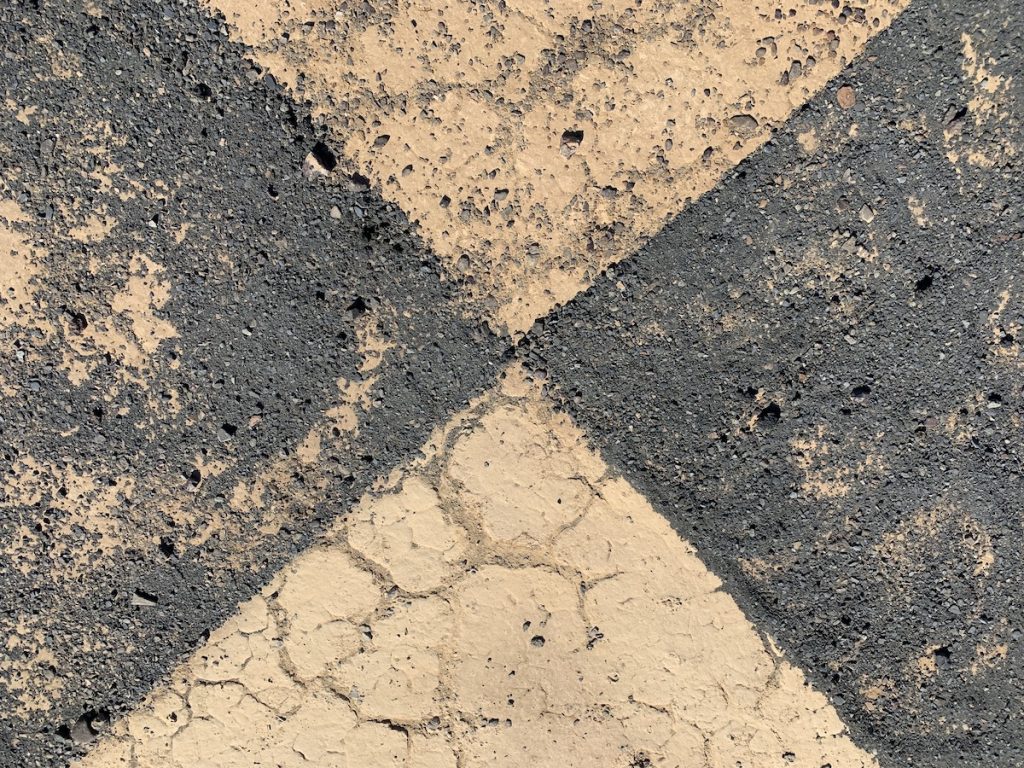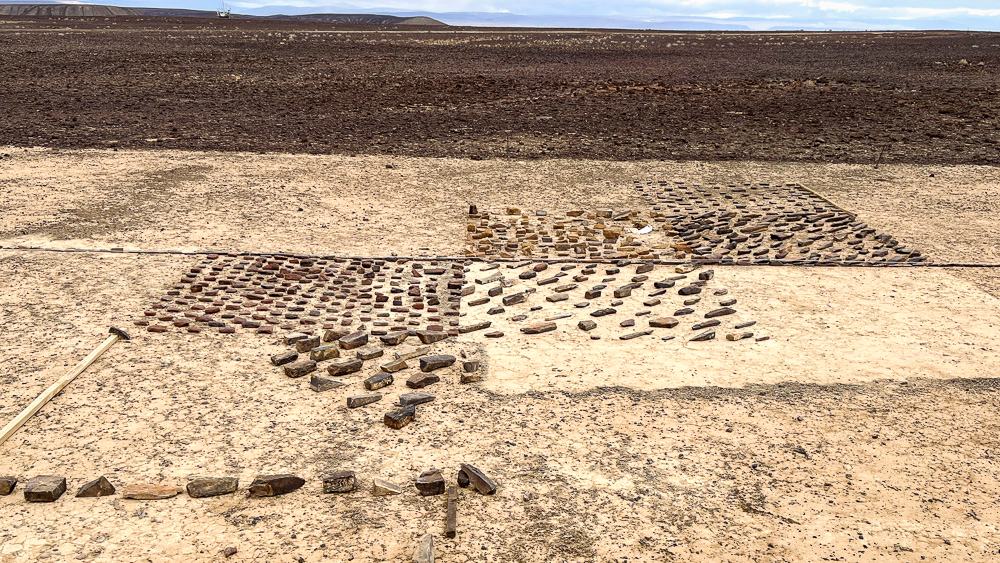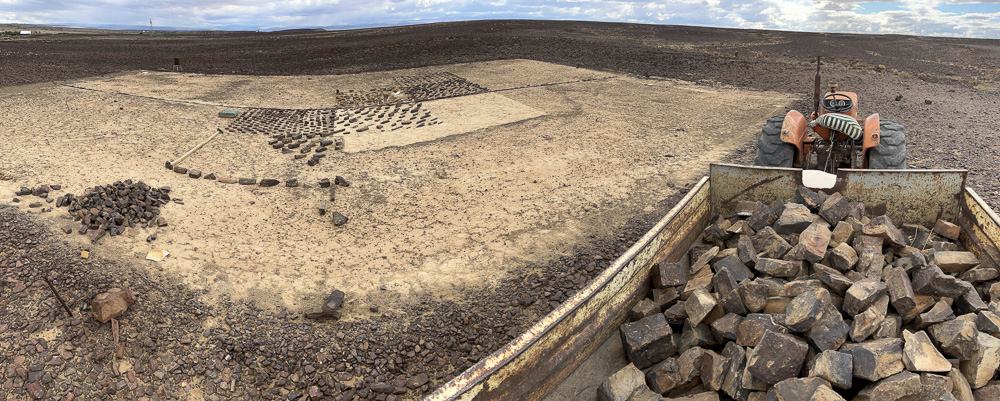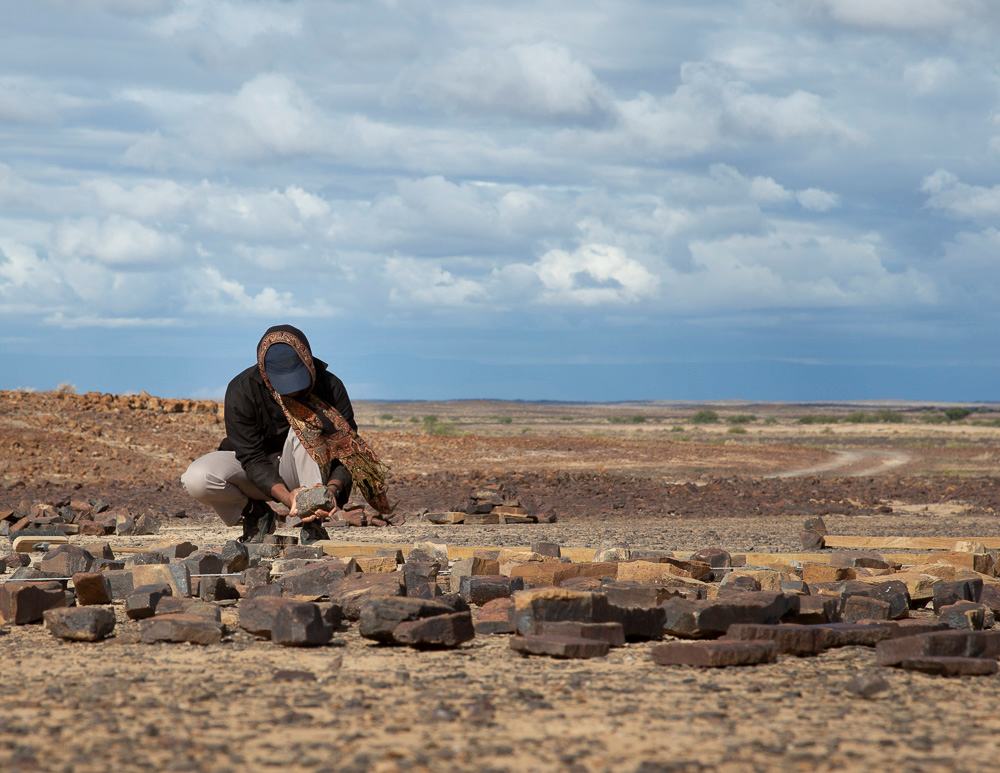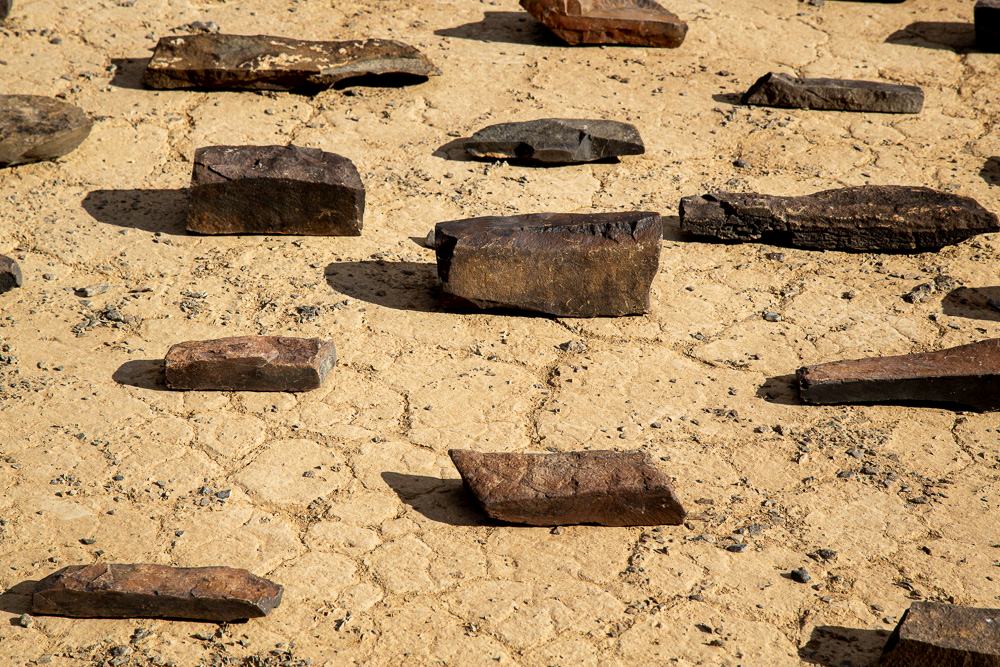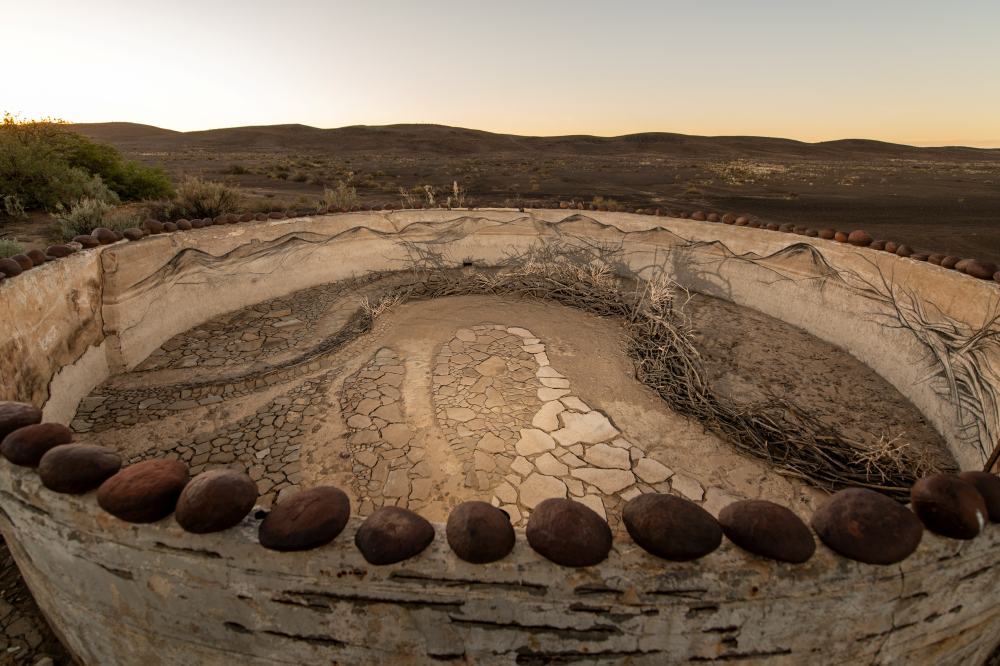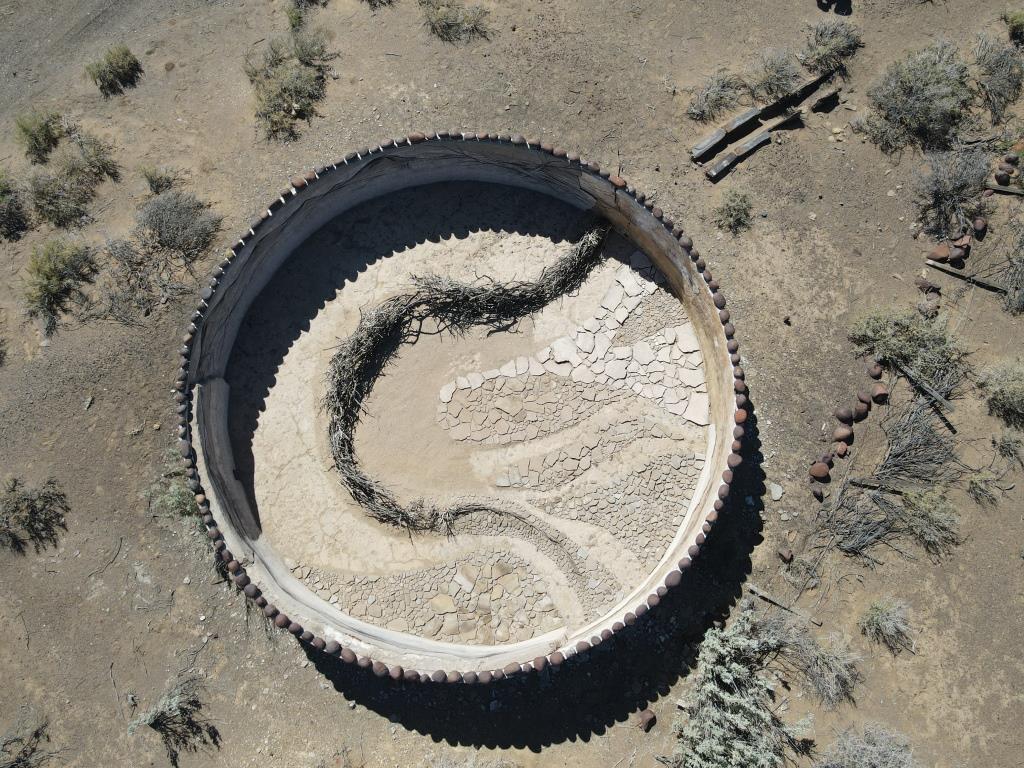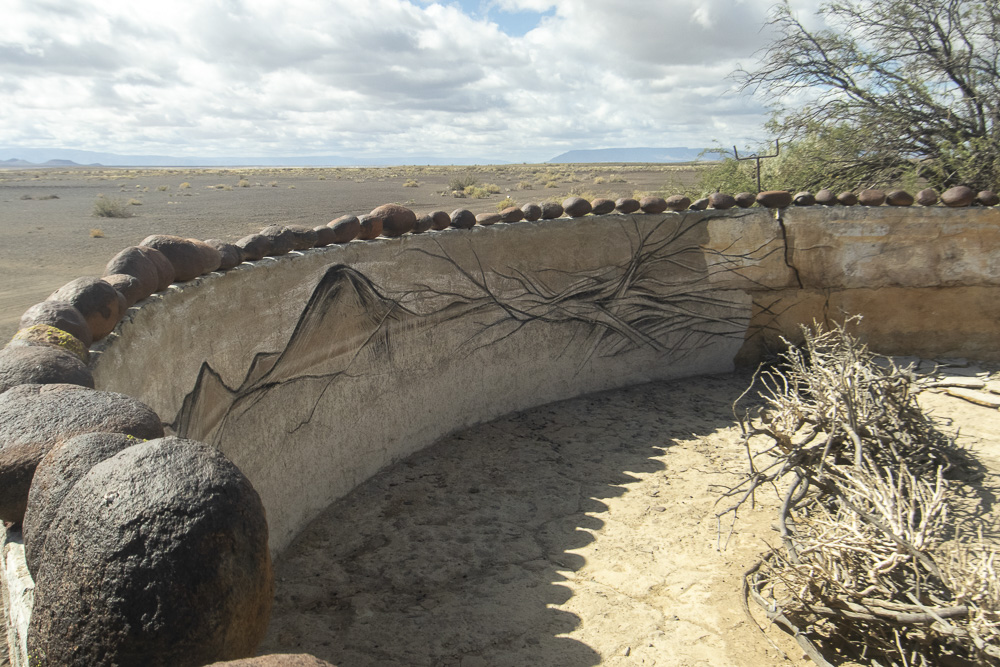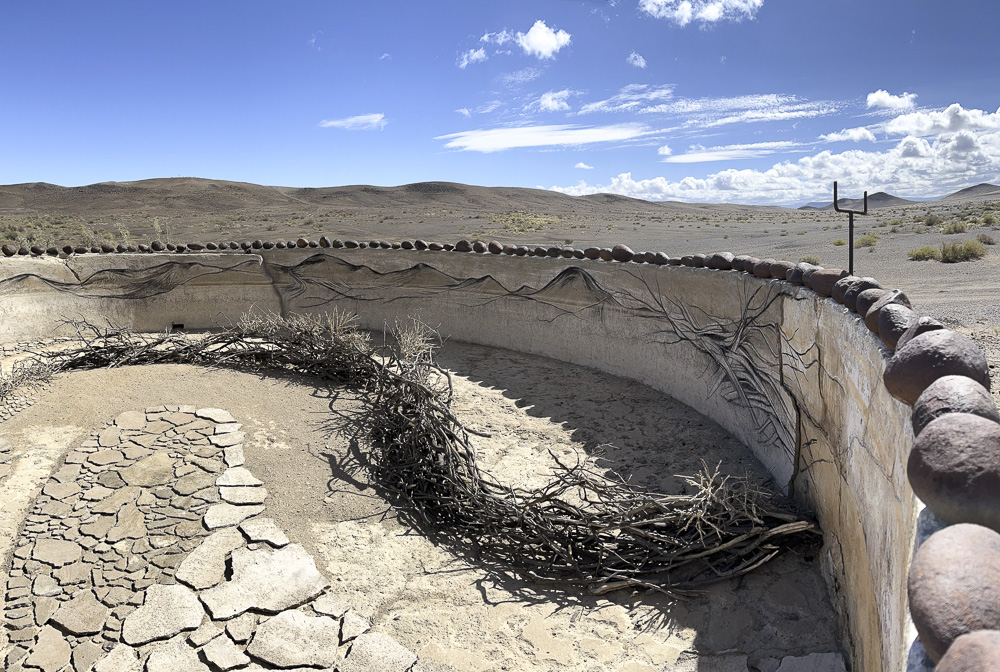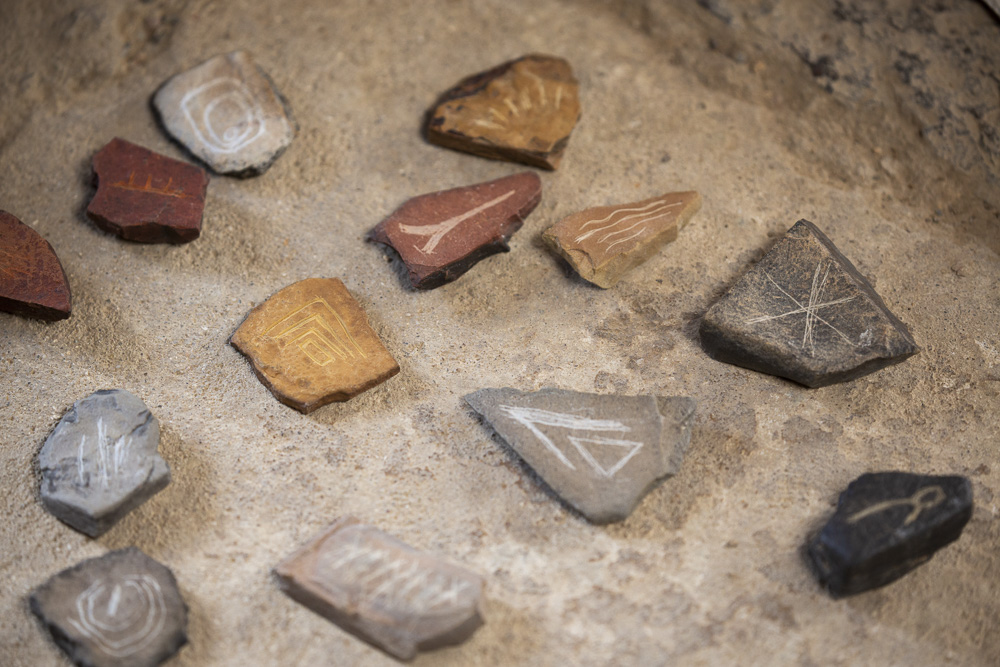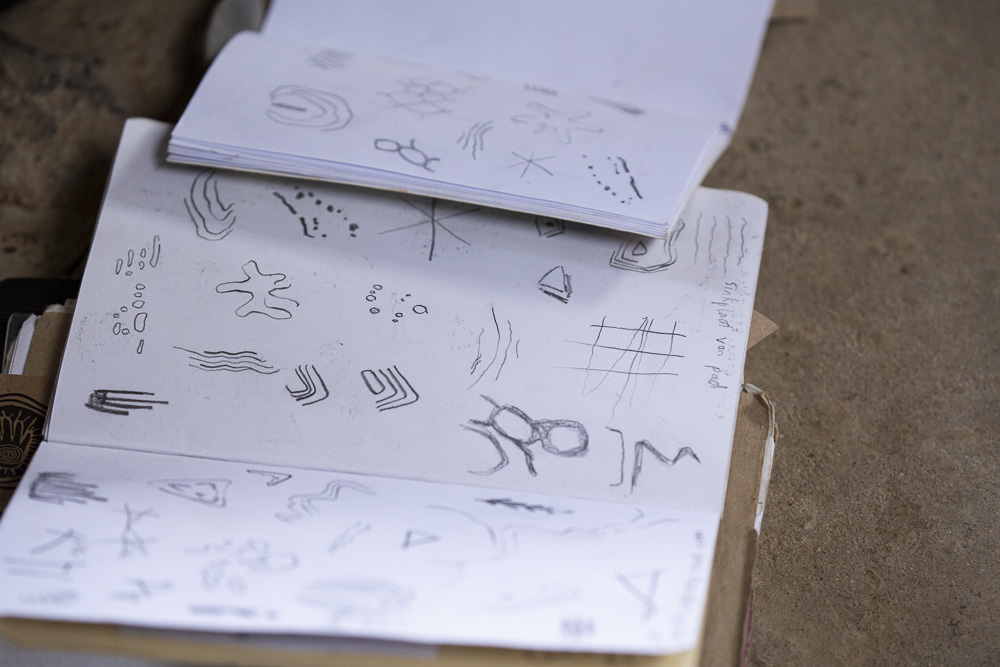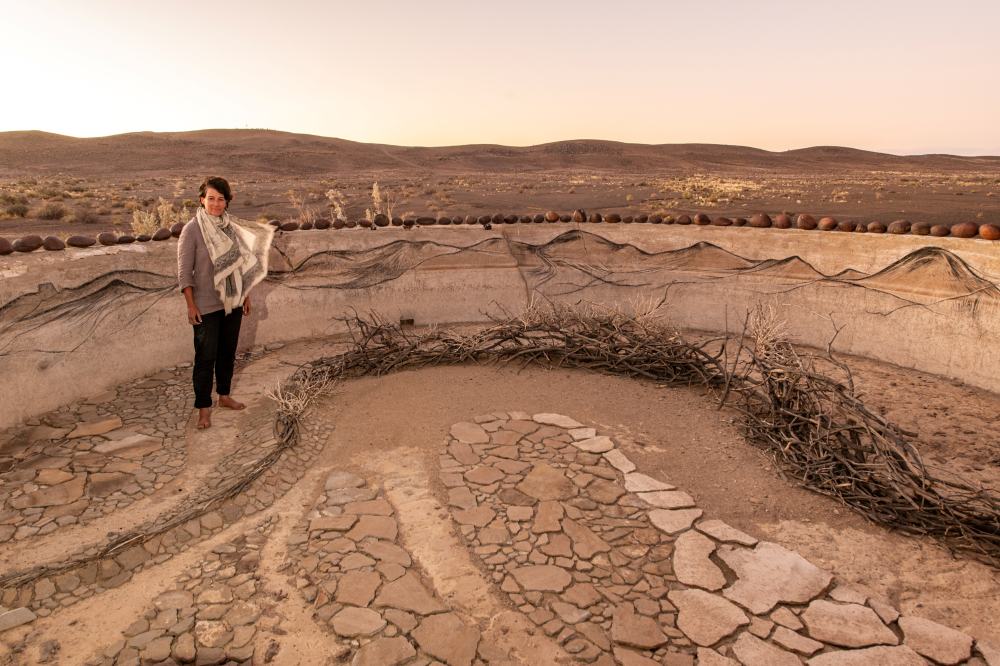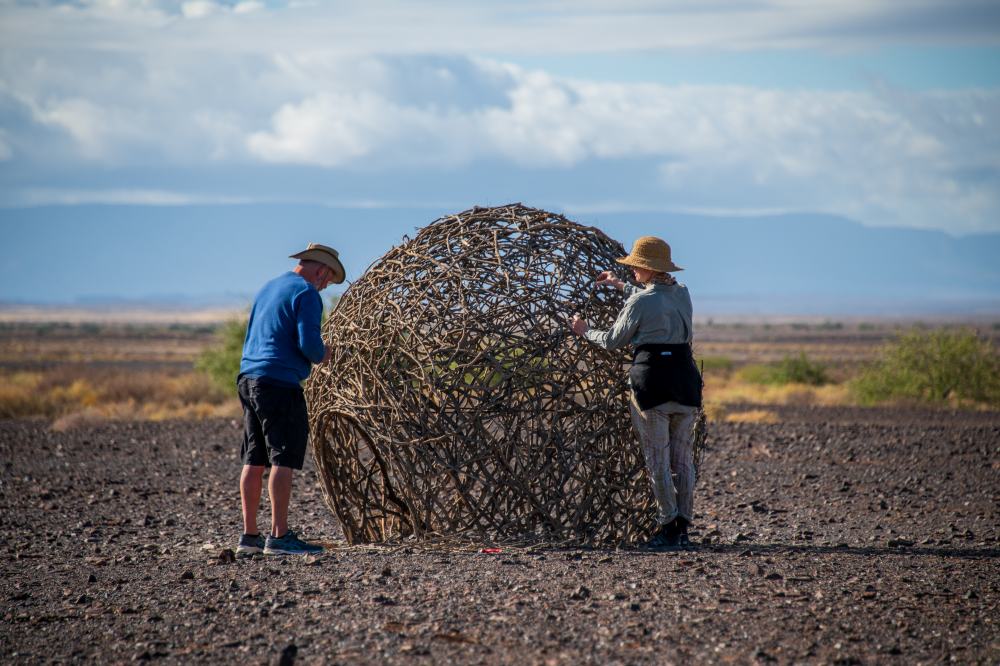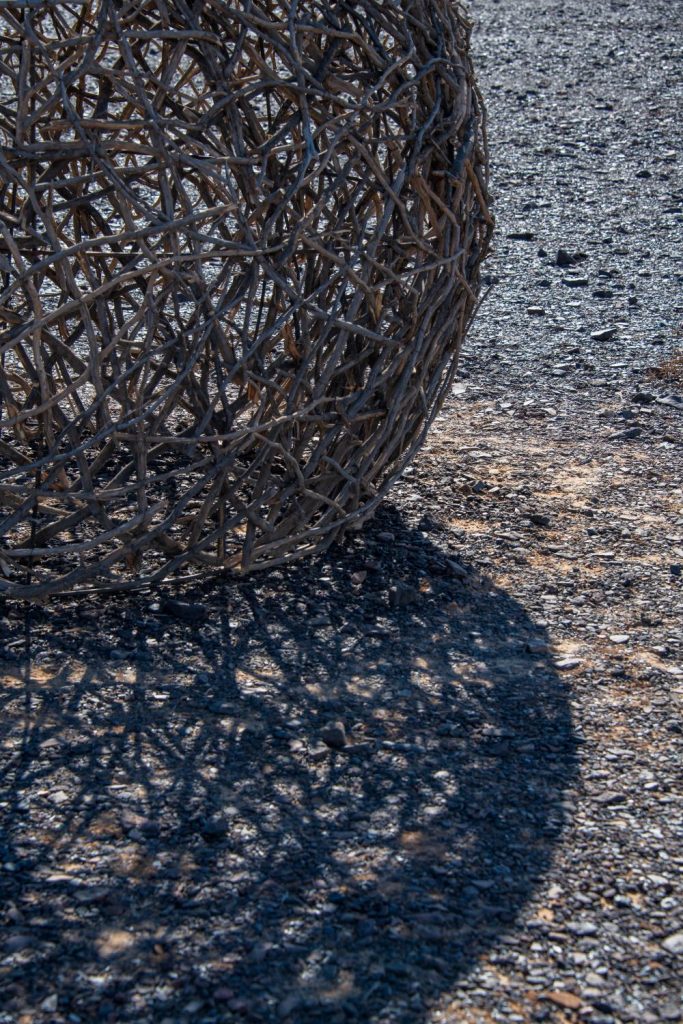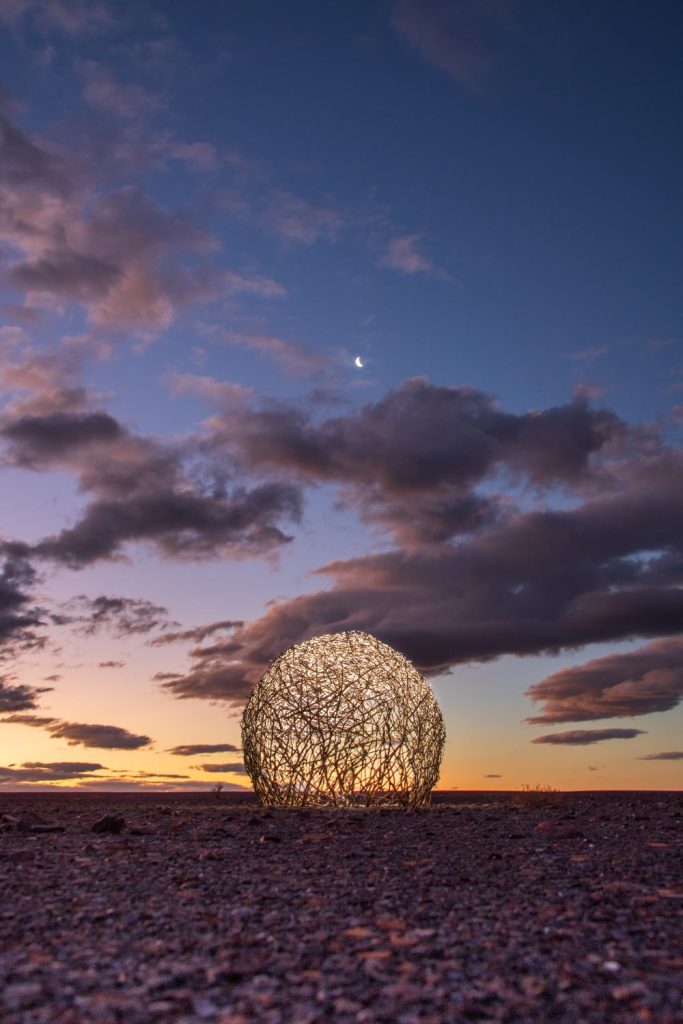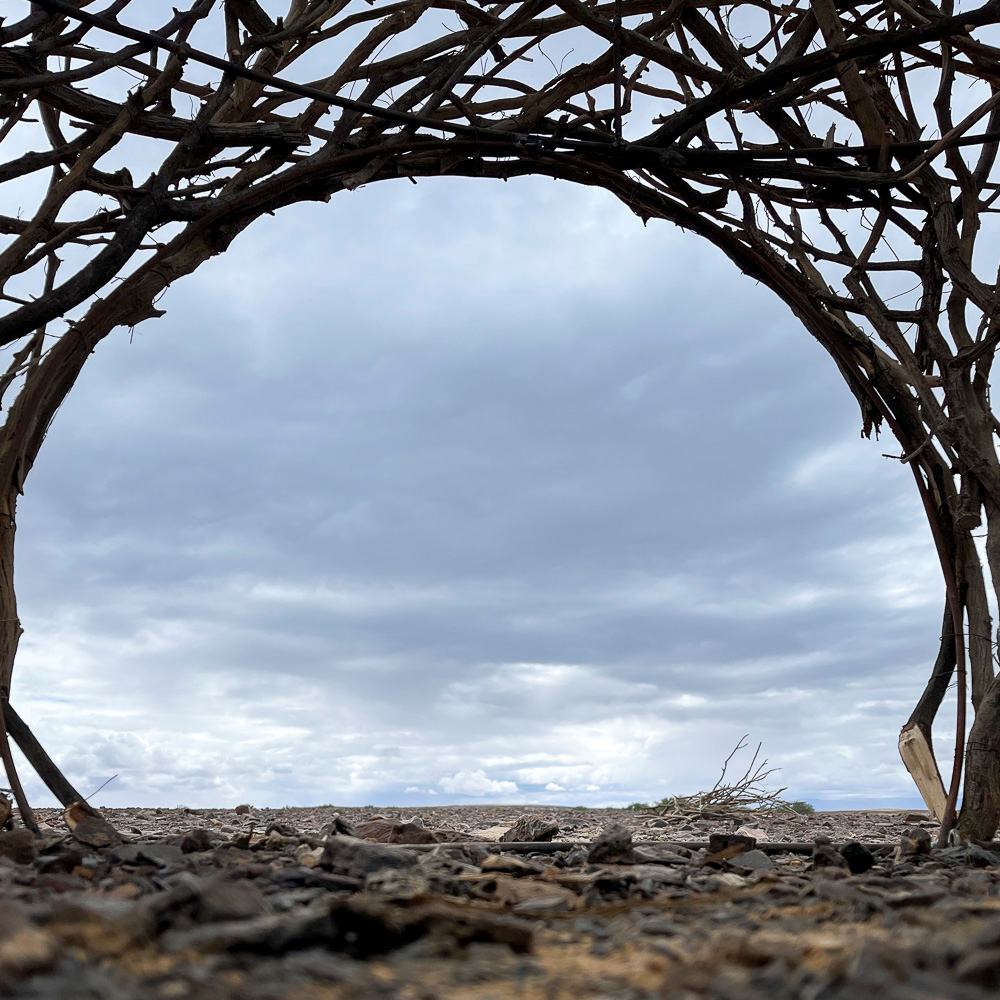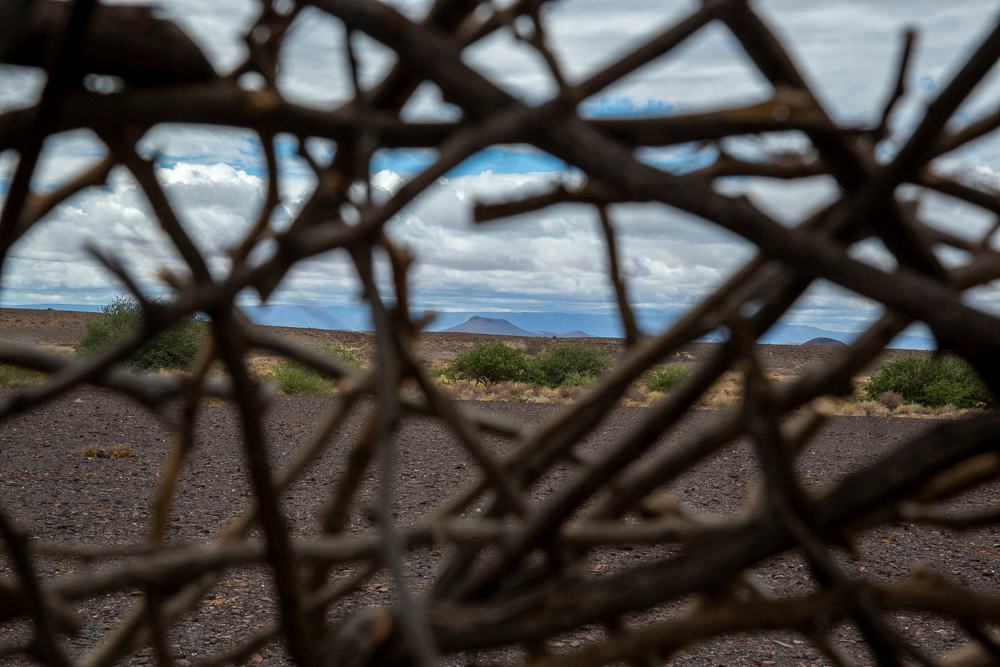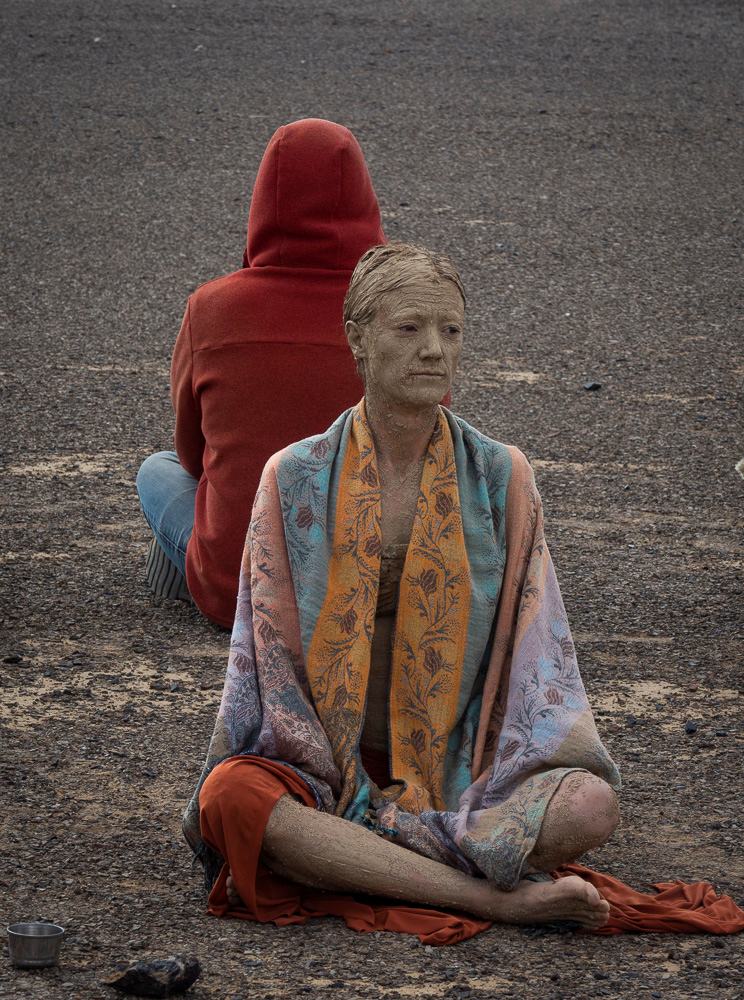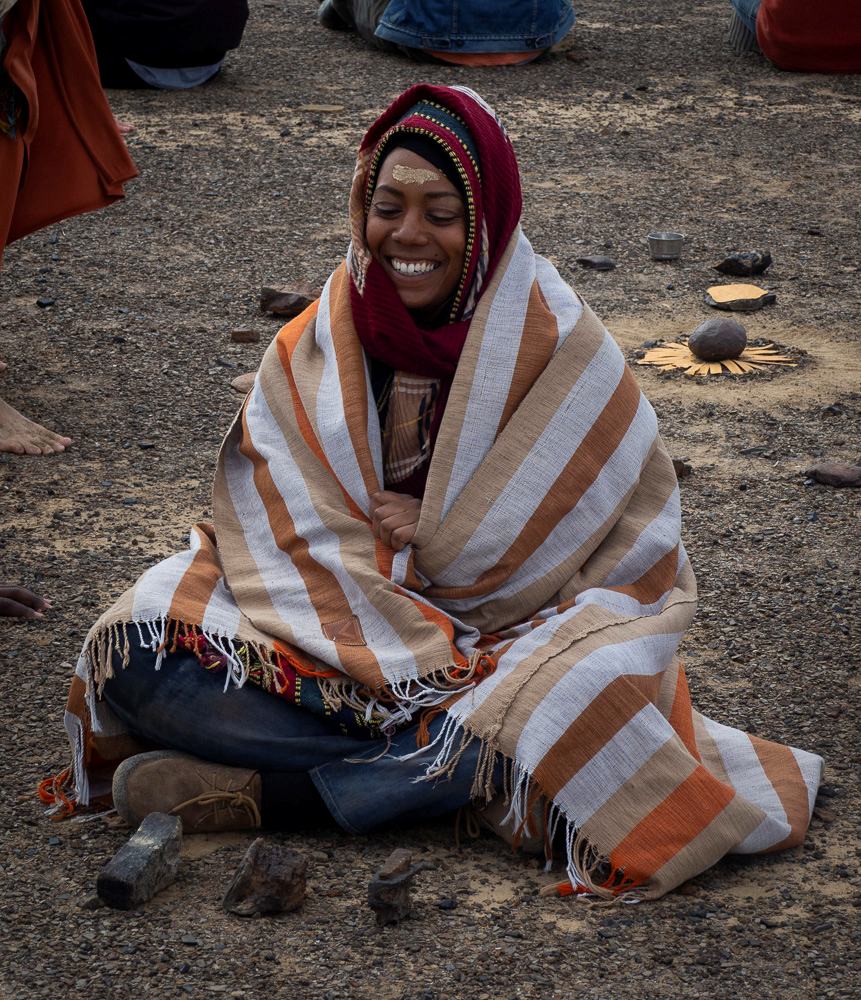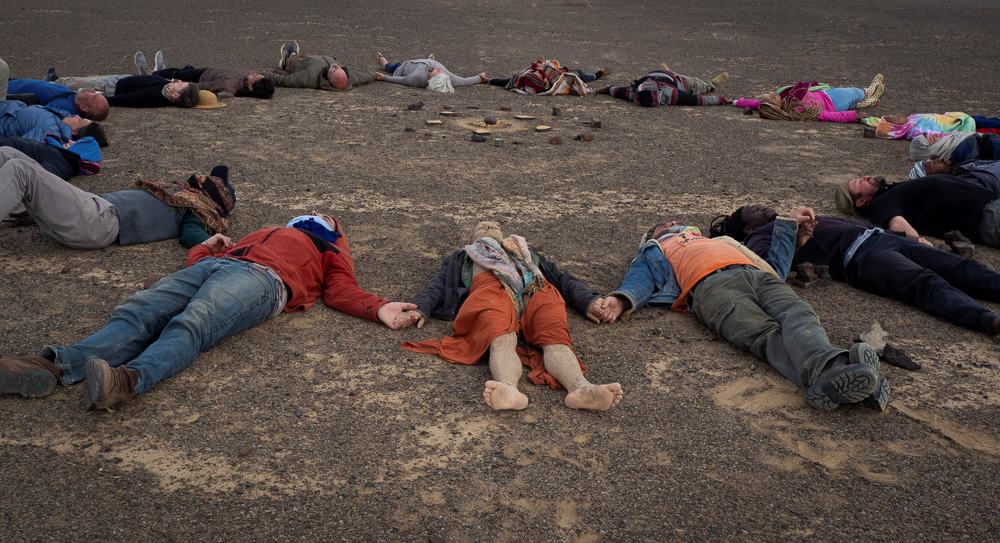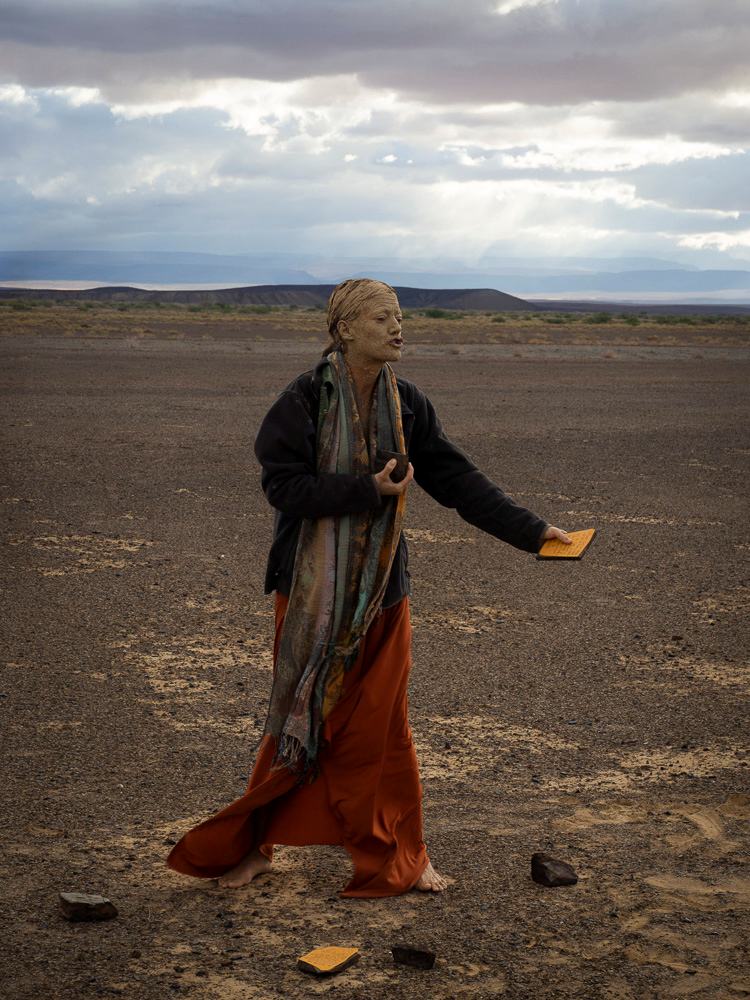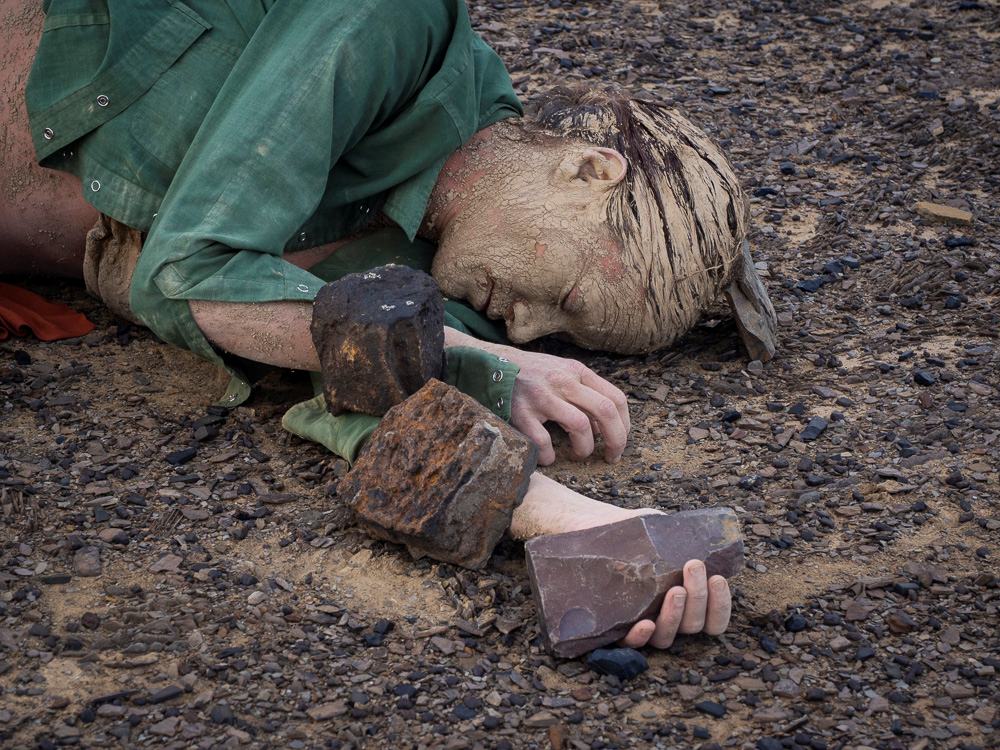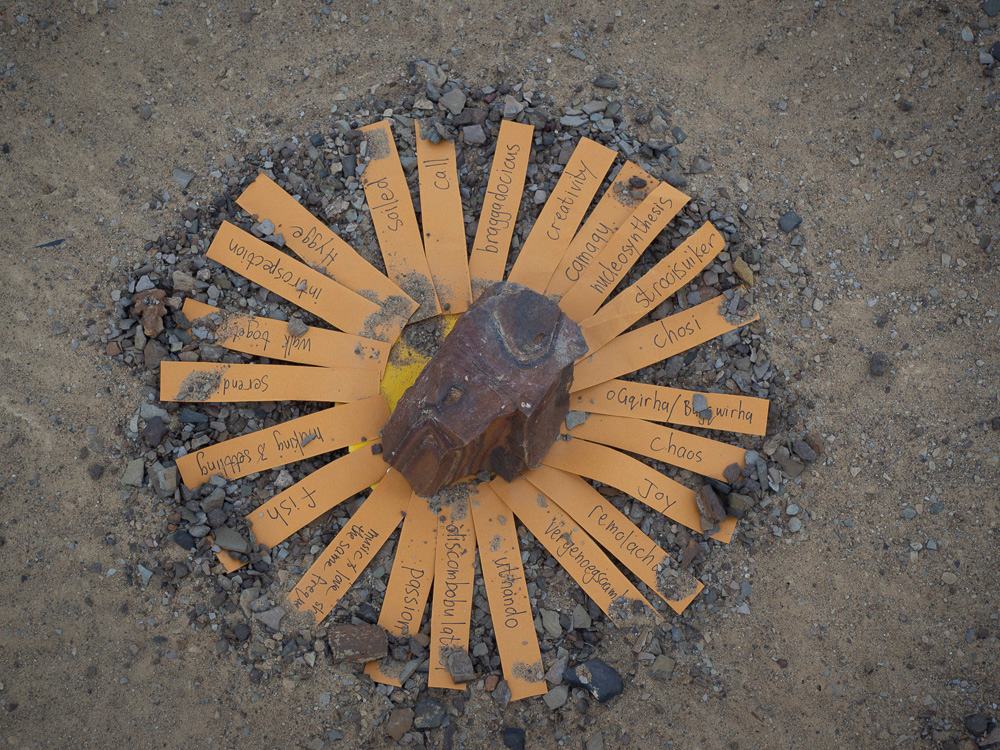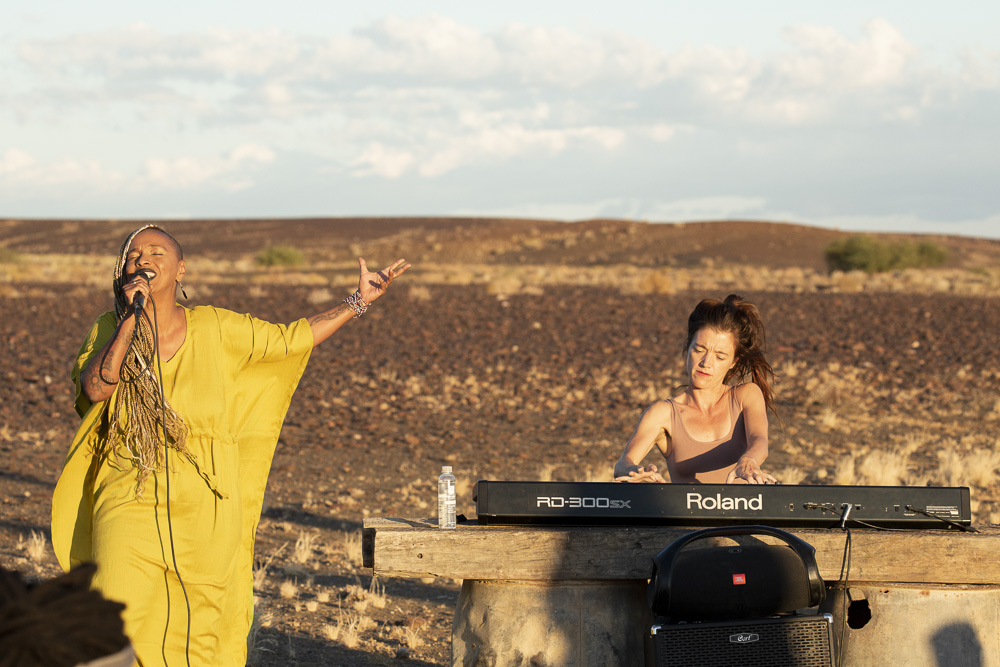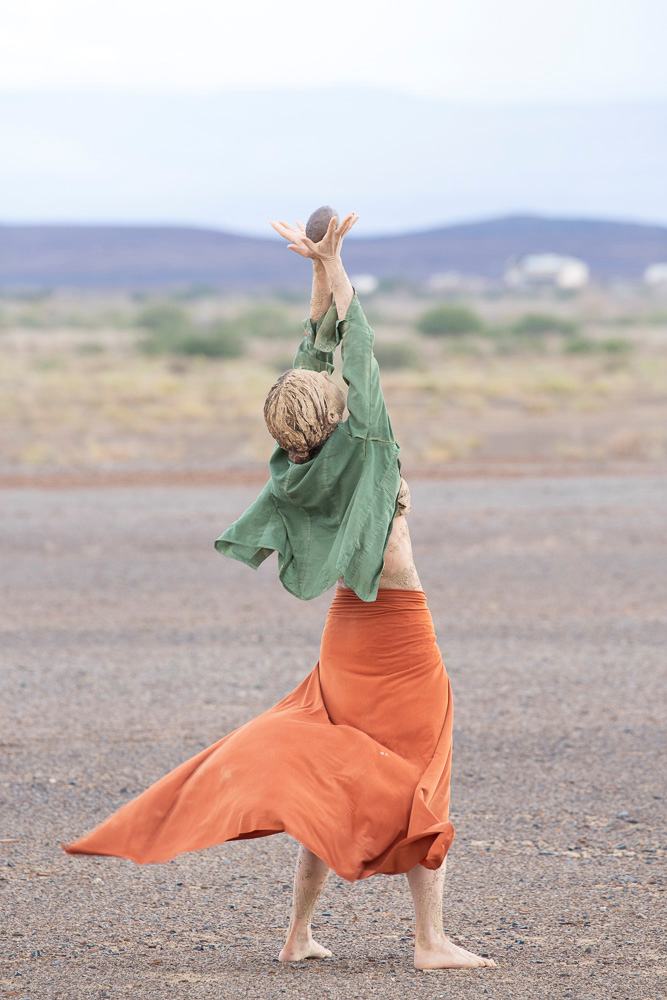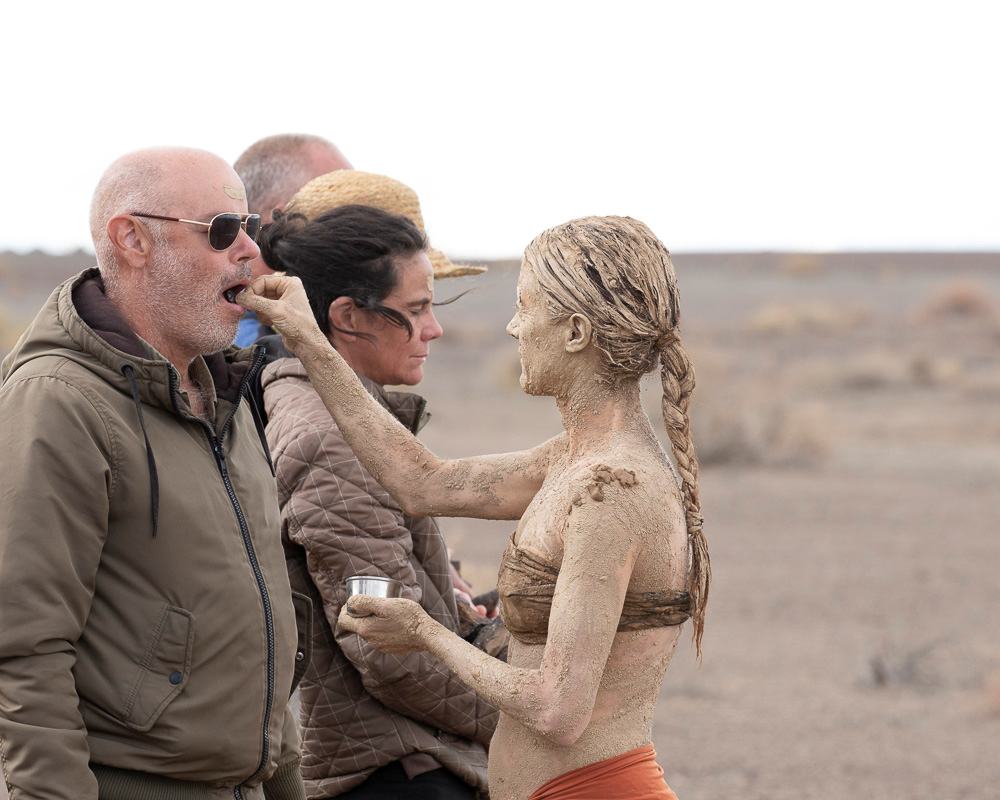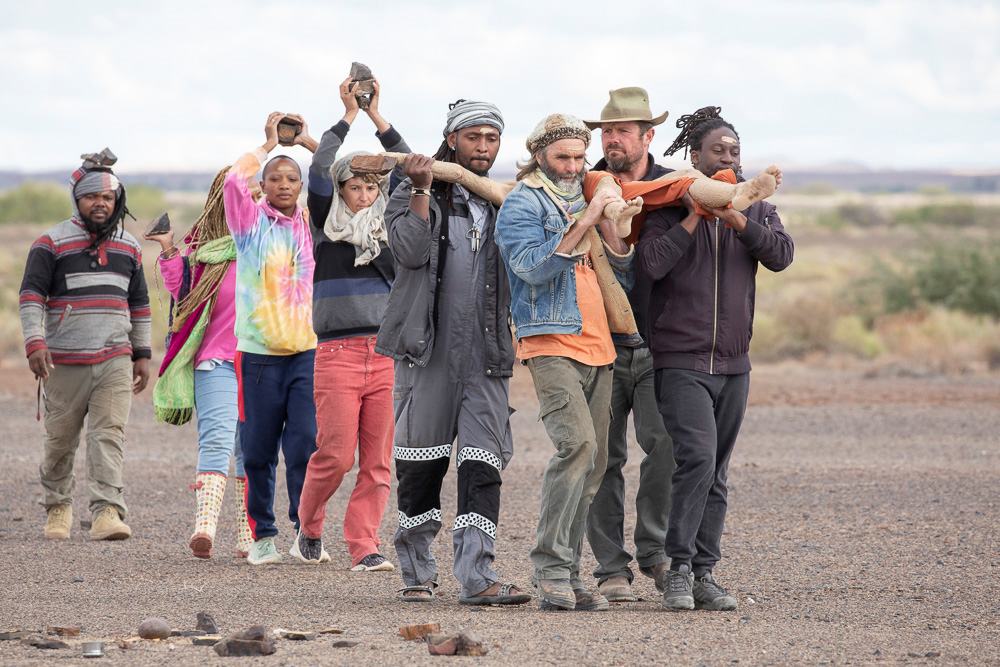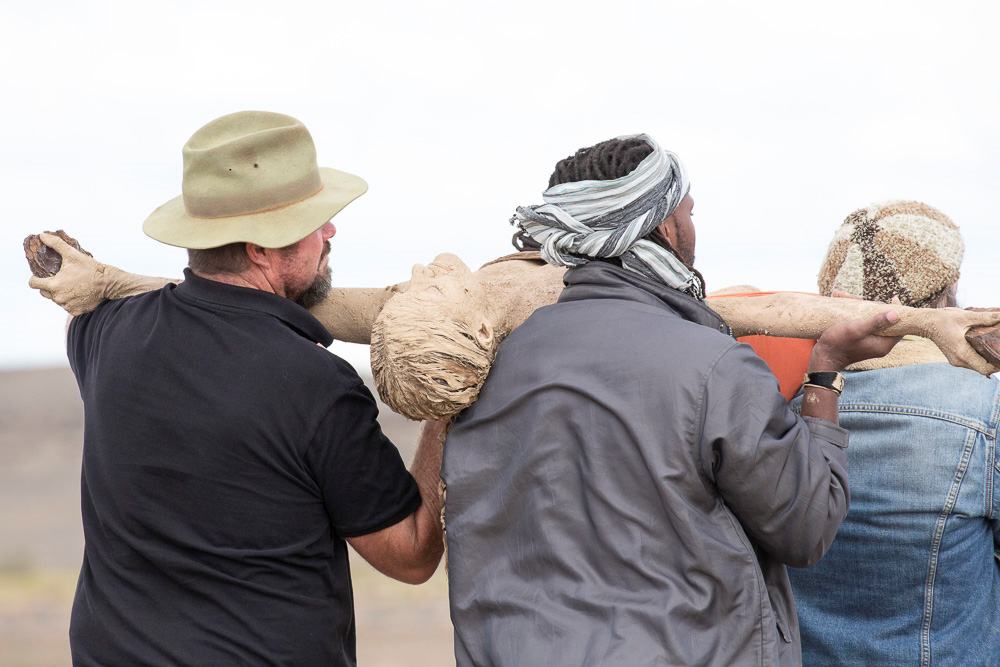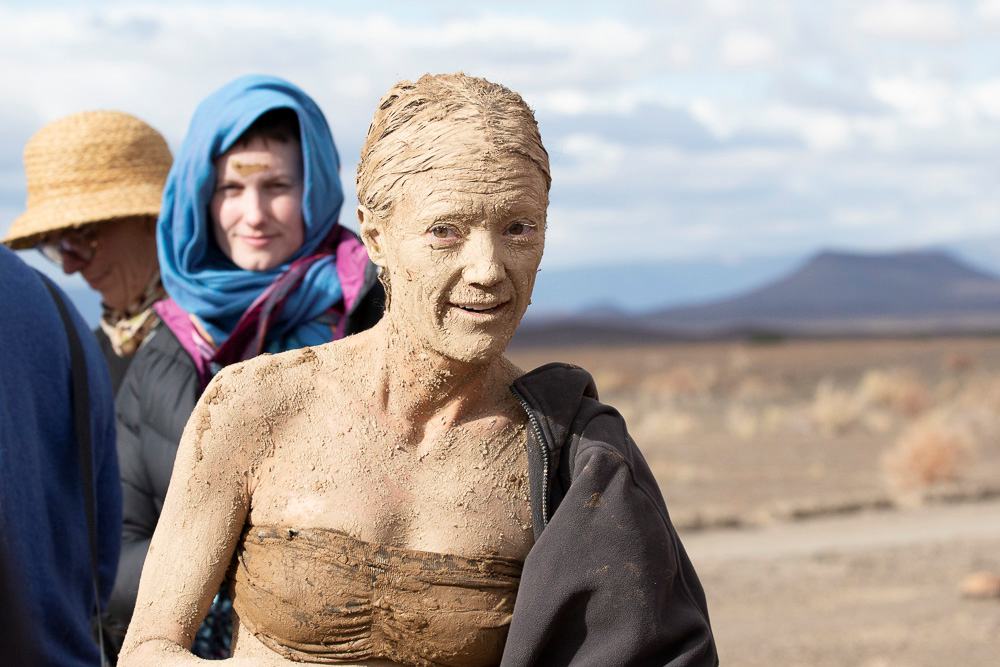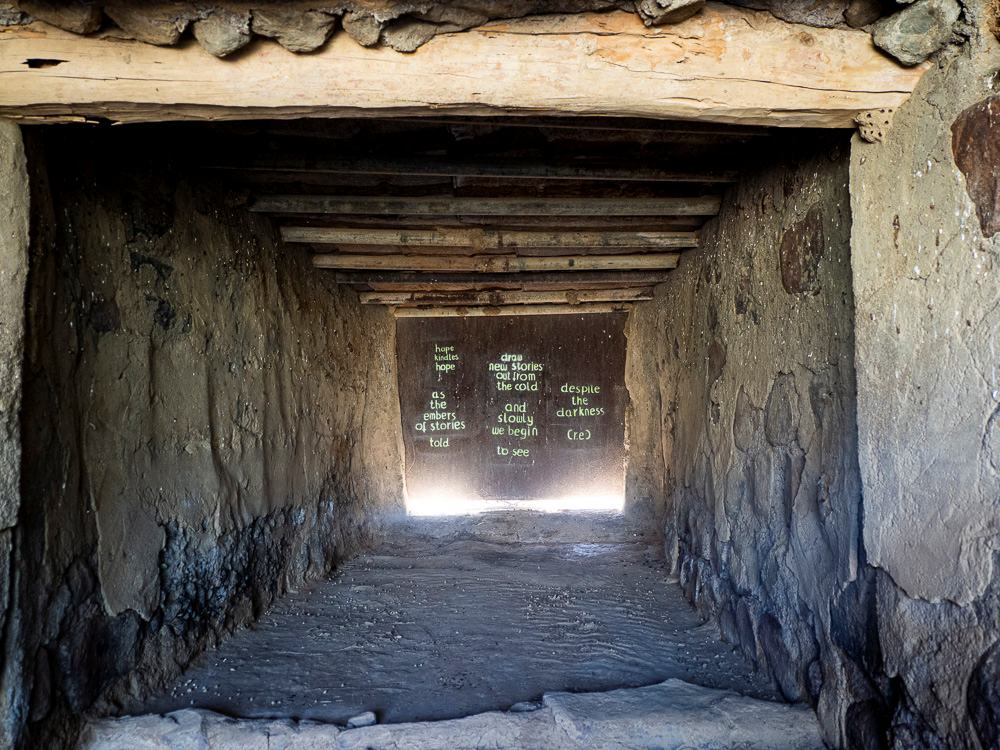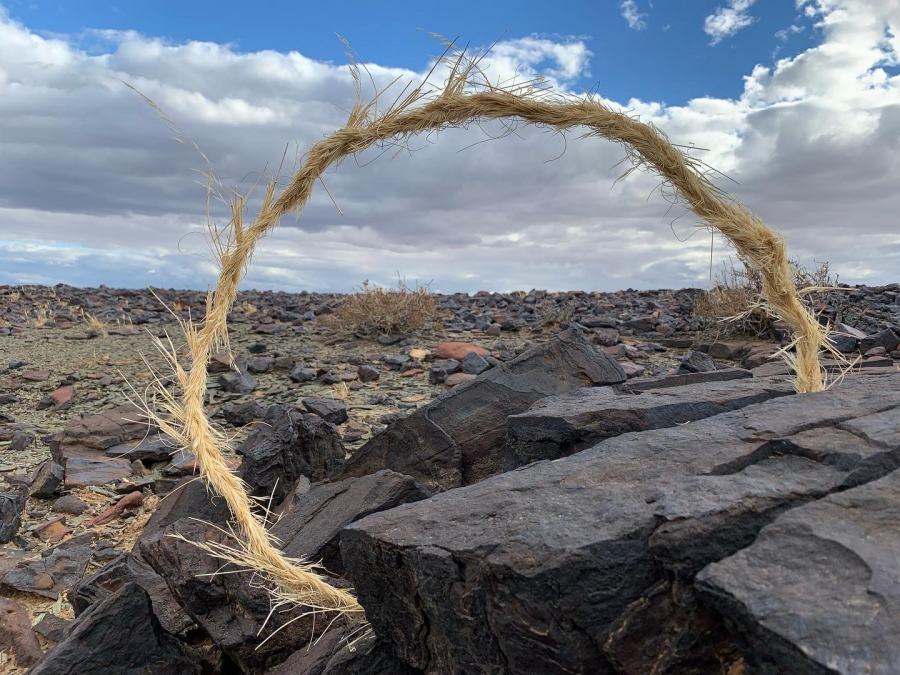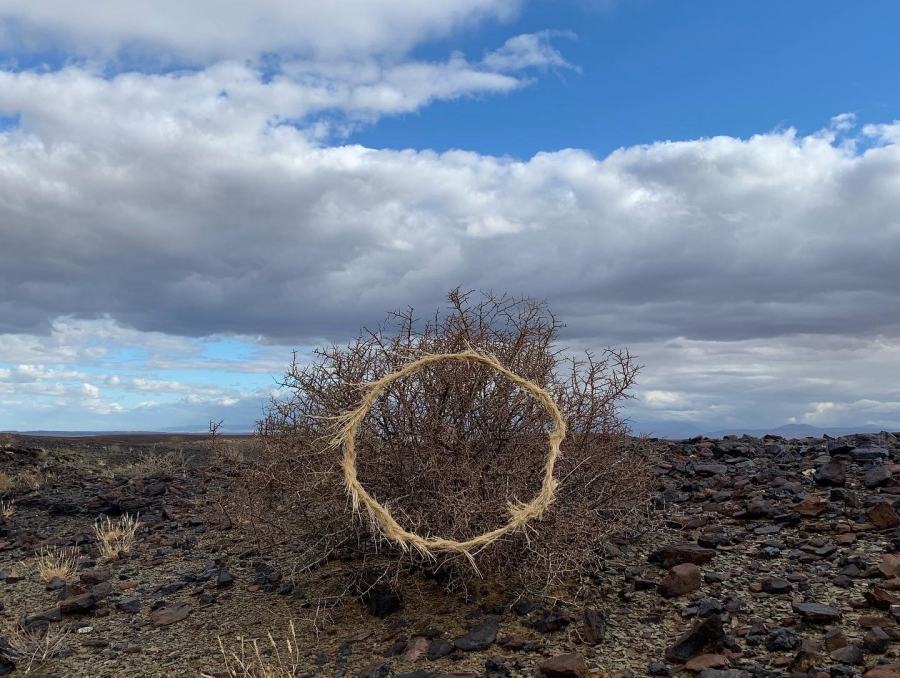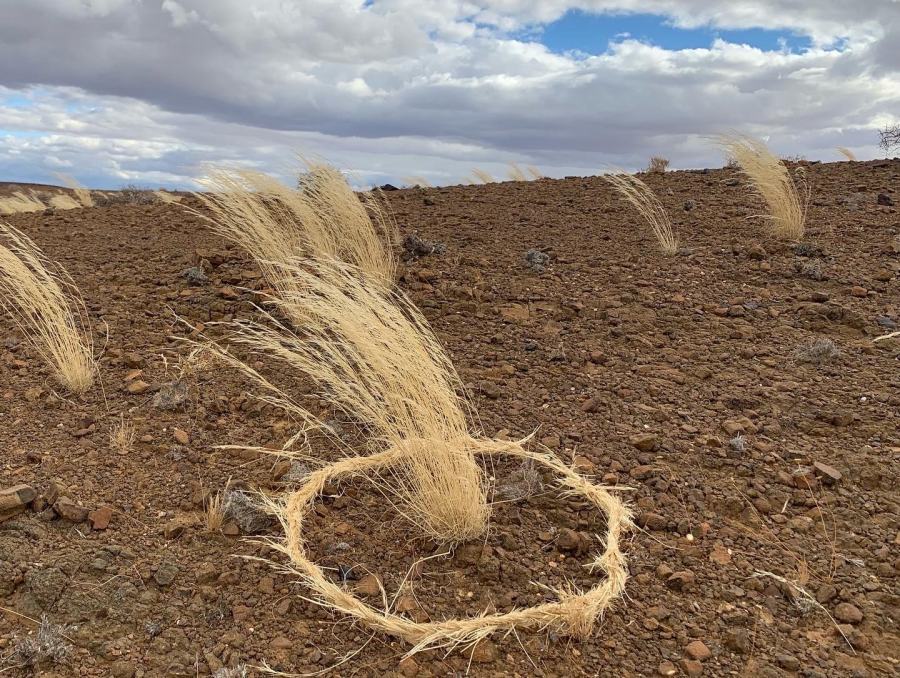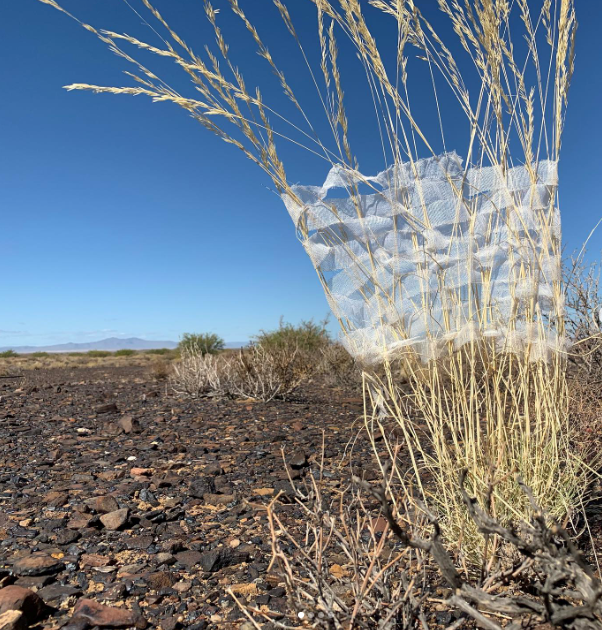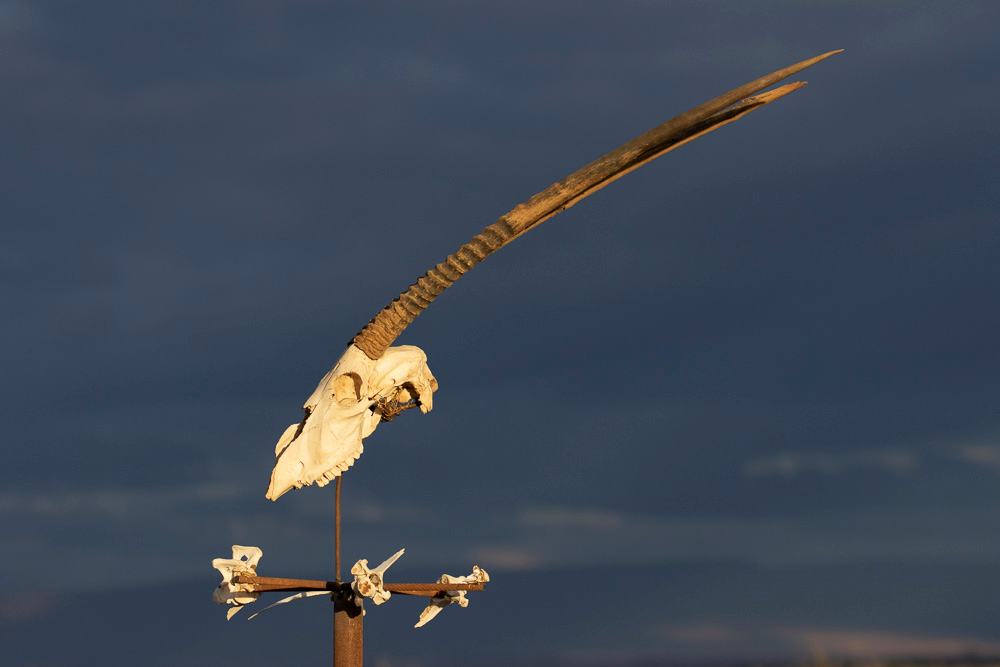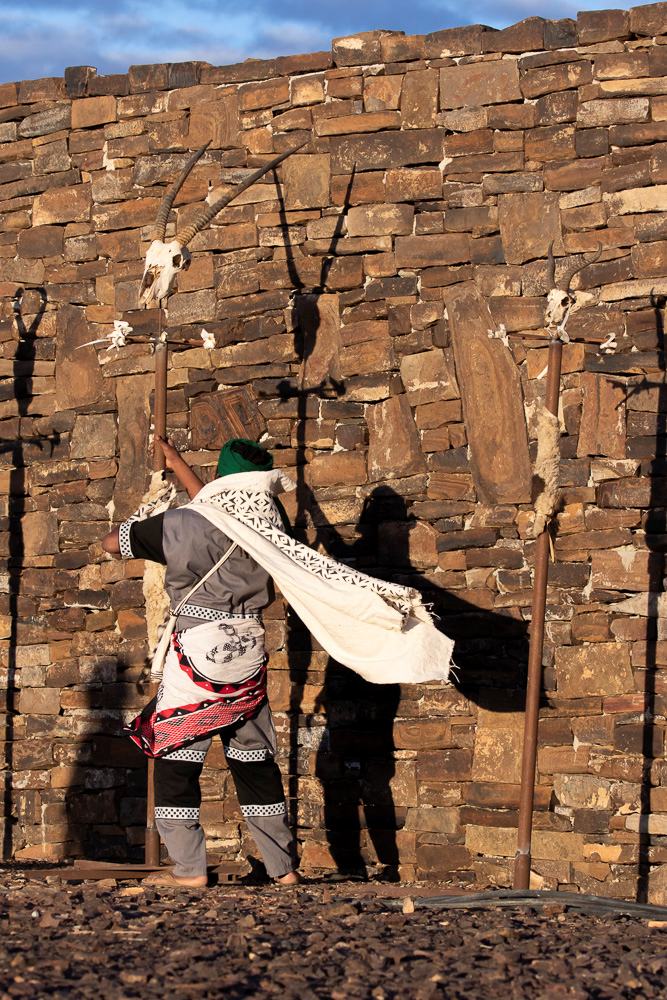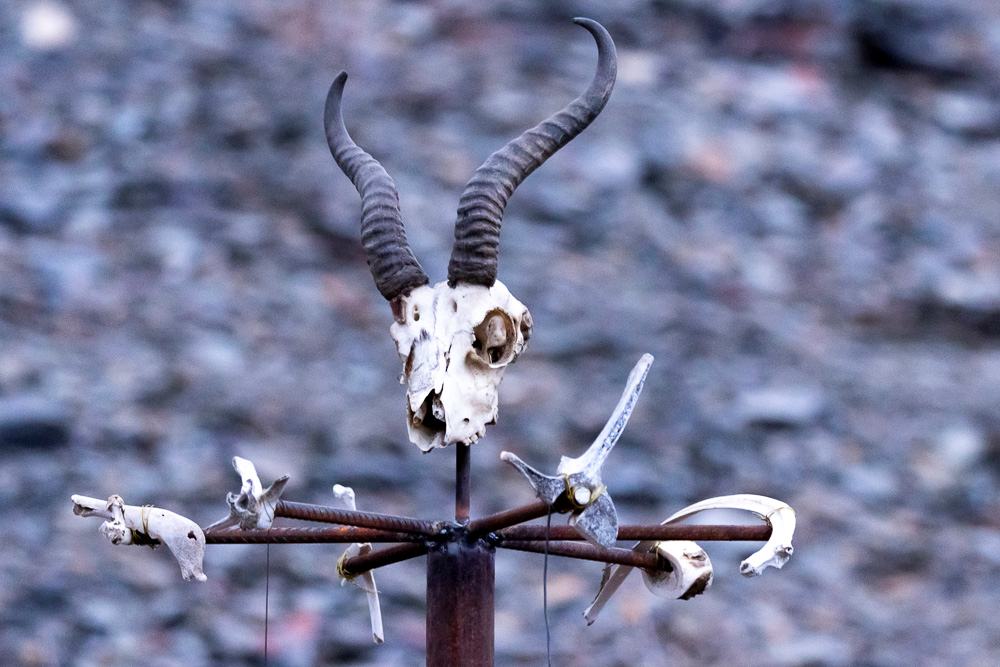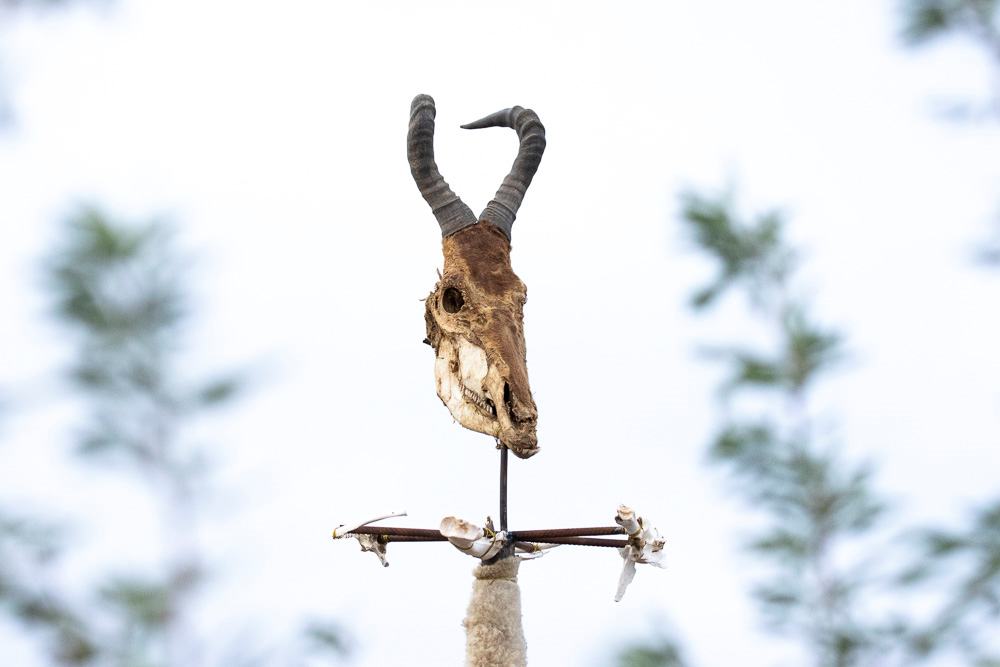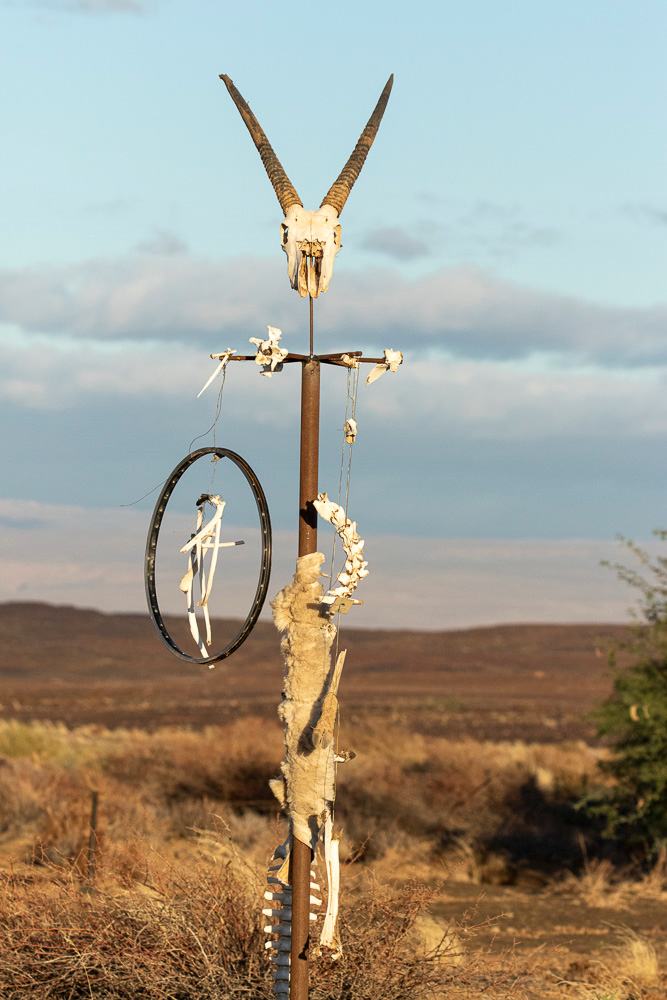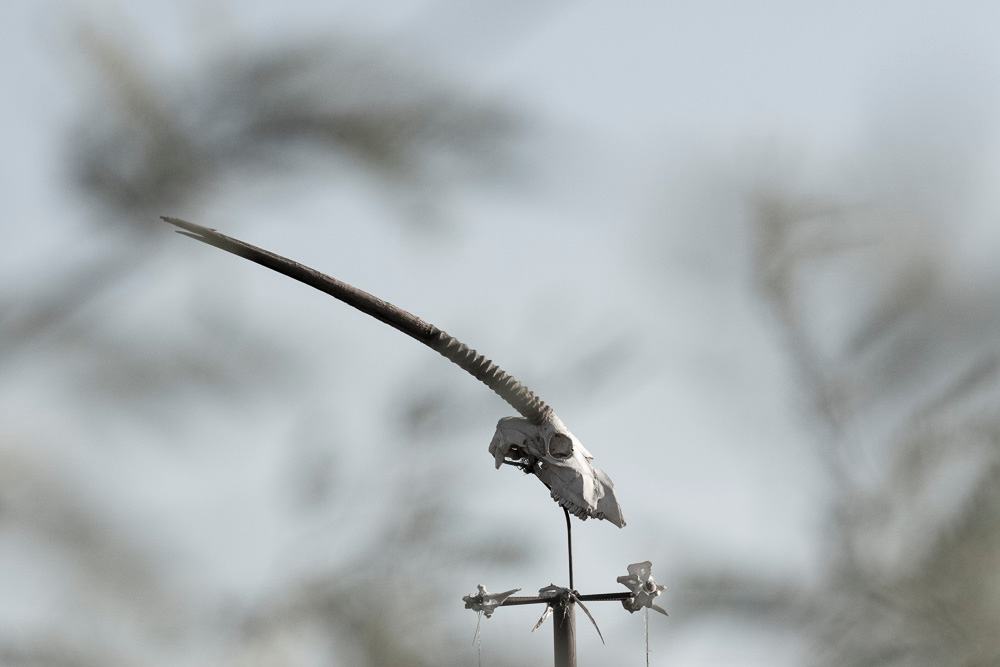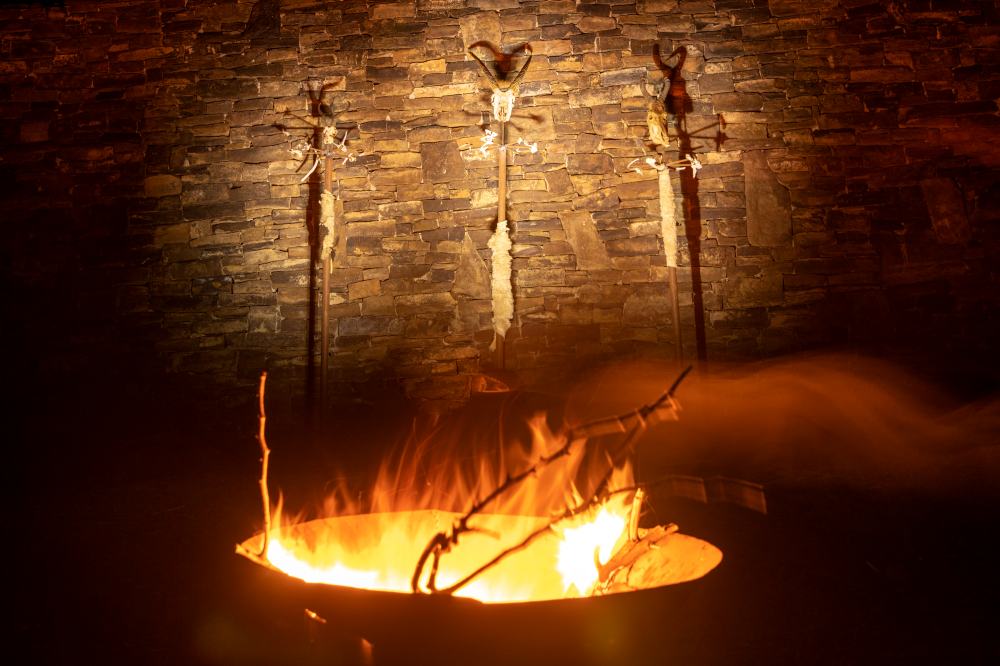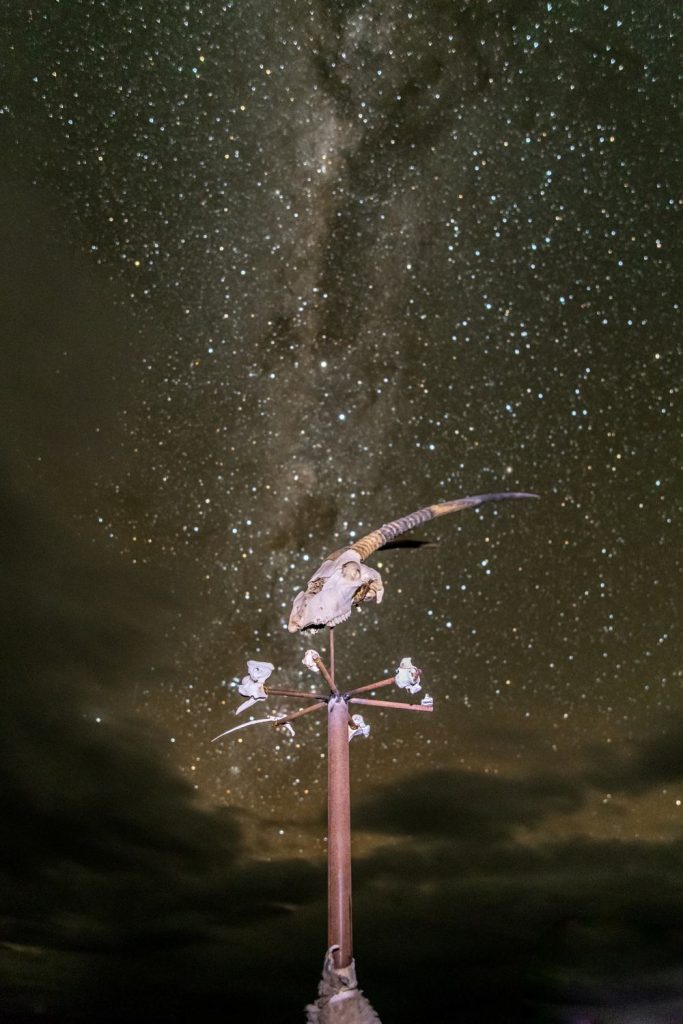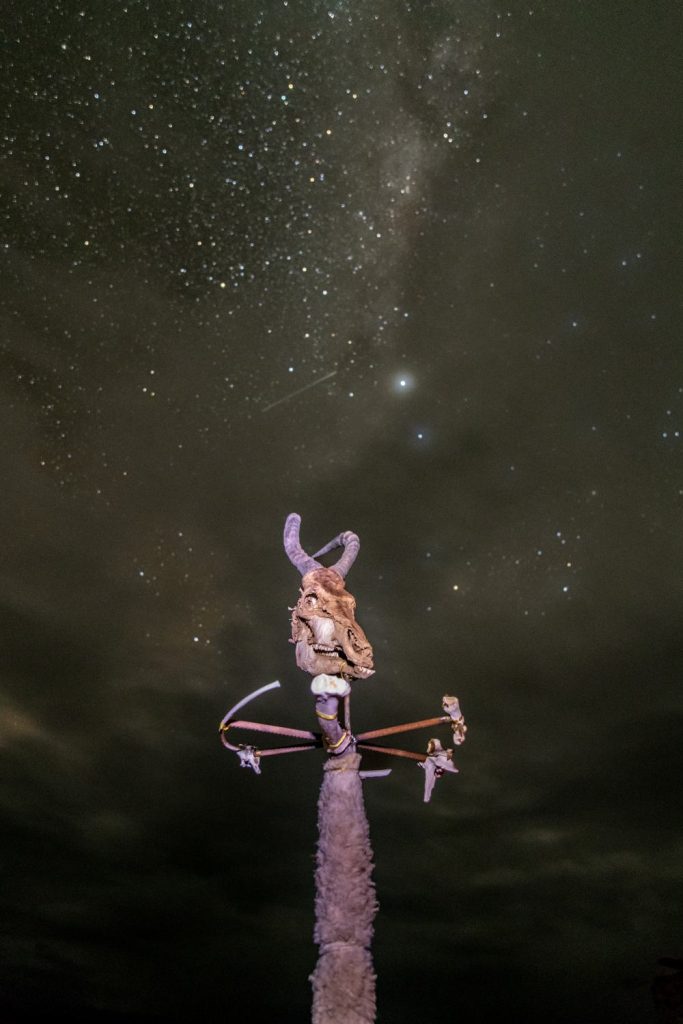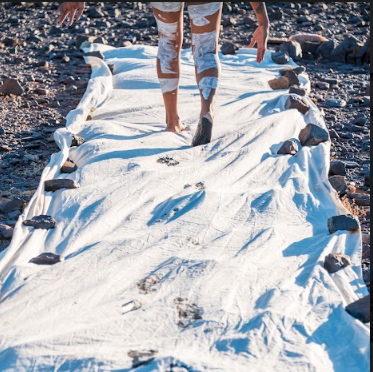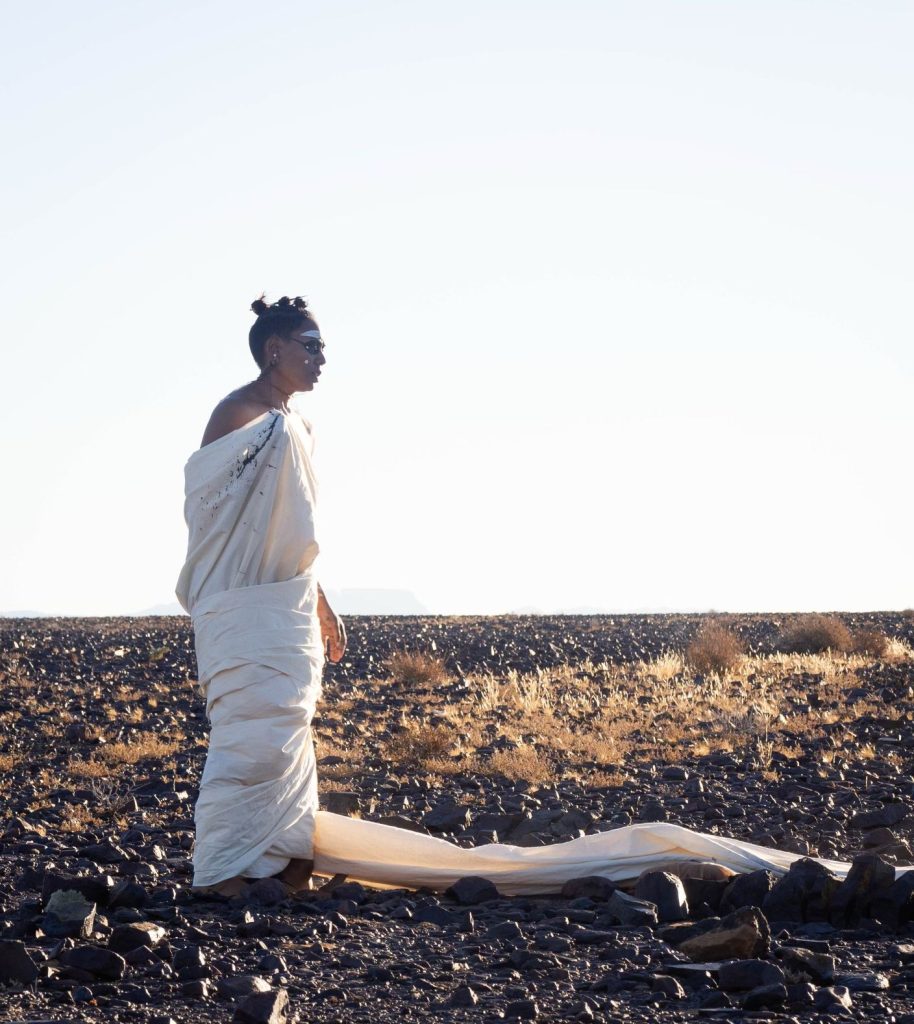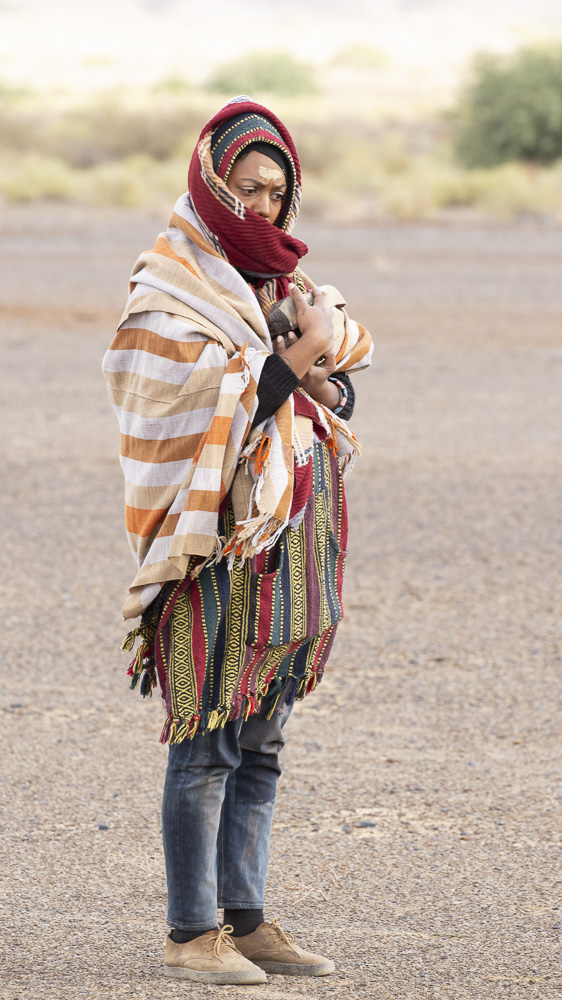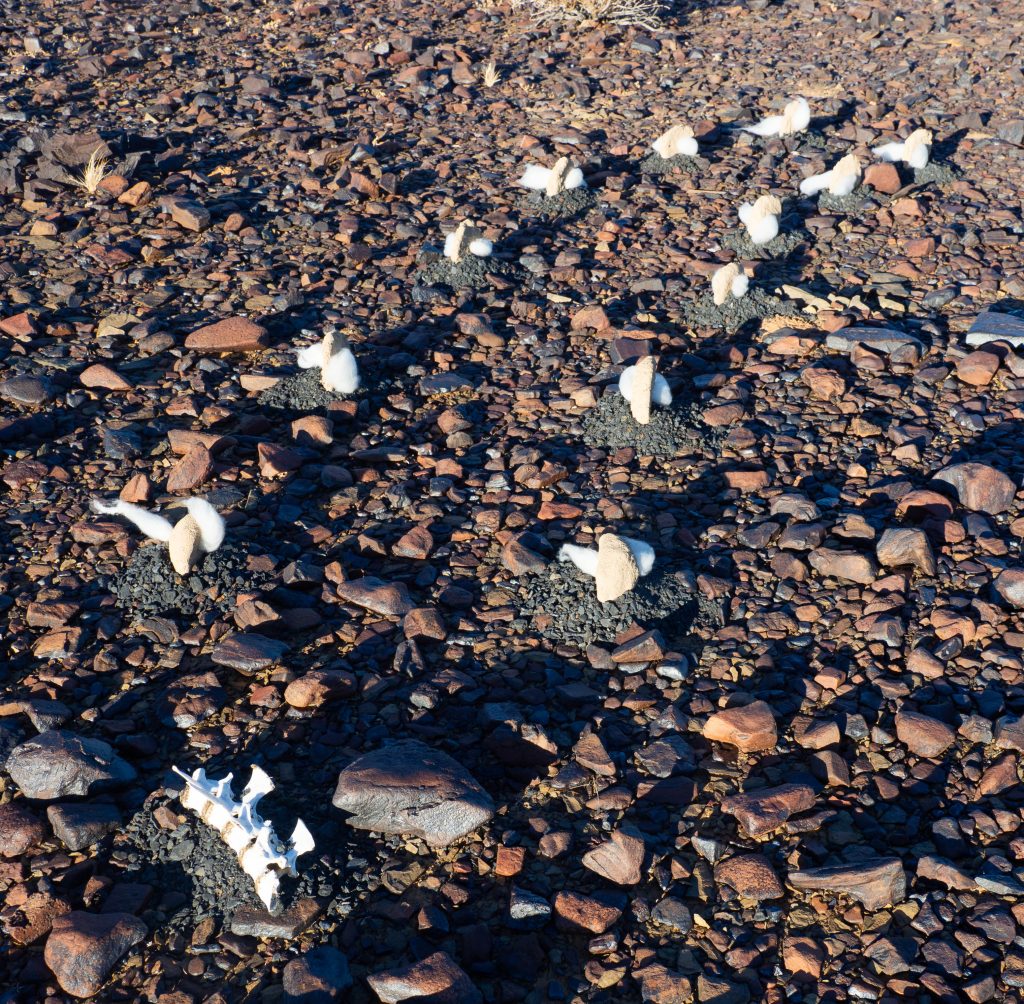Akissi Beukman
Ivory Coast/South Africa
Tout le monde groupé,
pouré tuer les gens,
Mariguillat passe
La guêpe faut pas piquer moi, célibataire.
“Daughter of the Karoo / father unknown“
A song that my grandmother used to sing daily in her moments of solace. A small but potent way of reconnecting with her. She is ever-present in my life as a namesake and a spiritual force. In all my work I feel her calling and in this offering, I called on her for strength and endurance.
Inspired by the ‘goli’ and its familial iterations ‘kpwan’ (the mother) and , more appropriately, for myself ‘kpwan kple’ (the daughter), intercessors of the ether.
A ritual ceremony to help aid in times of earthly struggle.
The figure I carry on my back in patchwork and wire is a portrayal of the weight of unknowing, unlearning, and relearning what it means to carry these spirits in my blood.
Crossing the vast Tankwa landscape, once again, at the mercy of the heat and wind, over a silent riverbed that lit up in sound as I stumbled across it.
I am referencing Queen Pokou the fierce leader of the Baoule people who missioned away from impending danger in their now crumbling Ashanti empire.
They reached the river Comoe which was impassable after the rains and the river gods demanded a sacrifice of noble blood to let them pass, it is said that once she had sacrificed her only son, hippopotamuses rose for her people to cross over to safety in present-day Côté d’Ivoire. She wailed at her son’s sacrifice “Ba Wouli!” And thus the ‘Baoule’ people gained their name.
In this ode, I am reflecting on the power of a spiritual and physical burden, the membrane that connects legend and truth of a powerful being that took on the duty of saving her people so as to hold onto their stories and language and practices.
Very similar to how the culture and traditions of the San people have succumbed to colonial erasure.
By calling on a legend my ancestors are deeply rooted in, I attempted to plead with the same energy, the same gods to heal this land.
By using the sacrifice of the self, the painful journeying and pilgrimage to the other side I acknowledged the many untold stories of the stones beneath my feet. Or rather , the stones that carried me and millions of others.
Aldo Brincat
South Africa
“Lineage“
“I am a foreigner to the Tankwa and my presence here seems tolerated.
I appear insignificant and transient, just like everything and everyone before and after me. The Tankwa will outlive us all.
Yet my presence in the Tankwa is profound in that I carry my lineage from far off places, onto and into this landscape.
I take my heritage to a place it has never been before.
Here, I have a left trace of this journey- a scar, an upheaval, just as the Tankwa has left a mark on me.”
Alisa Farr
South Africa
Land, heritage, the movement of people, the movement and death of animals, these where the ideas that flowed through my time spent in the Tankwa. The group of artists from very diverse backgrounds and cultures brought their own histories and shared them with each other in this space. Given the history of South Africa, coming to grips with where you come from and how it has played a role in shaping our country is not easy. The sculptural work that I created was fleeting, I doubt it survived for longer than a week. It referenced the mass migration of springbok through the Tankwa by a representation of their spoor and aptly was difficult to see and in time difficult to hang on to. In this residency, my second in the Tankwa, I was caught in a deep sense of loss, being cut off from both the future and the past while trying to remember and honour what felt like ghosts of people and of animals. I tried to bring an aspect of nurturing to my piece, the spoor was made with substances that nourish the ground and insects and the application of horn manure preparation to the land. This for me perhaps served as a metaphorical bridge between the shadow of a spoor, which is how you can see it and the life that put it there.
Auriol Hayes
South Africa
“I had my reservations when packing my bags to attend the Tankwa Artscape residency, my first experience in the desert with artists of all kinds, creating works for the land, of the land in a sparse and ancient place where the wind carried all manner of instruments on her back and the sun burnt wildly on your skin.
Being afforded this opportunity by the Tankwa Artscape residency felt like a gift, a boon from the gods. A reset, a pause. We arrived with only one idea: doing our best. Yet, we did not factor in just how connected and comfortable we ended up feeling. The camaraderie, the friendships and guidance offered to each other was not only helpful but deeply moving. We experienced such generosity of being at every corner.
The Tankwa Artscape residency provided the required space and freedom to create. Our artistic process was discussed every night after dinner. I loved those talks, hearing the inner chatter of other artists as they navigate their bit of sky. In the end… every artist excelled when sharing their offerings. Not their product as carefully expounded upon in their proposal. Their offering! That unique artistic expression time allowed them to mould and share, as much a gift to the land itself as to those who were present…
… I left the desert with an expanded idea of what is possible. Along with the realization that music need not only inhabit certain spaces, or the space designated by those who view us as a product to be bought, traded or sold.”
Andile Dyalvane
Kwasukasukela Arts Collective
(South Africa)
Uyalezo_ Song of the Desert River
Uyalezo’ is an isiXhosa word that categorizes messages or visions we receive in the dreamscape. Pertaining particularly to those that bear ancestral energy. Symbols with clear graphic resonance and meaning is what I have and continue to experience in dream dimensions as well as wake visions. Such vividness here, speaks to their meanings that hinge off a tipping point of call and response from my ancestors.
Energizing the Tankwa, Karoo’s desert river bed with fortified volcanic rock also found on its surface in various parts of the desert, gave resource to both my capacity to respond and call in return.
Waters that will crawl, rise and flow are reciprocated with my ancestral messaging as they touch and then surround each rock.
I offer this song symbol to future ancestors and those living through us as an embodiment of the hope we carry as we journey collectively our earth home.
Our migration across these lands ought to acknowledge all energies within it and spark, in our intentions and actions, a way of being unified in harmony- this is a space we all have in such a great song. Camagu!
Catherine Cress
South Africa
“As a scientist, I have always looked into the world of art from the outside – filled with awe and appreciation – but mostly just an onlooker.
The Tankwa Artscape was a life-changing experience for me. I found the artists generously leading me into their world so I could participate.. they listened when I offered ideas for reflection and gently carried me into a creative space of my own.
I kept thinking how lucky I was to have fallen in with such talented, insightful people. I’m constantly thinking about ideas I saw expressed (in extraordinarily beautiful ways).. and I can’t wait to create more!
Thanks for making me feel so welcome.”
Cebolenkosi Zuma
Kwasukasukela Arts Collective
(South Africa)
“As an extension of the concept of Uhamiaji, we meditated on an offering we wished to give individually. Cebolenkosi (also know as ‘The Dancing Herbalist’), after connecting and listening to the space and the land, felt the need acknowledge the first people of this land – the Sonquas. As an offering to the New Moon, through Benesh Dance Notation, he notated one of the dance rituals that the San would do for the moon – as they sat around the fire, clapping and chanting. His body moved in conversation and in prayer with the San’s notated dance. Also drawing Andile Dyalvane’s symbols that represent fire and dance around the notation, this was his offering to their land.”
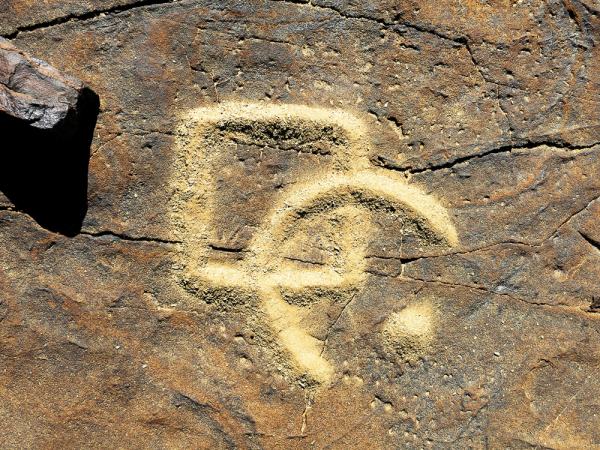
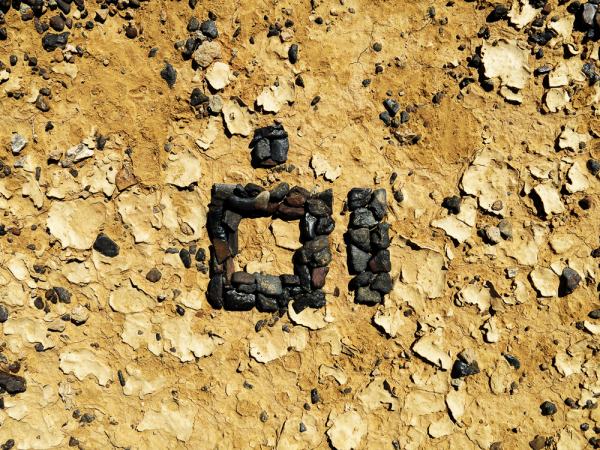
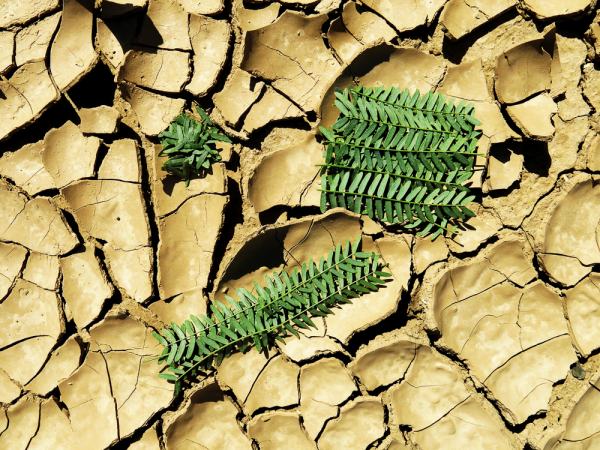
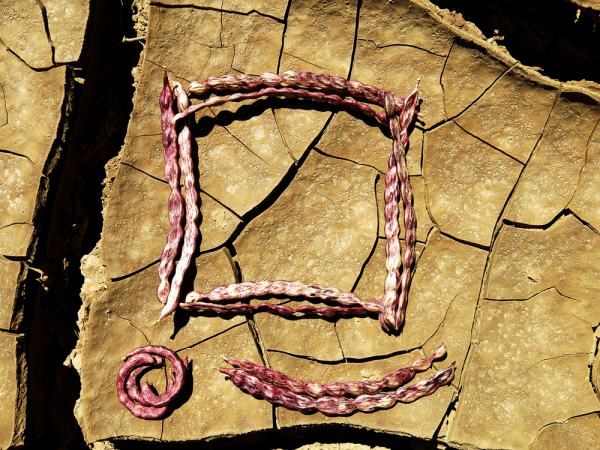
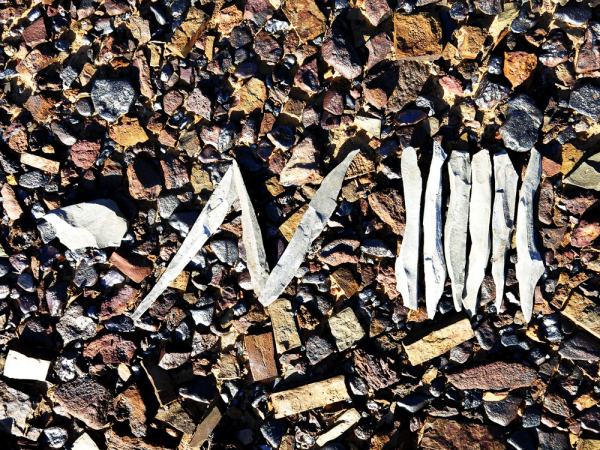
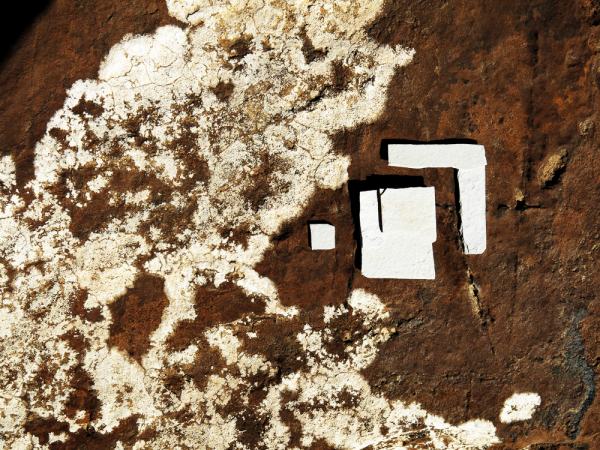
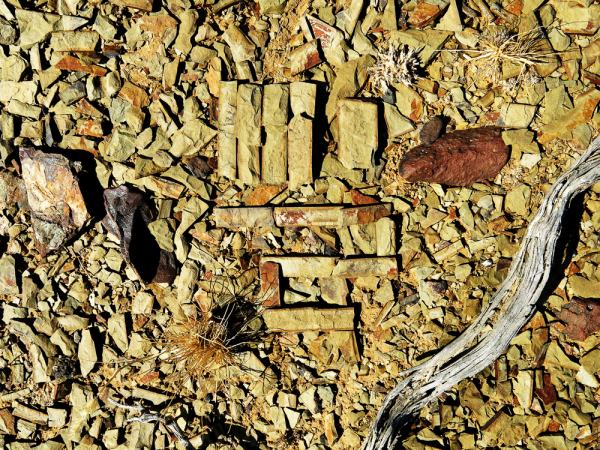
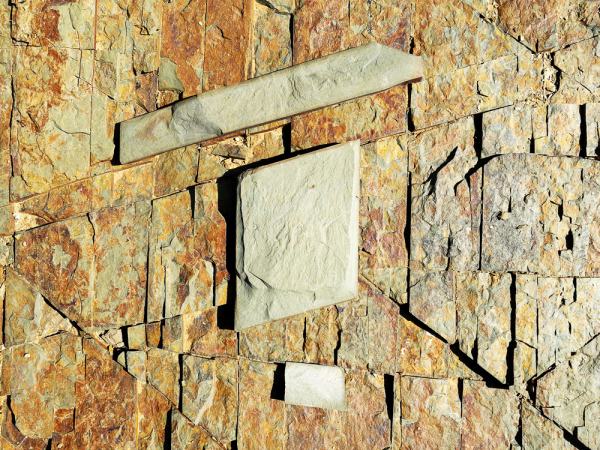
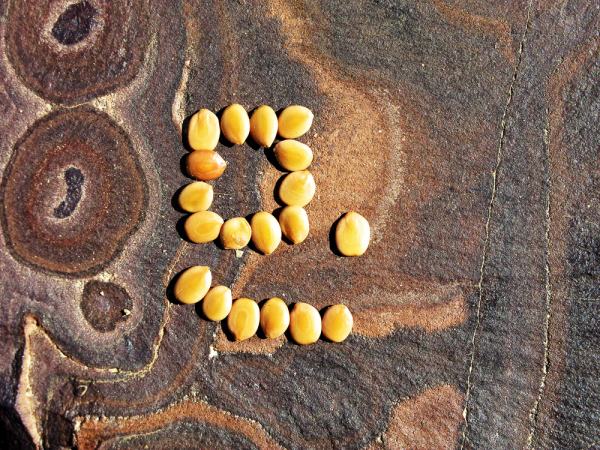
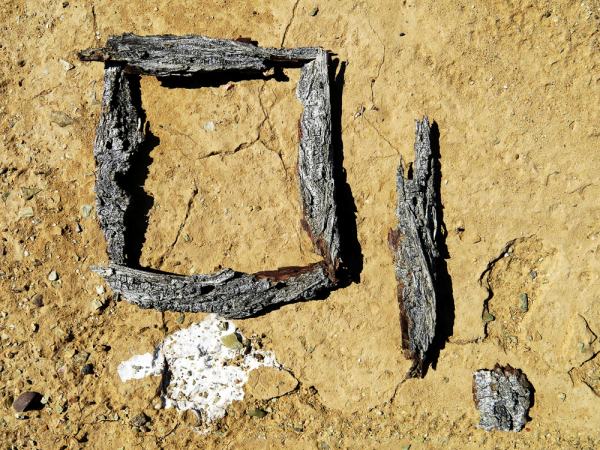
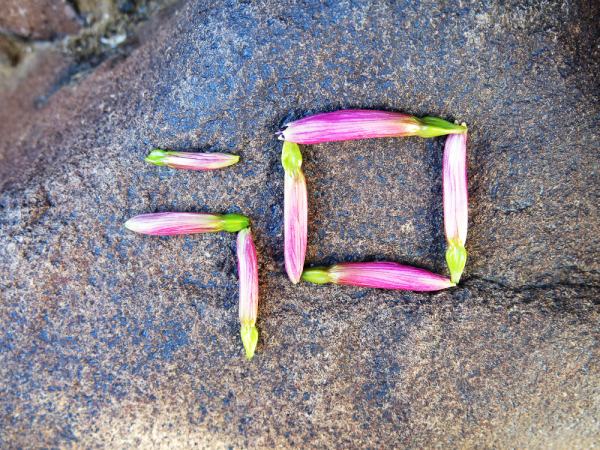
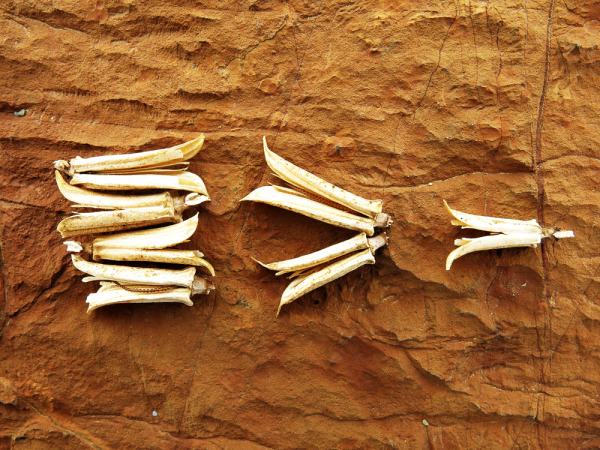
Elparo
France
“Ten days in the Tankwa desert to experiment with a new way to create, mindful and conscious of nature. No bigger than the palm of your hand, made from a square, a line and a dot, with materials found at a maximum of 30 meters from the spot he worked on, 50 patterns are hidden in this landscape.
The only one rule for a visitor, if you find one of these patterns, please remove this temporary installation.”
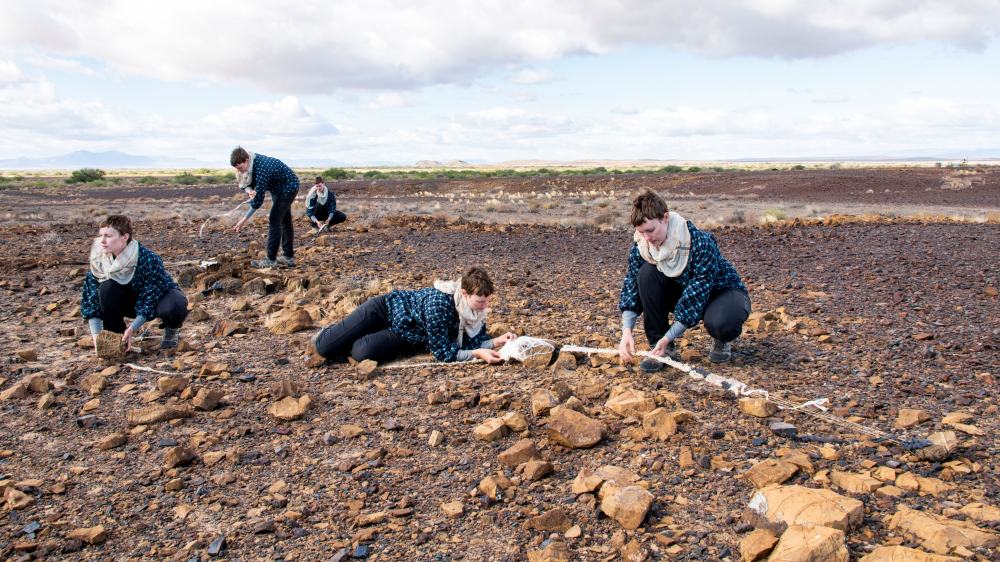
Gina Van der Ploeg
South Africa
“Dressing a rock loom in the wind”
I thought a lot about the horizontal plane, about the contrast between a horizontal human-nature-spirit relationship and a vertical god-human relationship. The Tankwa is a seemingly endless expanse that resists the vertical, if you want to survive, you must stay near to the ground, out of the wind, hugging a rock for shade. I also thought a lot about how experiencing things on a horizontal plane undermines how we generally move, stride, and stand as humans.
Spending time outside every day was a challenge and a blessing. I used so much suncream and my eyes were constantly stinging. I was not made for this landscape and so I weaved and weaved among the rocks and then bundled it into something I can hold and remove, leaving nothing behind.
Inga Somdyala
South Africa
“4 x 4 Crop”
Along with my initial proposition to break ground and bury several cuts of canvas throughout the Tankwa Karoo, I also wanted to capture something like a catalogue using the geological variety of shapes and colours in the landscape.
I arranged varying rock formations and sand colours against exposed or concealed areas on the veld, playing on the stark visual changes in the Karoo.
As my canvasses transcribe the land below ground, I imagine that this crop of the landscape can also read as its own archeological dig site; an investigation into the characteristics of the land itself.
Janet Botes
South Africa
“Remembrance & Resurrection” was my main focus during the time of my residency. An artwork in honour of the late Ian Marley who contributed to Tankwa Artscape in 2021. I was privileged to be lectured by Ian, in drawing, as an art student 10 years ago and his influence during my education still resonates in much of my work today.
Using “Echo of the Desert” by Akunzo (2019) as a platform this piece journeys through Death, Grief and Resurrection through the Legacy that one leaves in remembrance when all else is forgotten.
Alongside this work I continued with the ever-developing “Tankwa Runes” that echo, reflect and draw out the symbolism of the unique place and its impact on people.
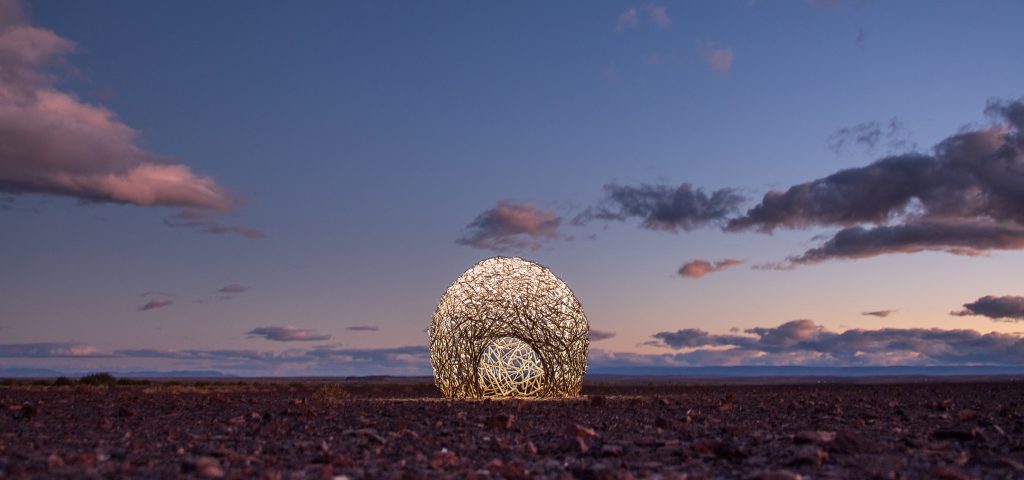
Jette Mellgren & Jan Johannsen
Denmark
“IFUKU”
Searching for shelter in the thirsty land of Tankwa desert South-Africa we built a IFUKU – a nesting and revitalizing place. Using dry sun bleached branches the shelter blends into the beautiful scenery of sand and stones.
Kwasukasukela Arts Collective
(South Africa)
“The concept of uhamiaji (‘migration’ in Kiswahili) is to highlight the migrations of human artistic consciousness which has often subverted and revolted against the status quo. The act of engaging with the force of indigenous arts through sound, illustration, ceramics and movement has allowed centuries of information by ancient diverse cultures to pass through us ( the mover, the maker, the medium of vibrations). And thus uhamiaji portrays and is the resistance of our ancestors against our current states of dogma. The broader concept of uhamiaji seeks to create site specific art and/or ritual practices aka performances that highlight the historical phenomena of migration. Uhamiaji uses the consciousness from spaces of human meeting such as the Tankwa Karoo to consciously acknowledge how our ancestors found points of meeting and tension in the geography of precolonial Africa. The motif of the desert is a site of migration/movement /life and an intersection to centralise the idea of community and healing, because our ancient San and Khoi ancestors connected with the medicine of the desert. That which looks empty is full with the right knowledge and outlook.”
Lara Kirsten
South Africa
The Stones Re-Mind Us
Meditation / Poem / Dance
I had a vision to present something interactive – where I use as many of my fellow-artists as conduits and anchors for me and each other. The piece started off with a meditation. I wanted to find quiet centering for all of us – Tankwa stones weighing on the head, heart and tummy space earthing each of us.
Another very important aim was to reconnect with my poetry. Throughout the week prior to the performance I tussled with the creative word. I came up with the idea to have everyone in our group write down their favourite word/phrase in any language. I used the 23 words to compose the poem – this was as collaborative and site-specific as I could get. The languages of the words included English, isiXhosa, Afrikaans, Danish, Spanish and isiZulu. Poem entitled “We heed the call”.
The last part was the spontaneous unrehearsed part of the piece – a dance unfolded holding a stone in my hands and letting it guide my body where to go. A surprising element was that the stone eventually led me to draw with it on the earth in a highly energised encircling of my audience; also bringing to mind that “We do not write poetry / Poetry writes us”.
WIRED / DRAADWERK
This was a spontaneous bodily interaction with a stray piece of fence and fence post.
The first idea that sprang up from spotting these pieces was ”draadwerk” – Afrikaans idiom for complexity. (literal translation = Wire-work)
From the start of the residency there has been a keen awareness of ownership of land, territories, feeling both at home and alien on this startling piece of land. Who dares to claim land? I do not believe in ownership of land, so this physical tussle with the fencing went beyond mere symbol. Another deep need unfolded with the grappling with the wire – facing the creative struggle, confronted with control versus freedom, anxiety versus free flow. Strange, but welcome were the feelings that suffused me afterwards – release, satisfaction, belonging.
Leli Hoch
South Africa
“Hope is an embrace of the unknown and the unknowable, an alternative to the certainty of both optimists and pessimists. Optimists think it will all be fine without our involvement; pessimists adopt the opposite position; both excuse themselves from acting. It is the belief that what we do matters even though how and when it may matter, who and what it may impact, are not things we can know beforehand.” Rebecca Solnit
Nkosenathi Koela
Kwasukasukela Arts Collective
(South Africa)
iZilo ZeNtlango
With these Inidgenous sound Totems I explore the connection between sound and the desert. I wanted to understand the sound of the land of my San bloodline.
Thus I decided to build animal spirit totems, made from the bones of the land, that would connect with the sound of the spirits of that land. With my ear’s eyes I heard chimes, made from bones and steel. These totems would be activated by uMoya ( wind and spirit) to sing into the land and say, I see you still!. I remember and we are looking. Death is not our end.
This would be the spirit of uhamiaji, the transmigrations of desert animal and plant life remembered and activated through wind, song, and clashes of percussion.
Nkuthazo Alexis Dyalvane
Kwasukasukela Arts Collective
(South Africa)
‘A spirit Goes’ Tankwa Artscape offering.
As an interdisciplinary artist exploring moments of energy transmutation or dimensional migration – My offering sort to symbolise life’s layers – those bodies prematurely claimed along their energized pathways. Focusing on a migratory channel across the Karoo’s arid Tankwa strip in the context of ‘hindrances’ set up by proprietary fencing, agricultural assassination for industry demands of sacred creatures to the Nama, Koran, Griqua, Khoimani and other nomadic indigenous peoples who spoke up a divine and crucial balance (still do, often under repressed and oppressed conditions).
As well as to the energy of stock farmed animals, representing stagnation of this channels flow with overgrazing and finally our desperate attempts to resurrect a tired dust swirled spirit that roams and hovers above river beds having perished, caught in greedy barbs, hooks and malice- our transgressions as much as it is our migration into “progress” or chaos, it too is symbolic of our spiritual decay. Indalo- as great keeper of alignment on our journey is true to her work within us…to her spirit goes.
Photos & videos by: Bronwen Trupp, Frank Krummacher, Josie Borain, Leli Hoch, Lyn Mossop, and the artists

